Taiwan
Few countries are as politically contentious, controversial and contested as the island of Taiwan. An unagitated, ultra-modern and open-minded corner of the world that attracts few tourists, but is considered by expats to be one of the most liveable places in Asia. Taiwan is not just Taipei 101 and a “somehow” Chinese country in East Asia. It is a true treasure trove of culture, progress, faith in the future, nature, cuisine and tradition. A country on constant alert, where the cities are underpinned by bunkers and military airplanes criss-cross the skies. And at the same time one of the safest places you can find.
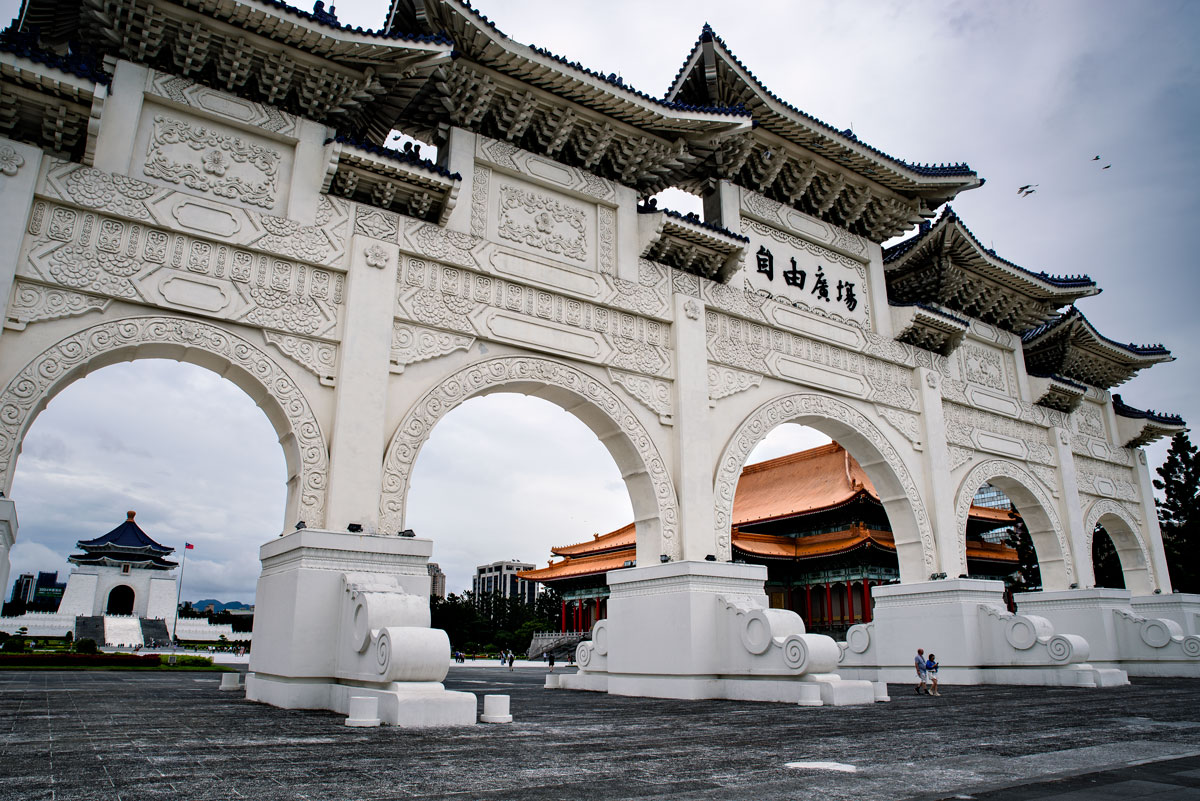
The train takes us from the airport to the center of Taipei. Passing hills overgrown with vegetation, industrial zones and boring suburbs, we are thrown right into the middle of this Asian city, which seems so clean and tidy. But it’s not just Taipei that welcomes us, but also the big geopolitics and history of the country.
After checking into the hotel, we enjoy the hustle and bustle in the nearby “228 Peace Memorial Park”, one of the most historic places in the city, which played a key role in the democratization of the country. The artist Panai Kusui has barricaded herself in a self-built shed. It is a protest action for the return of illegally confiscated land from the indigenous population by the government. She will have left her camp on our last day in Taipei – her campaign ended when the new government took office.
As a formation of military jets roars overhead, we follow the sounds of archaic rock music. A stage has been set up at the Presidential Office Building. Bands and cameramen are rehearsing for the big performance after the weekend: Lai Ching-te will take office as president. The world is looking forward to this day – mainland China is rattling its sabres and showing its sharp teeth.
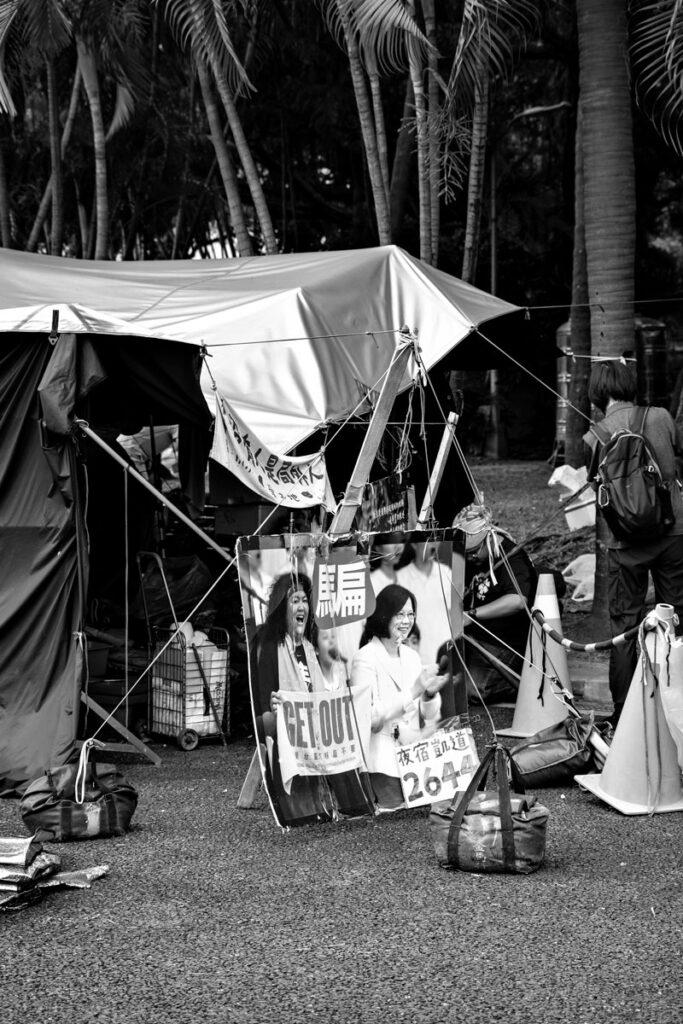
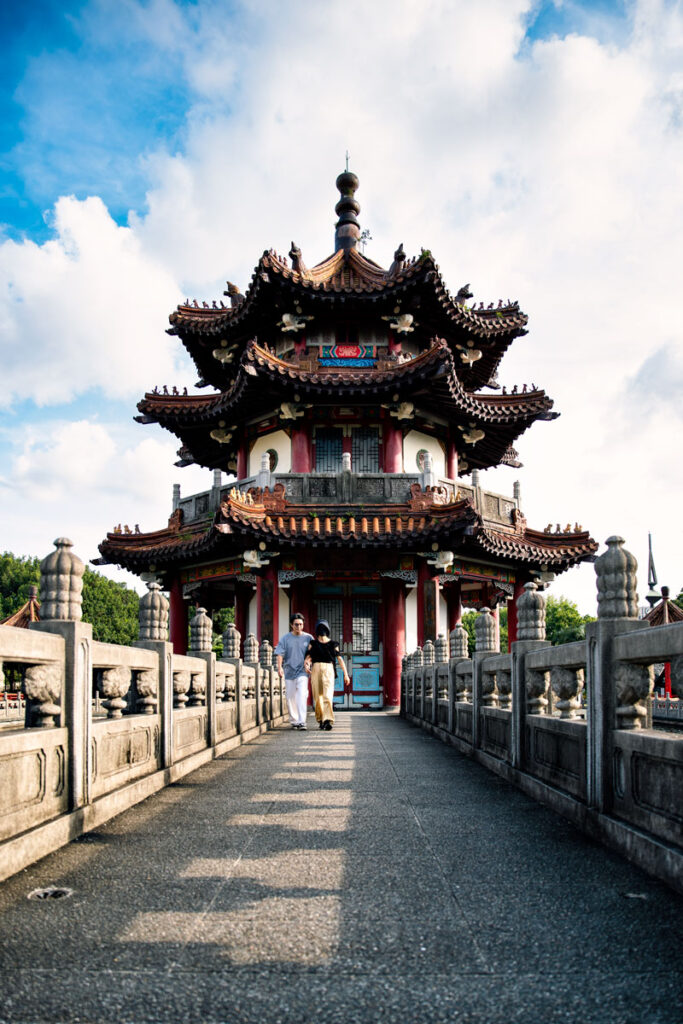
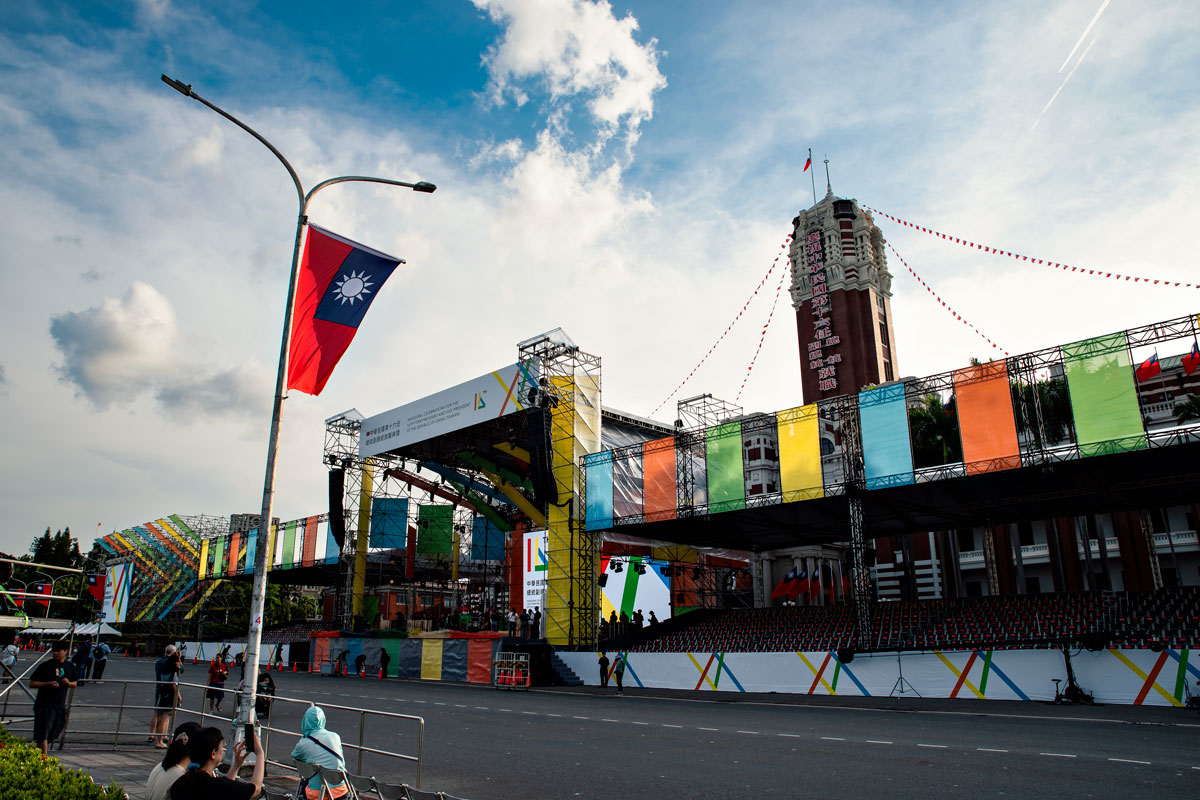
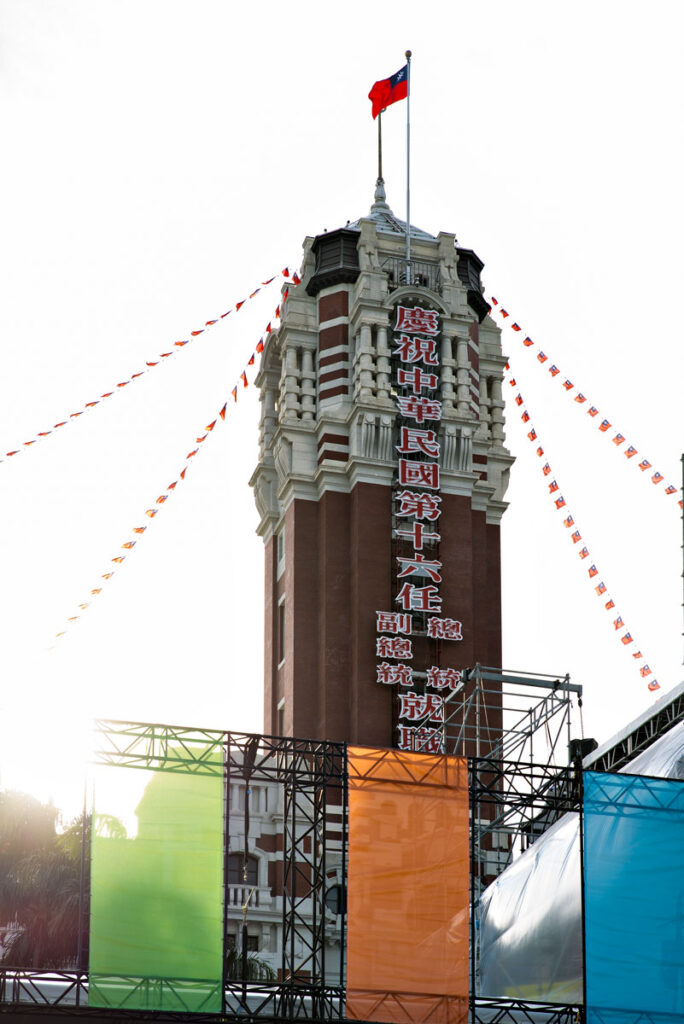
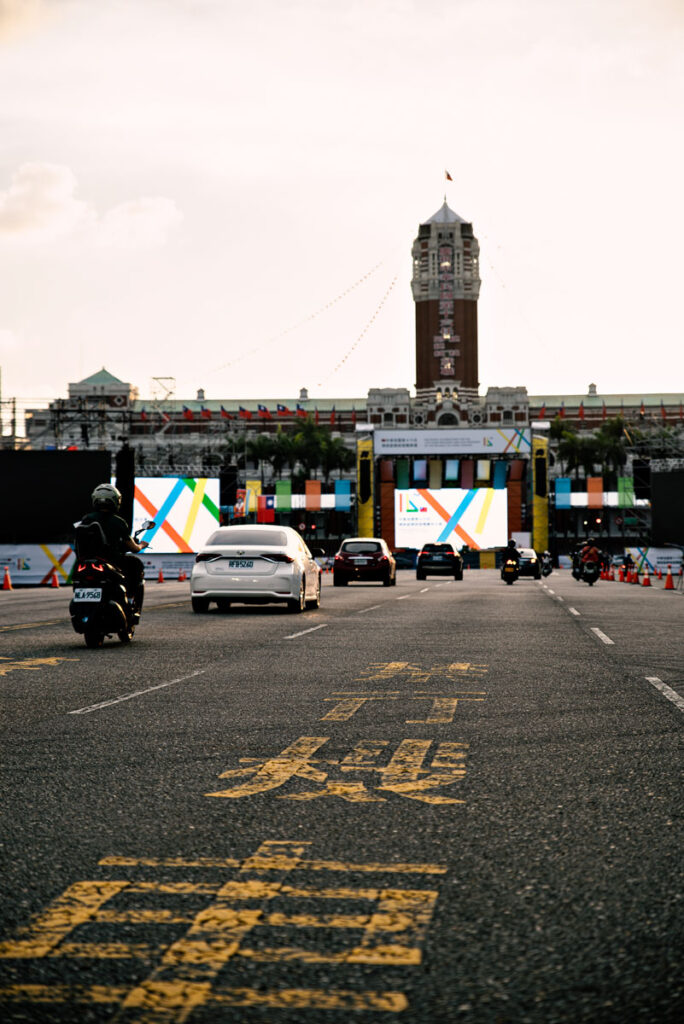
This capital city pleases wherever it can. Scooters don’t swarm the streets like in Bangkok or Hanoi, but drive in designated lanes – orderly and regulated. The public toilets are clean and free of charge. There are well-equipped baby changing facilities and great playgrounds and sports fields. Almost no garbage on the streets. Society is open: in 2019, Taiwan became the first Asian country to legalize gay marriage. The education system is outstanding, there is excellent healthcare and virtually no crime.
It is difficult to classify Taipei in the list of Asian cities we have already visited. The food culture is reminiscent of Bangkok. The general setting is reminiscent of Hong Kong. The state of the city is reminiscent of Singapore. Taipei is simply unique and, for us, combines the best of Asia.
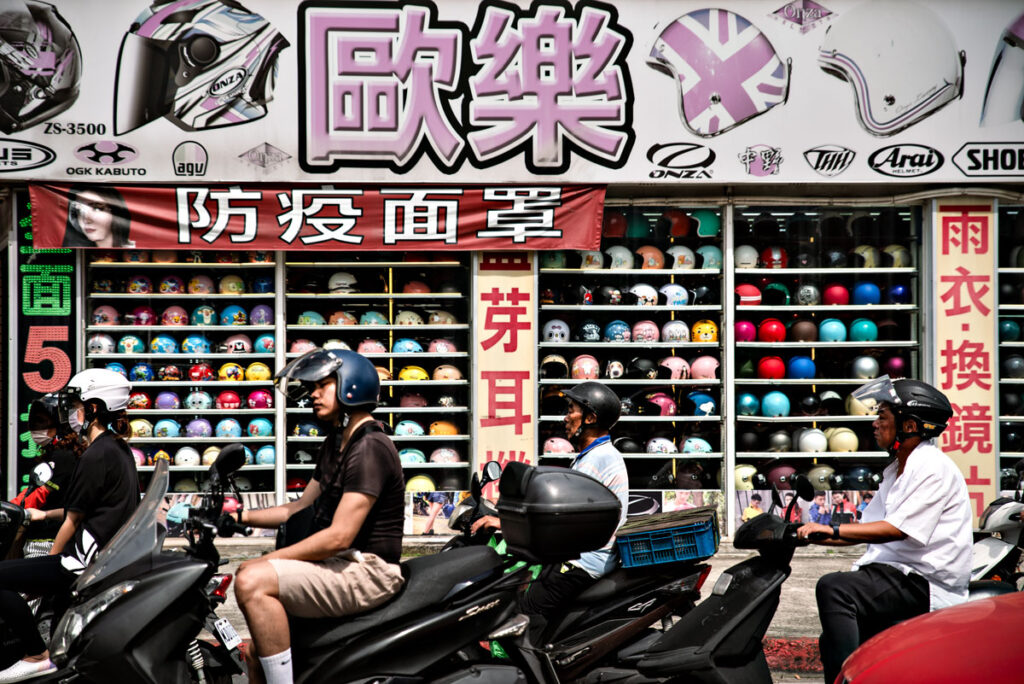
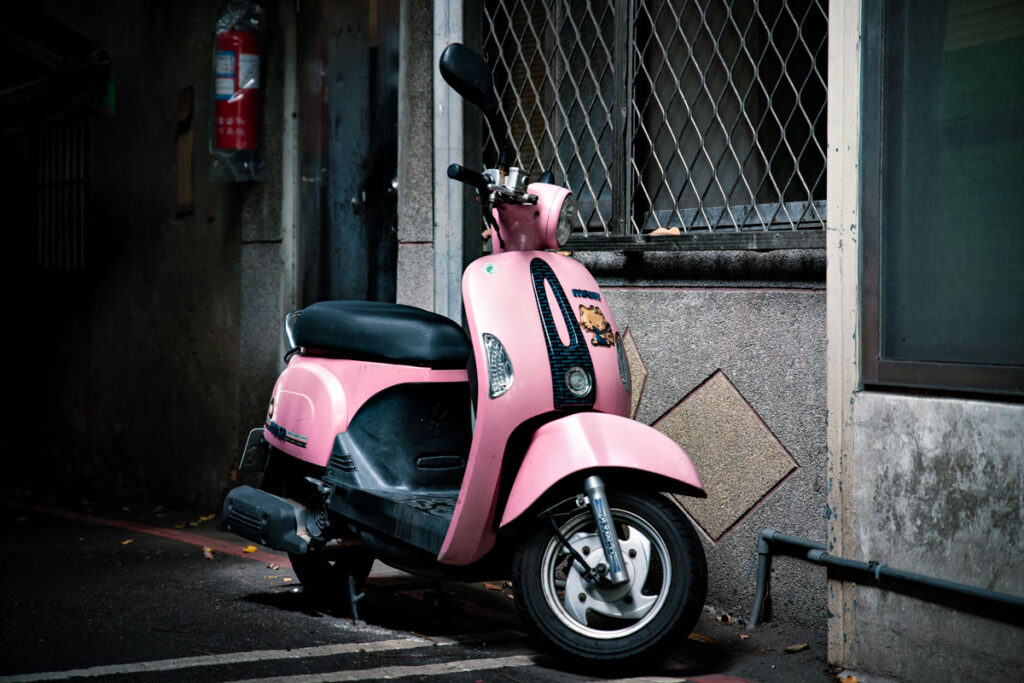
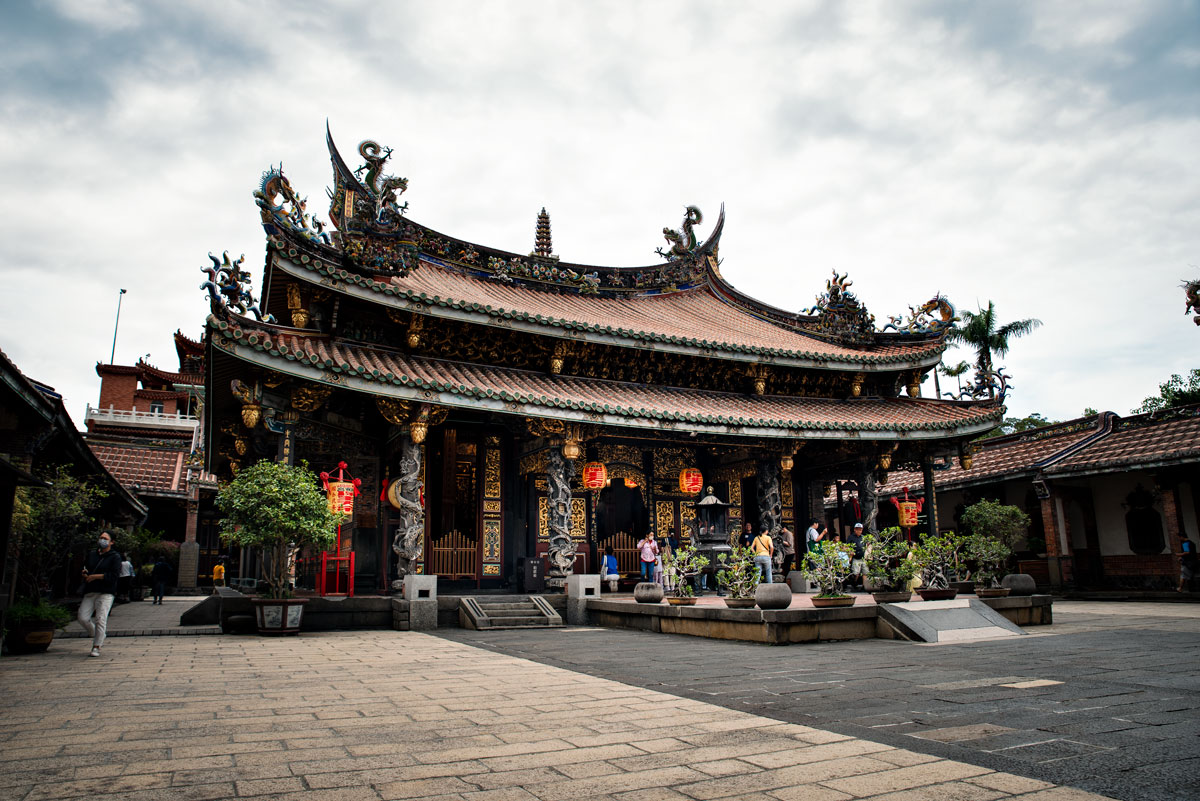
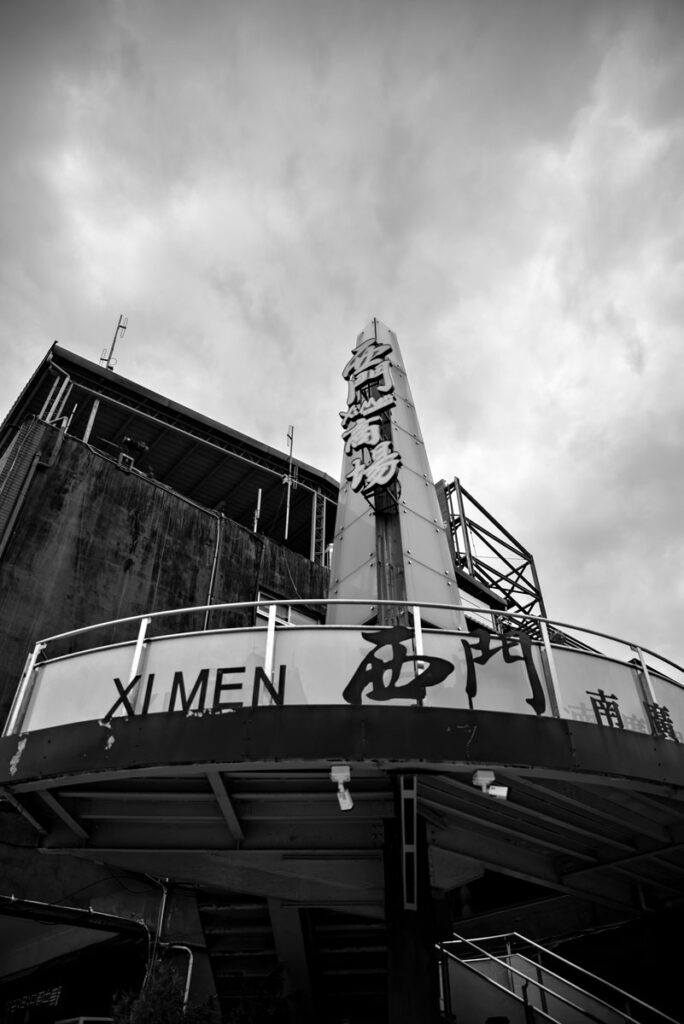
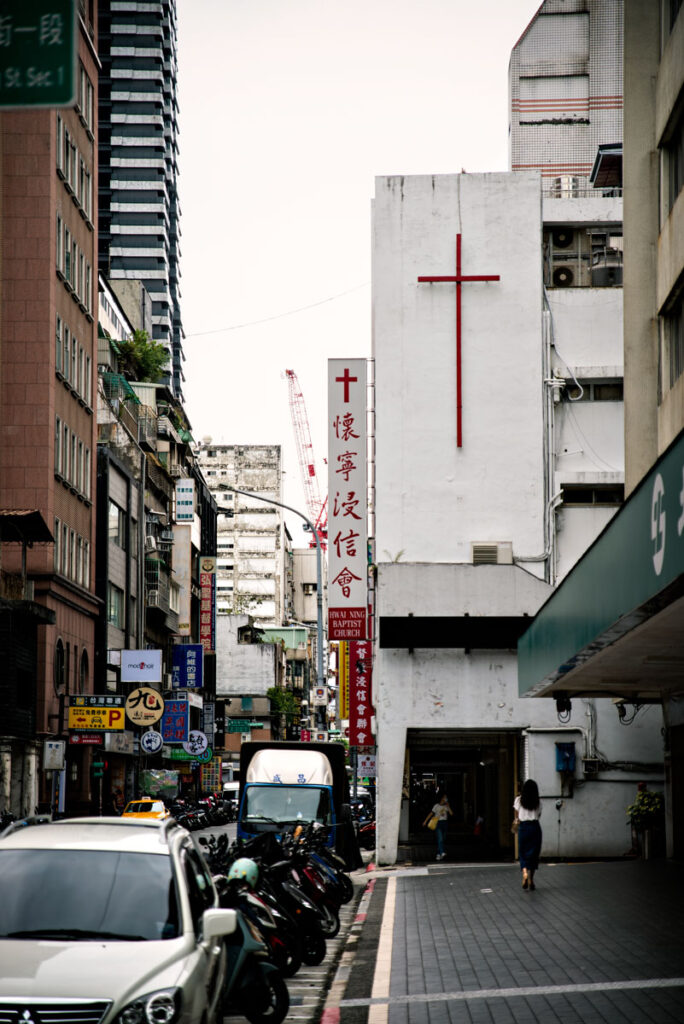
The temples surprise us with their all-encompassing welcoming culture. There is no dress code, no taboos. The air is filled with the smoke of incense sticks and the burning of spirit money. Fruit, cookies and flowers are offered to the gods. Dragons and tigers watch over the mortals. As is so often the case in Asia, the boundaries of spirituality are blurred: Buddhism, animism, Hinduism and Taoism coexist peacefully, mingle and become one.
We particularly like the Dalongdong Baoan Temple in northern Taipei. There are not many visitors here on this Sunday afternoon. The temple is located in the flight path of the city airport. Landing planes regularly fly over our heads. Despite this, the atmosphere is contemplative and pleasant. We sit down on a platform and watch the worshippers praying and seeking advice.
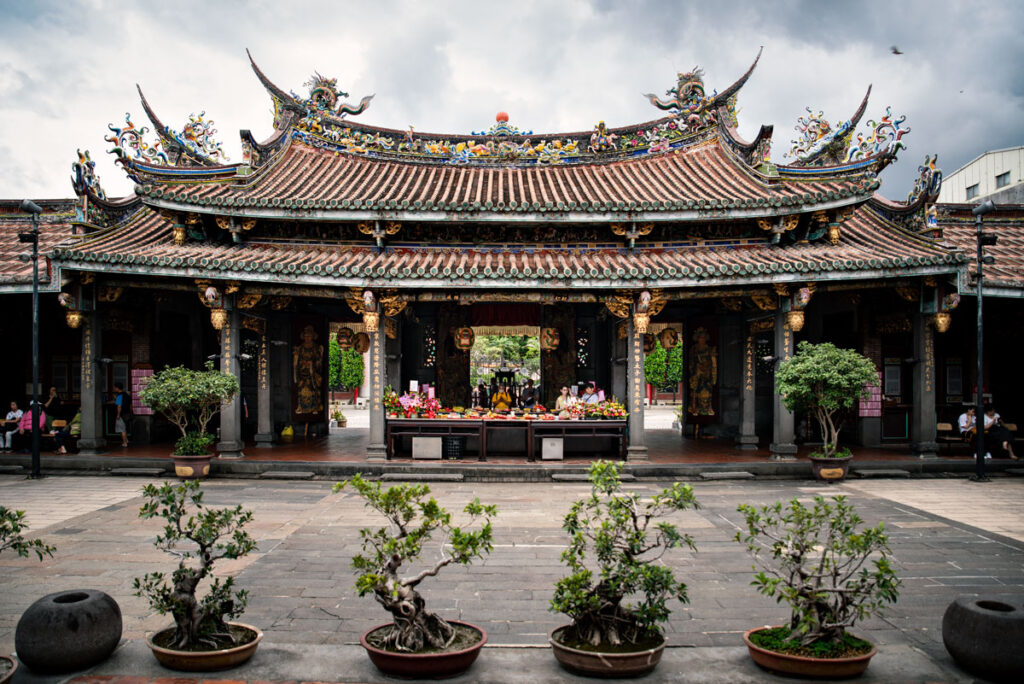
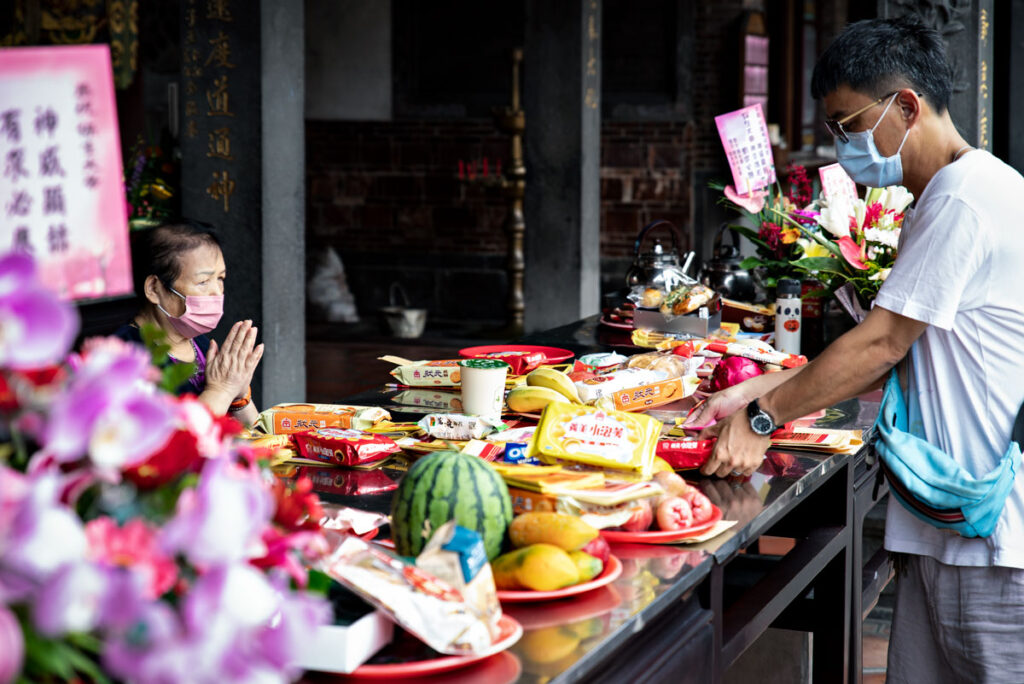
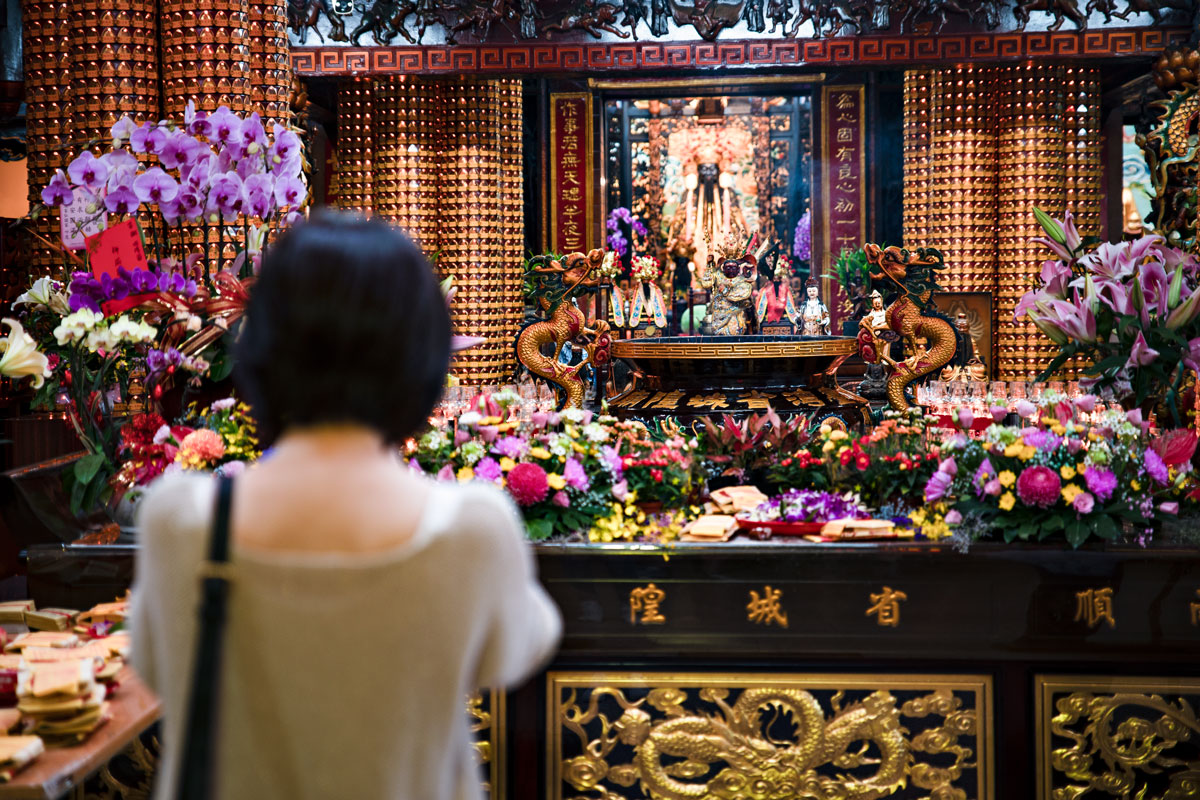
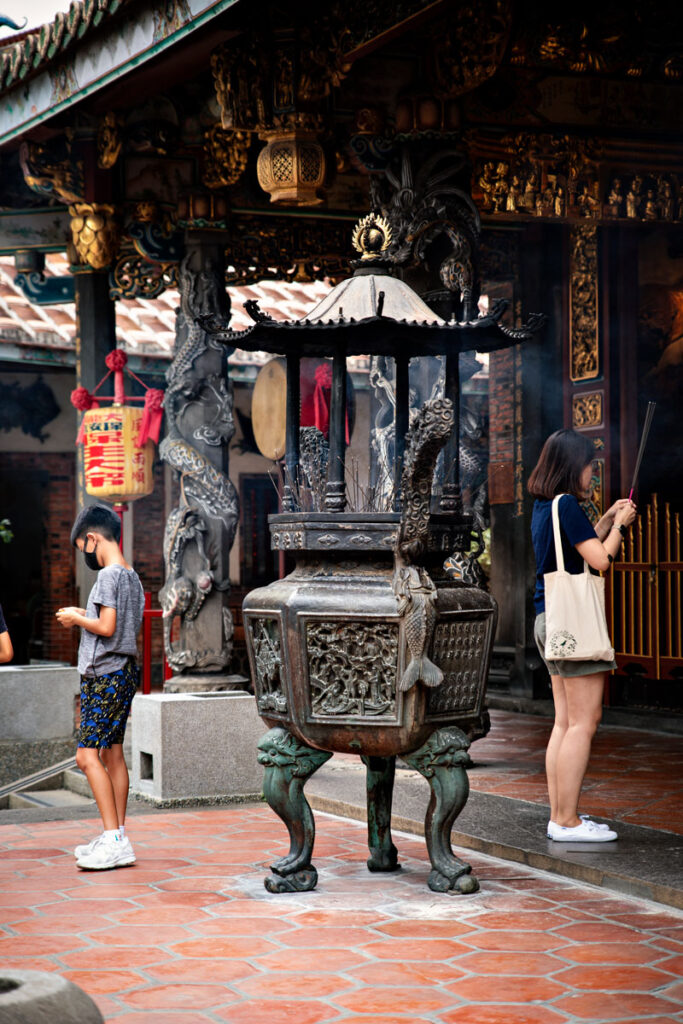
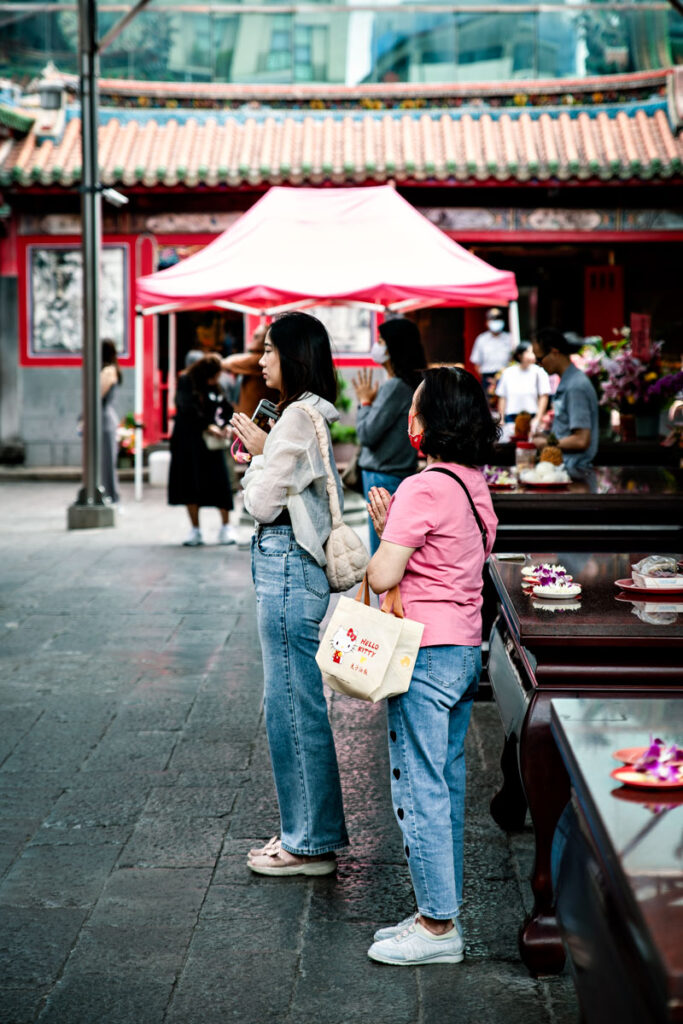
The day of the new president’s inauguration has arrived. The streets of the capital are filled with people – they have come from all over the country in large coaches. Columns of black limousines and police vehicles make their way through the hustle and bustle. Music blares from the loudspeakers, helicopters and fighter jets paint the colors of the Taiwanese flag in the air or drag gigantic flags behind them. Military transporters and water cannons. Taiwan is standing its ground.
A rain horse the size of a house with a colorful mane rolls across the streets. People dressed up as food, breakdancing and school bands. The government wants to be young, modern and diverse. The country wants to plunge into a self-determined future, grow and prosper.
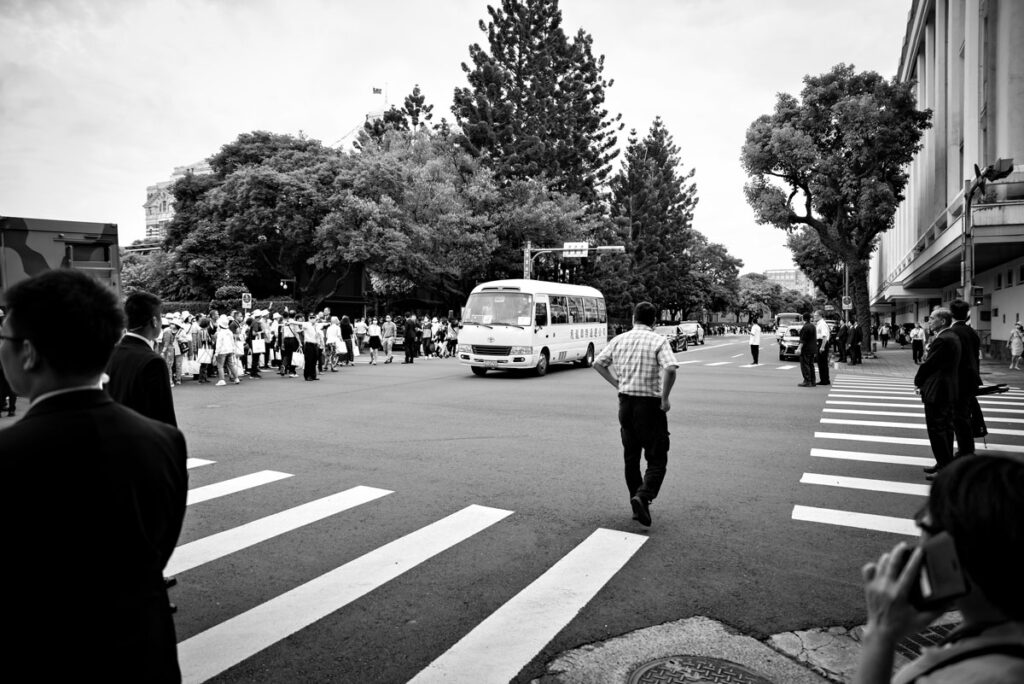
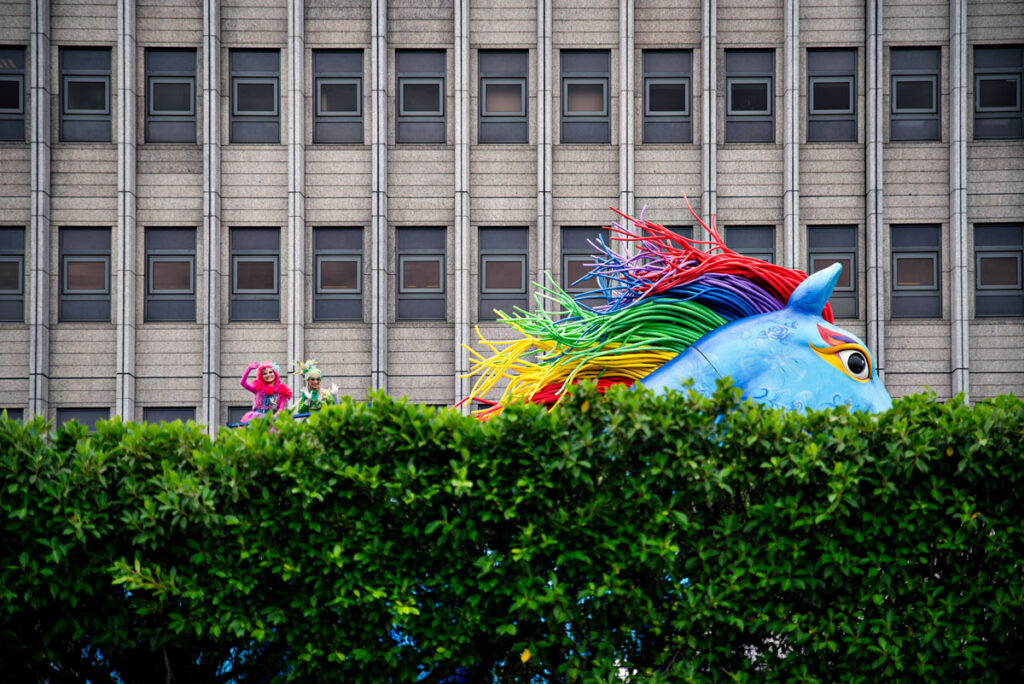
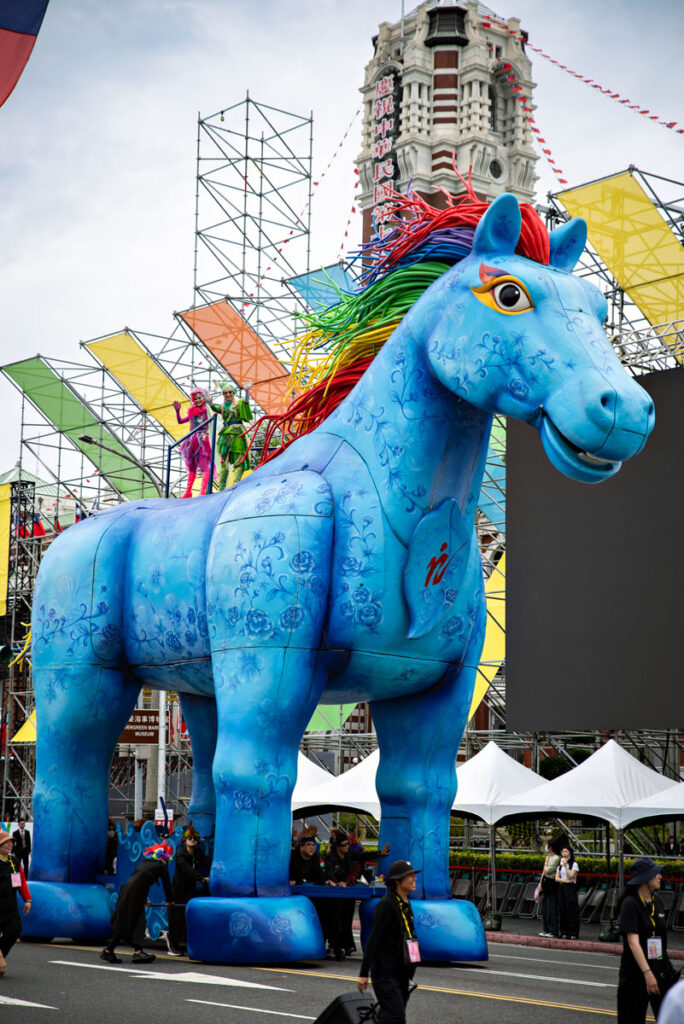
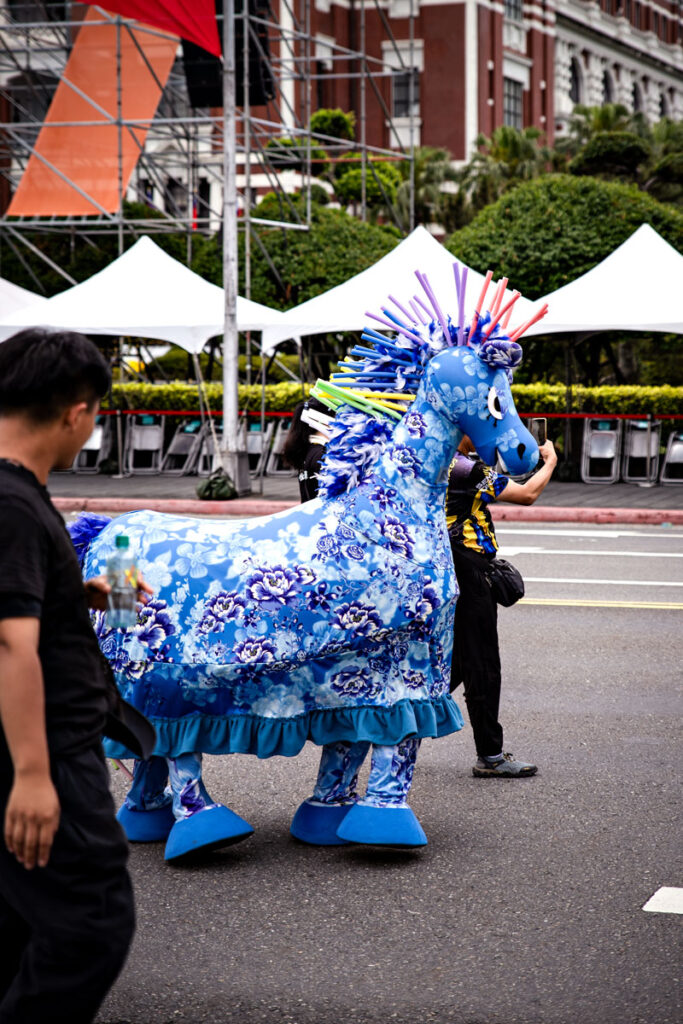
Mountains lie on the horizon, shrouded in clouds. Highways and the Tamsui River cut through the city. As the sun sets, golden light falls on the buildings before everything is bathed in dark blue.
Viewed from Taipei 101, once the tallest skyscraper in the world, we are in the middle of Taipei and at the same time so far away from the city. The moving cars below us, the people, shrunk to the size of fleas, and the small buildings – it’s all a miniature wonderland. We are enthralled for a moment, then the illusion catches up with us.
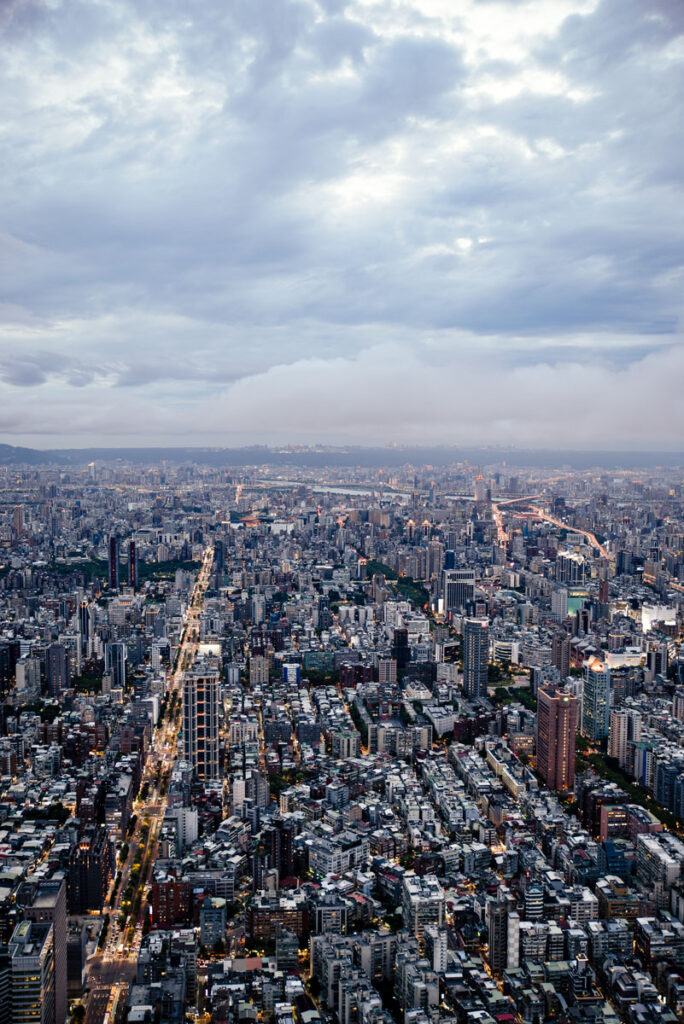
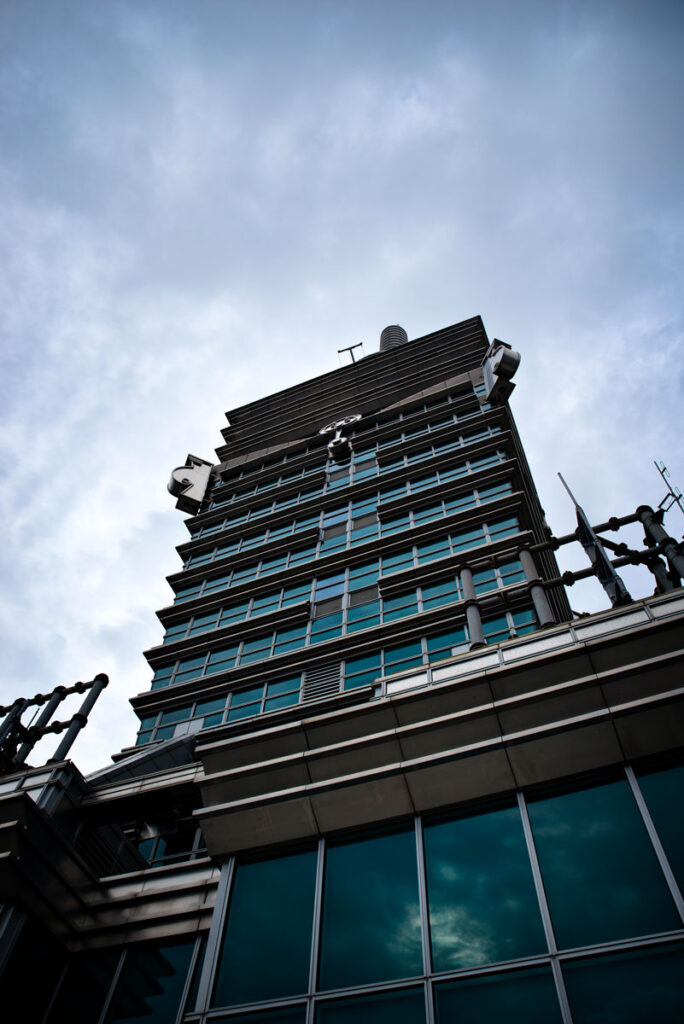
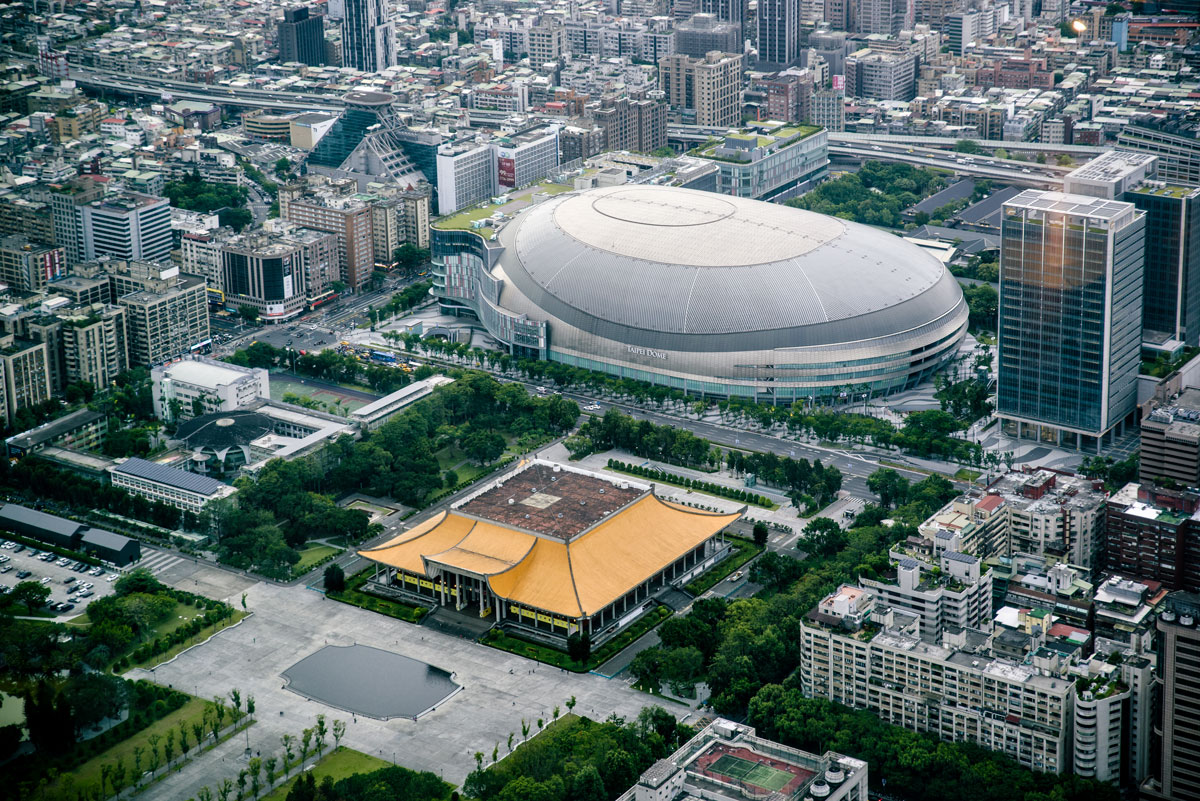
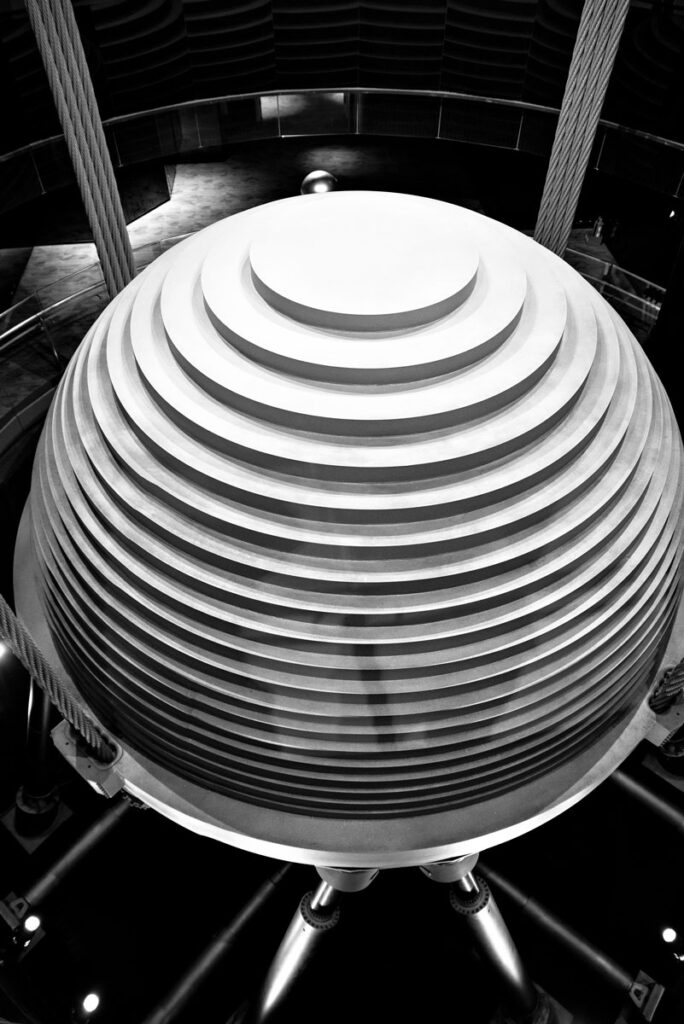
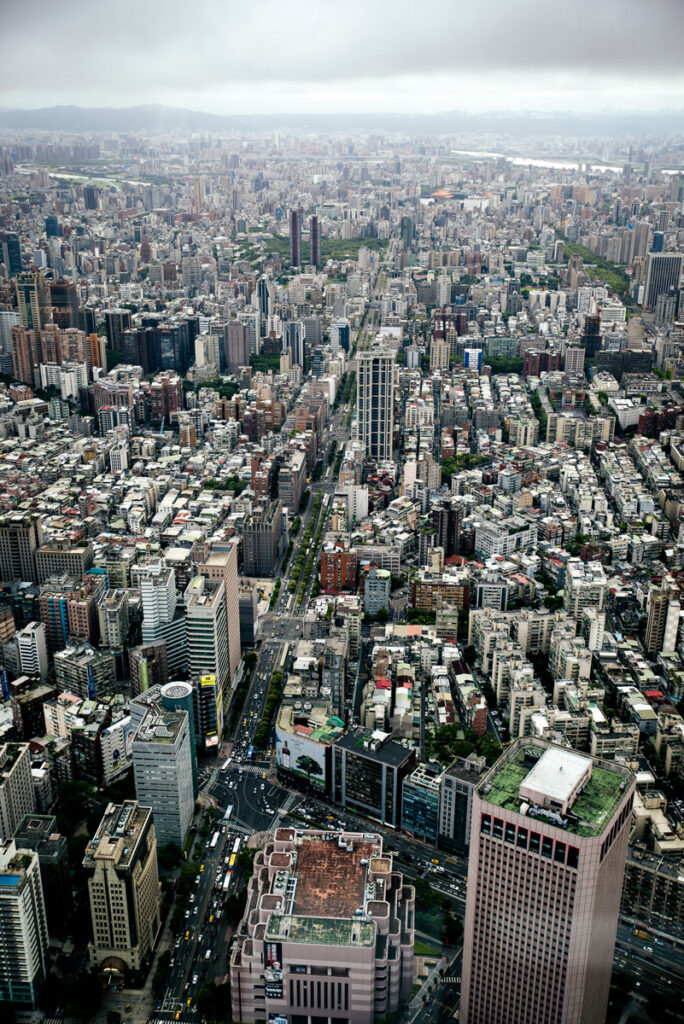
A different perspective – a different city? We have to fight for the panorama from Elephant Hill. A short but steep climb leads up the overgrown hill on the outskirts of Taipei. The viewing platform is packed with people who are paying more attention to their smartphone screens than the impressive skyline. This city shines golden in the falling darkness. A black, gloomy skyscraper – not yet finished – rises up next to all the other colorful and shining towers. If it weren’t for the numerous mosquitoes, we could marvel at Taipei from here for hours.
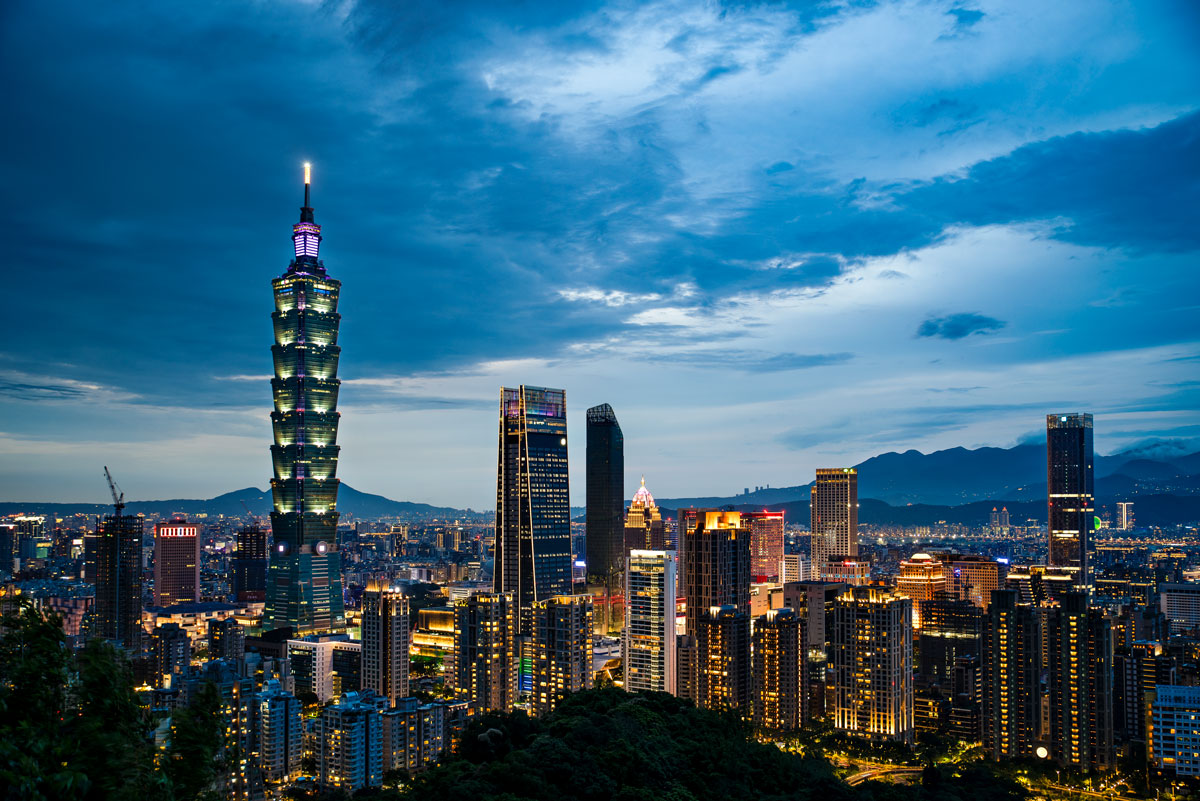
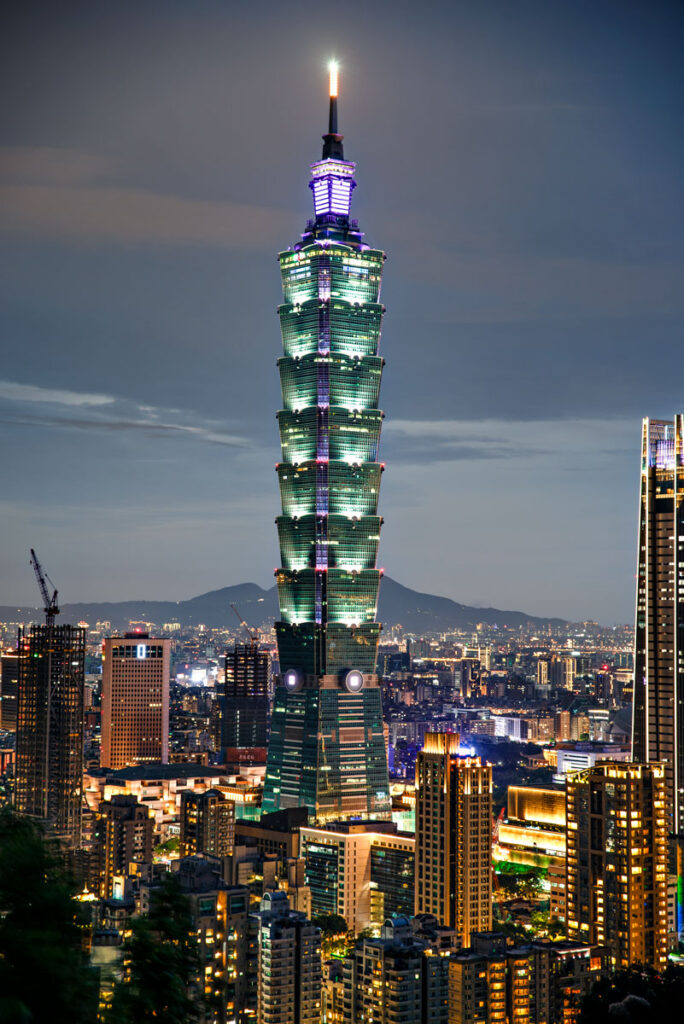
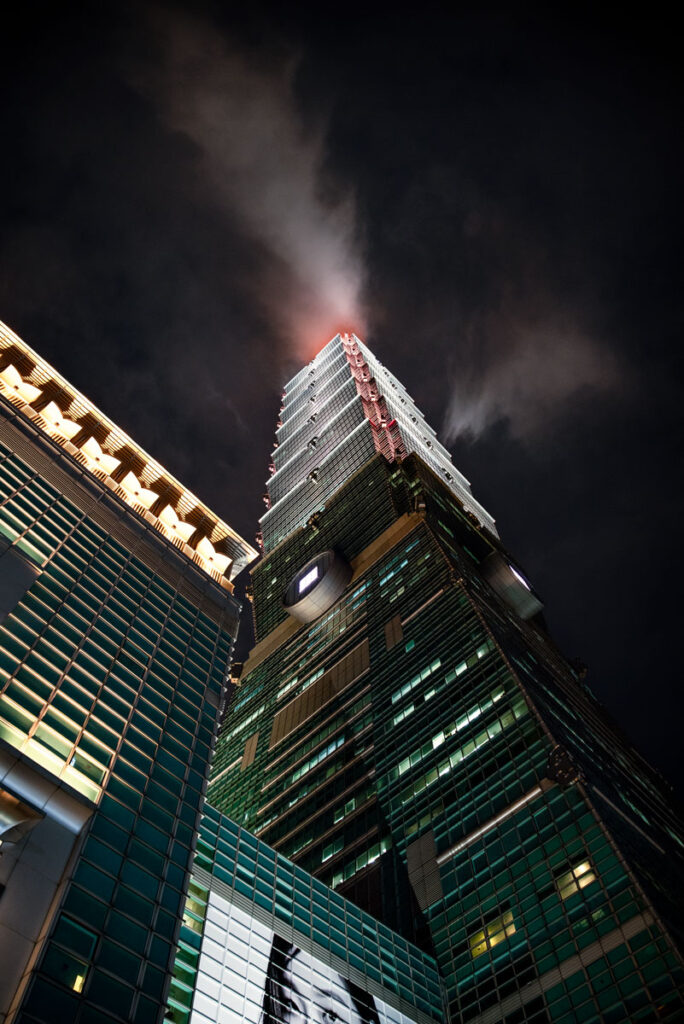
How does a country deal with its past when it has outgrown a dictatorship? It can glorify it, reappraise it in museums and history books, or it can gradually erase the past. Chiang Kai-Shek once founded Taiwan and ruled with an iron-fisted regime until his death. The airport, banknotes, statues, street names and the Chiang Kai-Shek Memorial Hall – in other words, everything reminiscent of the former dictator – have been renamed or removed.
A large, empty square in the middle of the capital now bears the name Liberty Square. In the evenings, runners do their laps here and young people meet in the well-lit corridors of the adjacent buildings to dance to their music. A historic place in the constant tug-of-war between power politics and symbolism.
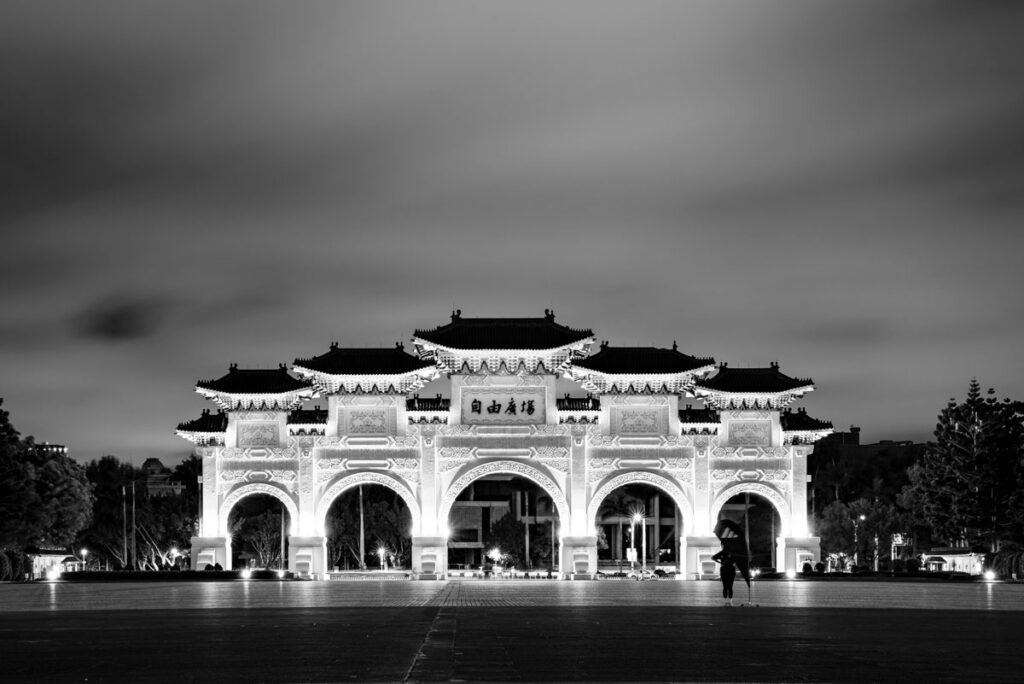
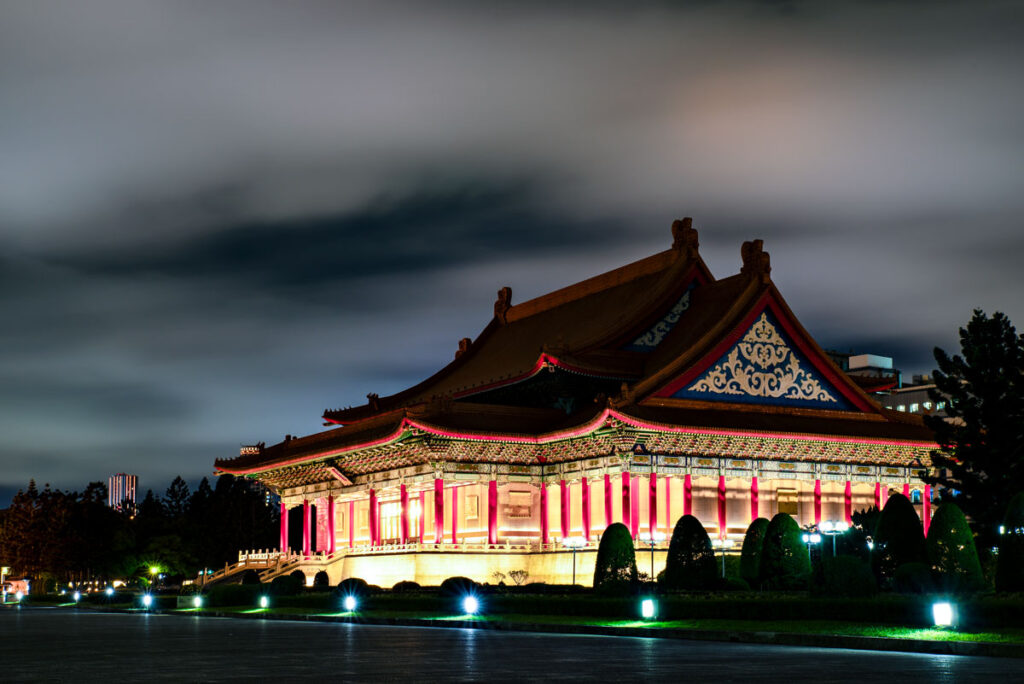
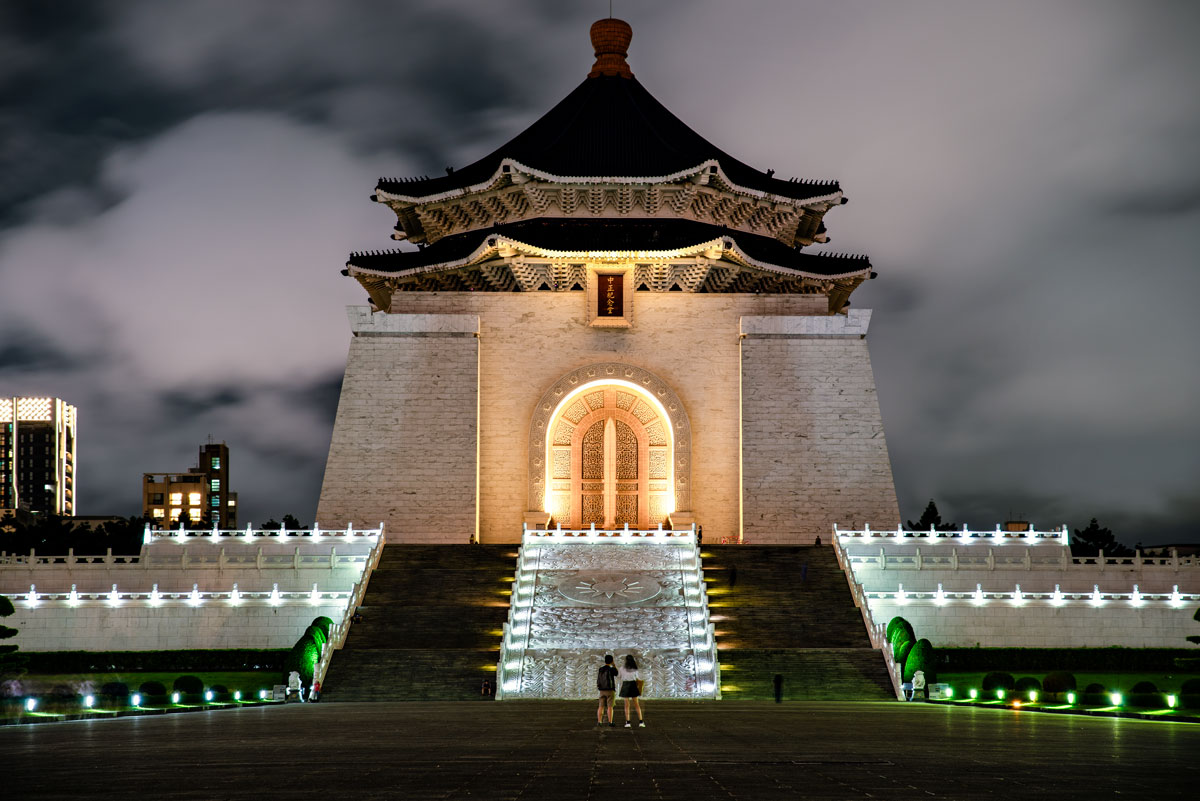
The brightly lit staircase of the National Theater. A mirrored subway passage. The rainbow-colored pedestrian crossing. At night, all these public spaces become stages for courageous young people who confront society in their own way. They do not want to destroy, but to build on what has already been created. The bodies of the young adults move almost perfectly to the hard beats from the small speakers. They sew costumes and apply make-up with inexhaustible attention to detail. With stubborn zeal, they stand up for a more open, peaceful world.
Nocturnal Taipei invites you to dream of the future together with its youth, while blanking out reality.
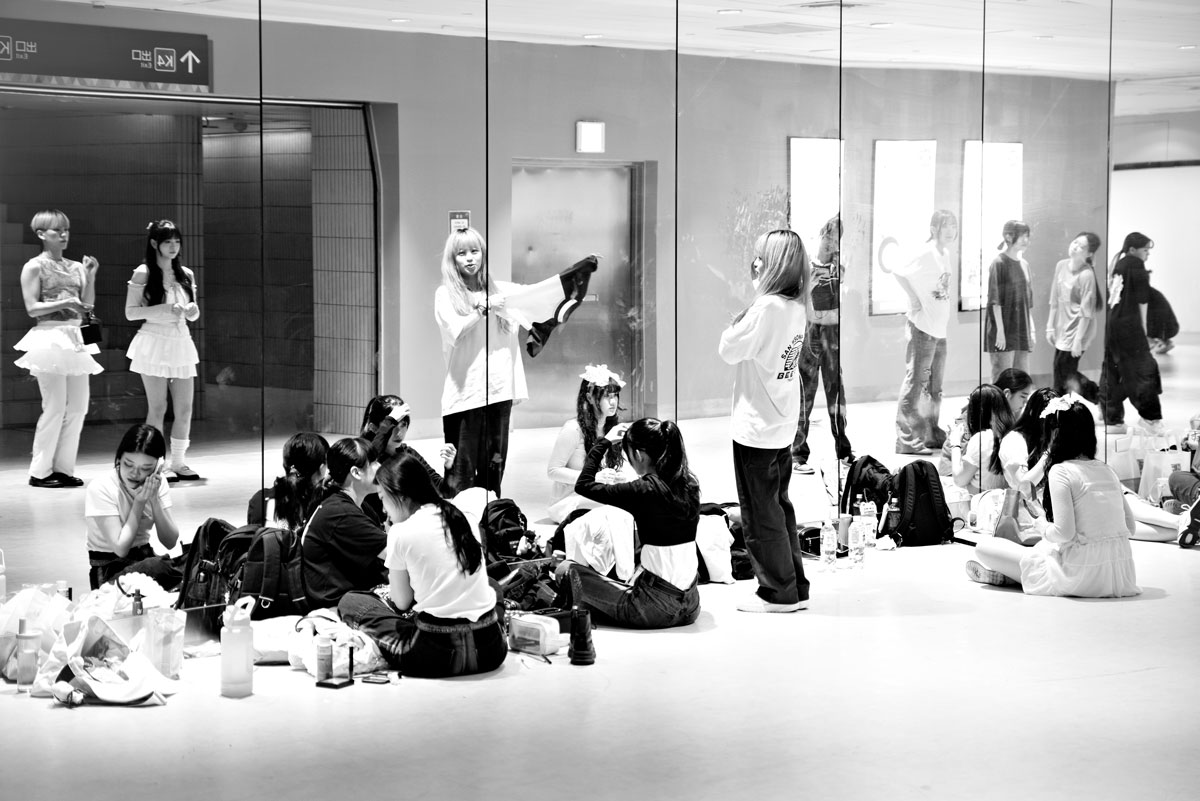
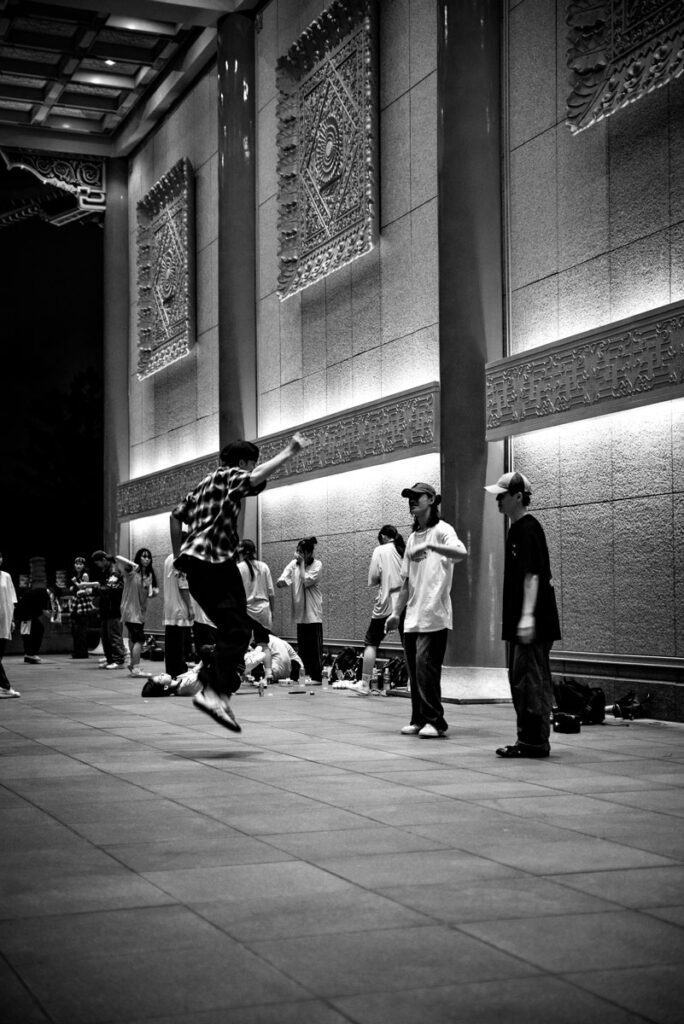
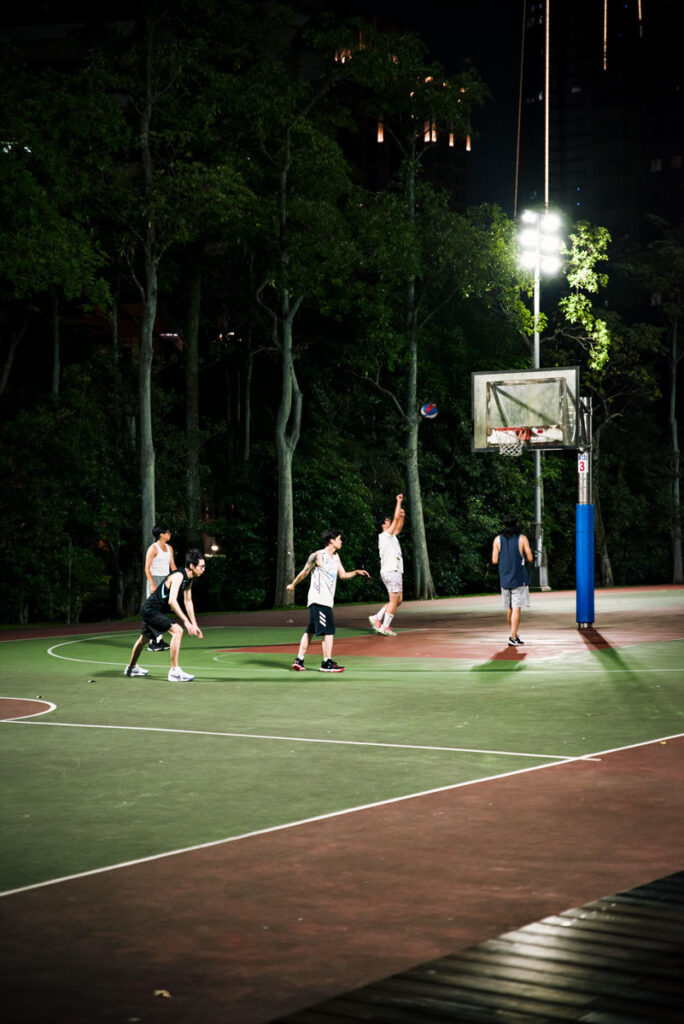
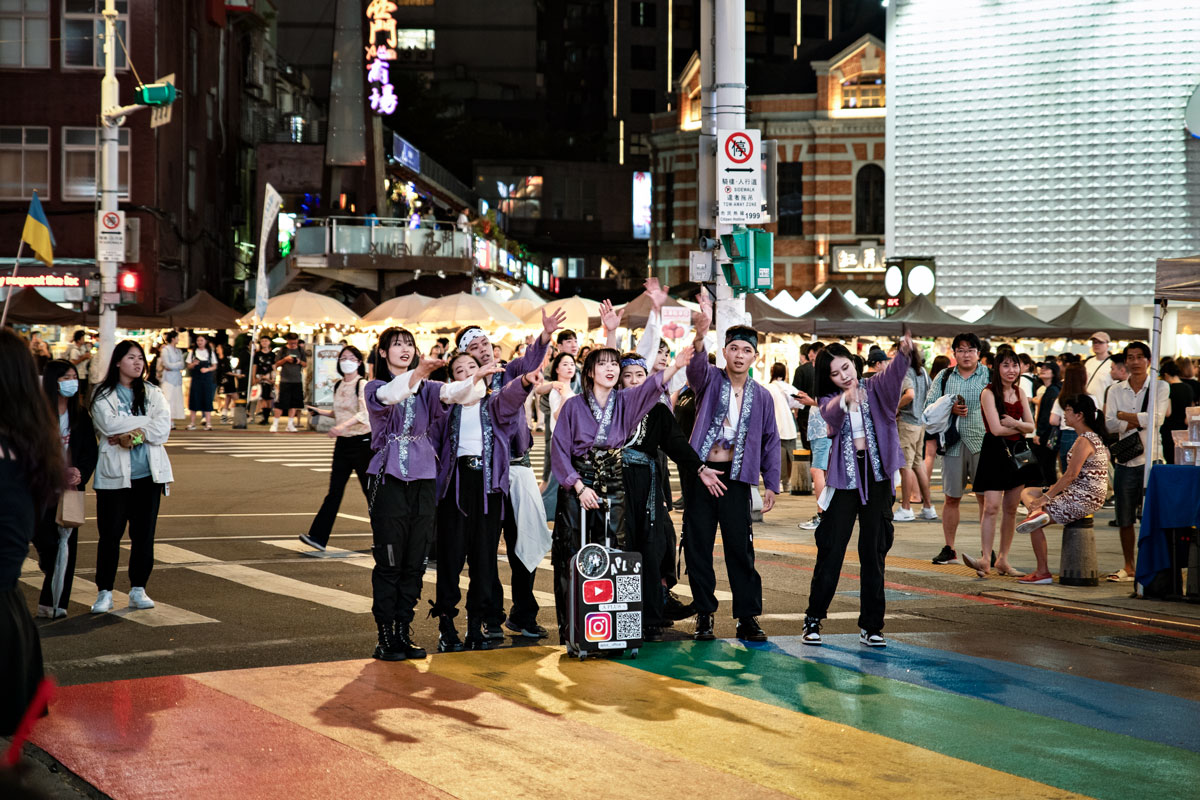
In the late afternoon, some roads are closed. Stores are set up, gas cylinders are connected, fruit and meat are cooled with ice until the first guests arrive. It steams from large pots, fat splatters from the woks, barbecue coals crackle. The air is filled with acrid smoke and the smell of all kinds of food. The night markets throughout Taiwan are well frequented and the best place to try as much as possible for as little money as possible. This is where the country once again shows its full openness – alongside Taiwanese and Chinese delicacies, there are Italian, Greek and even German-inspired dishes. It is not for nothing that Taiwanese cuisine is considered the best and most experimental in the world.
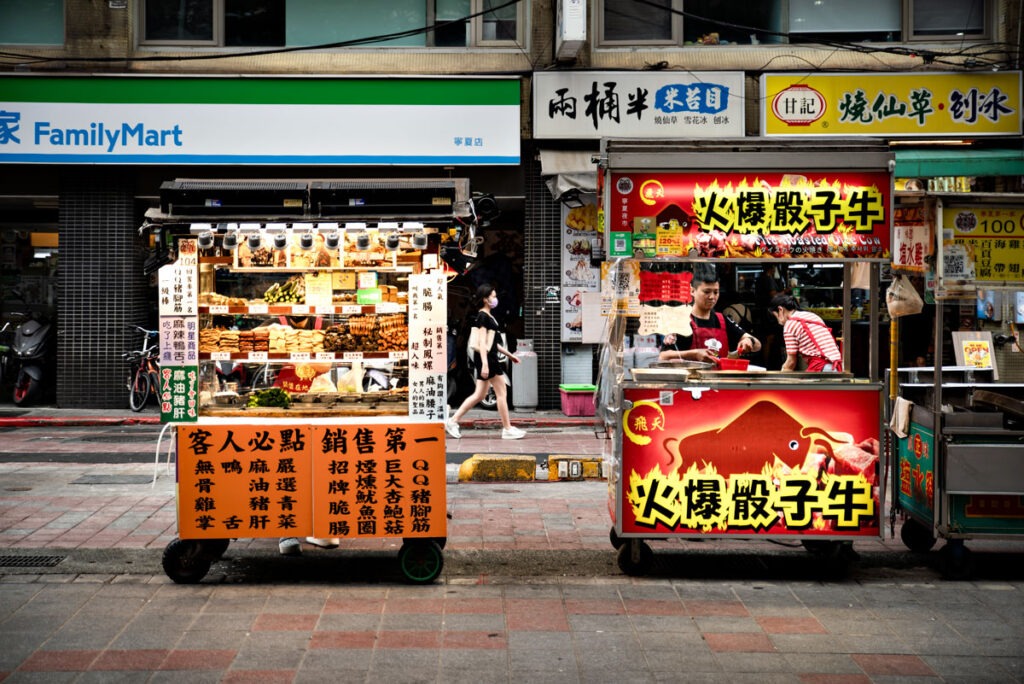
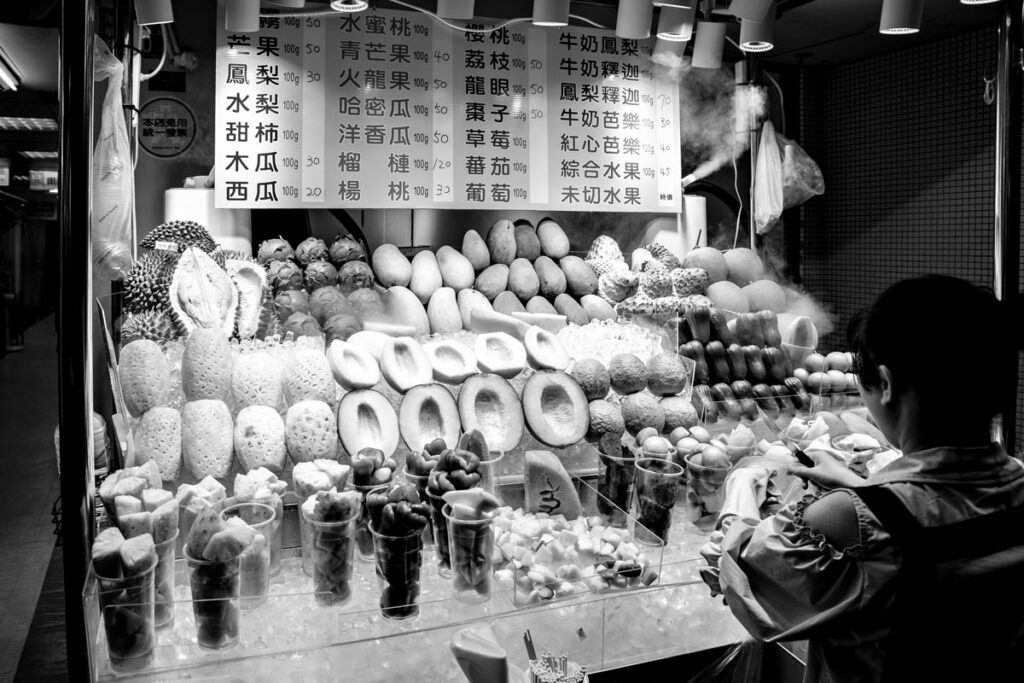
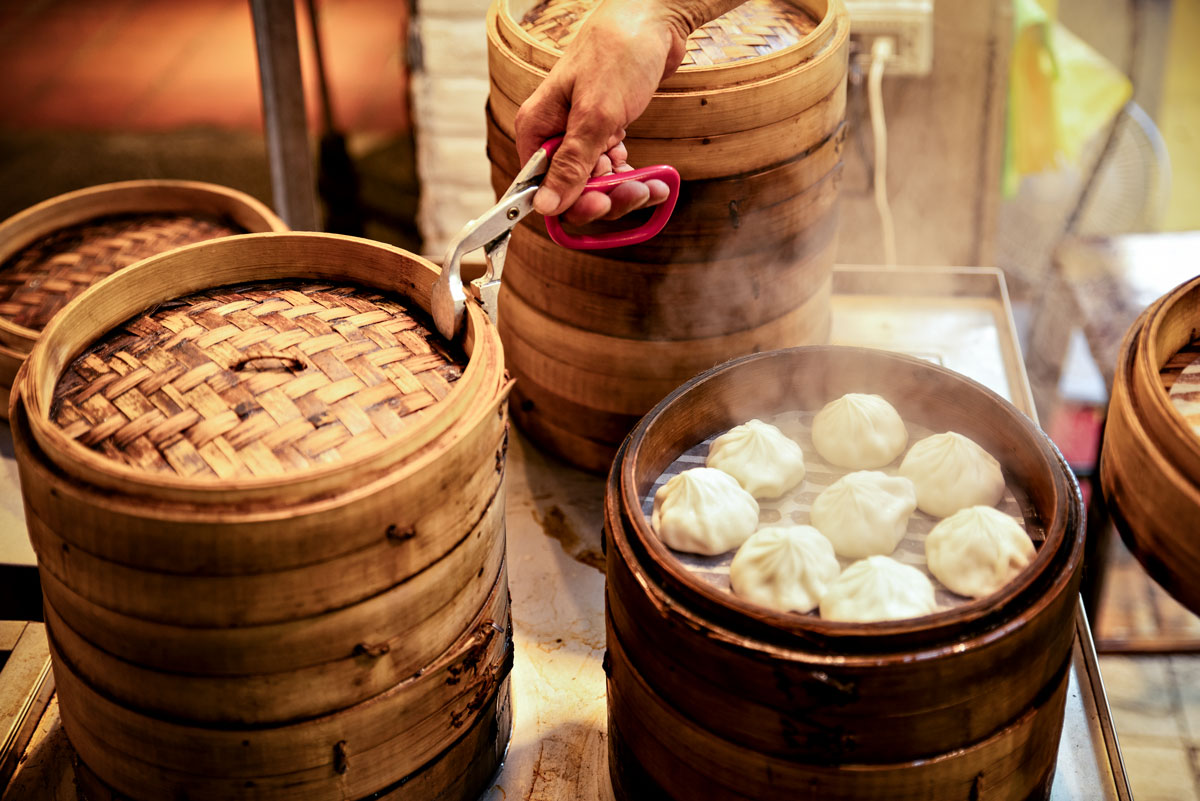
We are finally leaving Taipei. Finally not because we’ve had enough of this big city, but because it has made us want to discover even more of Taiwan.
We drive through the green mountain landscape that surrounds Taipei, over highways and through long tunnels. The closer we get to Taroko National Park, the more visible the destruction caused by the earthquake that hit Hualien in April 2024 becomes. The park, with its beautiful gorges and canyons, is closed indefinitely. So we let our drone take off: We see a crystal blue river carving its way through hard rock. A road that hugs the mountain in tight bends. Green, impenetrable forest. We would have loved to hike through the gorges of Taroko National Park. Now we have one more reason to visit Taiwan again.
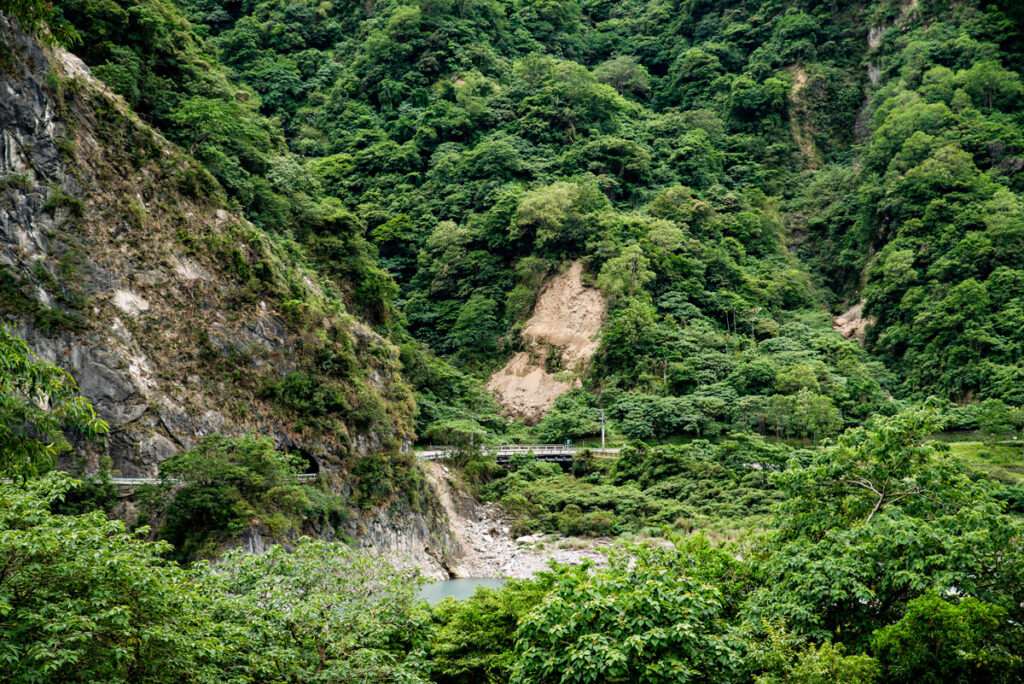
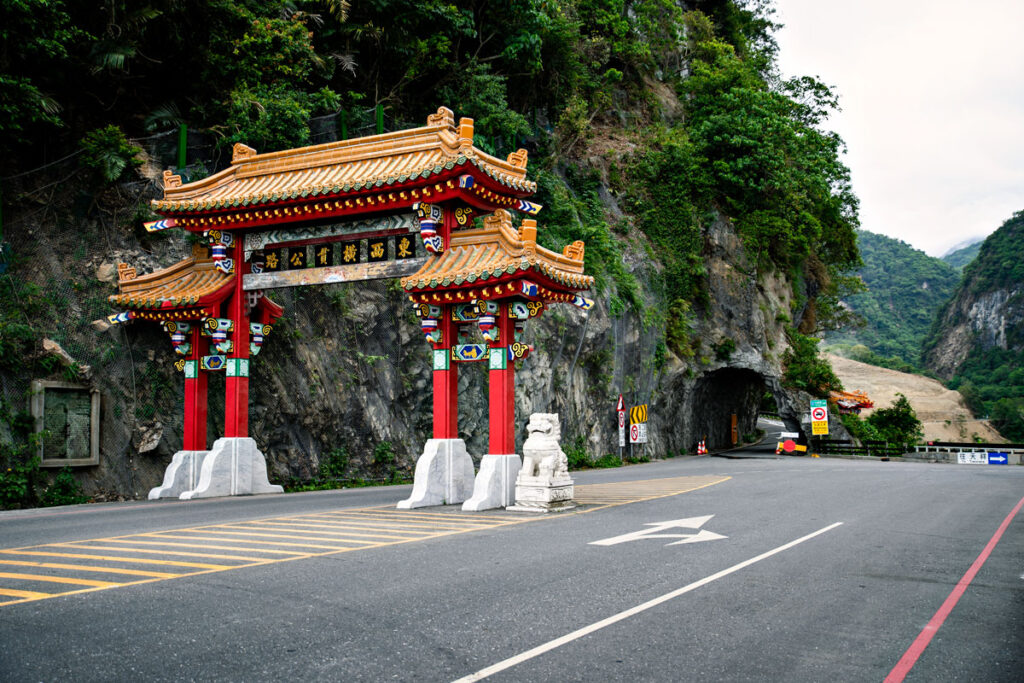
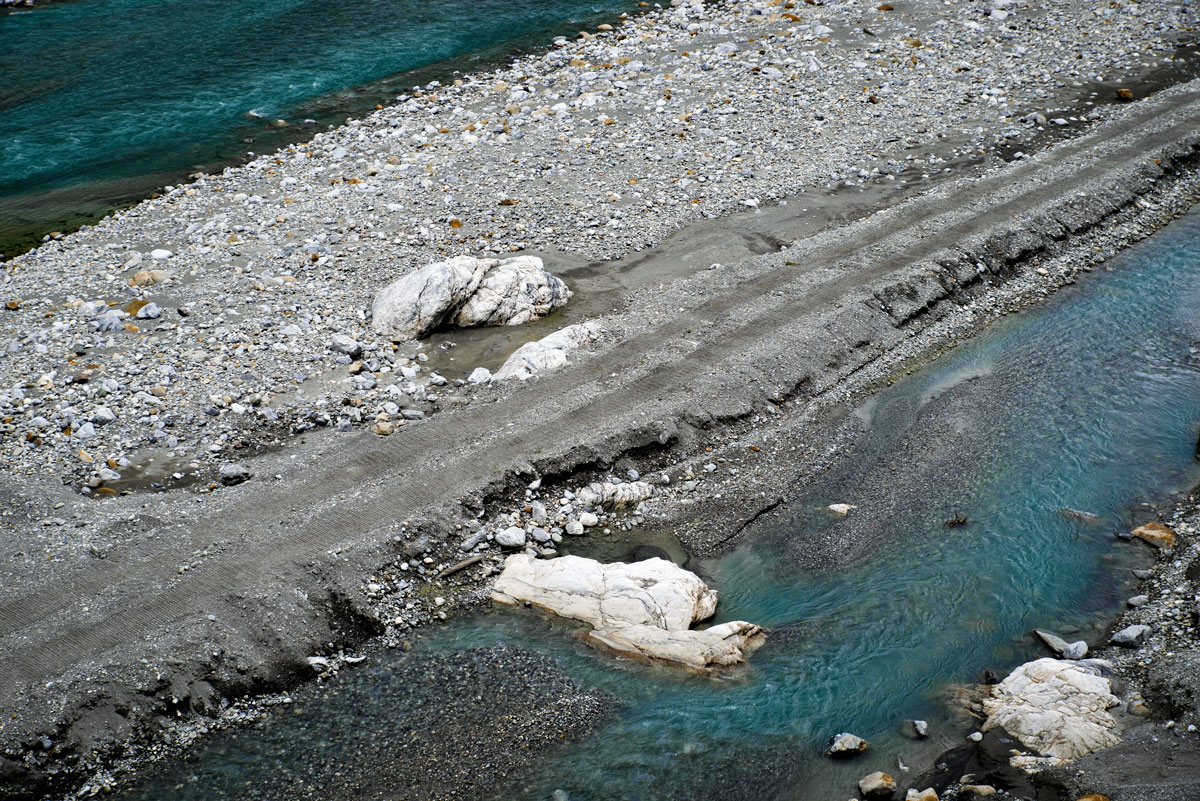
May marks the start of the rainy season in Taiwan. Sunny hours alternate with rainy ones. On the afternoon of our arrival, Hualien is covered in clouds and shortly afterwards it starts to rain. The next day we explore the city in the best weather.
The beach is stony and barren, the food market almost deserted by lunchtime. A dog waits, yawning tiredly, for a few scraps of meat. Lucky cats wave at us from shop windows and from almost every counter. While the town’s advertising signs shone and flashed in the wet darkness the night before, overwhelming our senses, the streets look sleepy in daylight. Most of the stores are closed. Wherever the inhabitants of Hualien are – only a few show themselves.
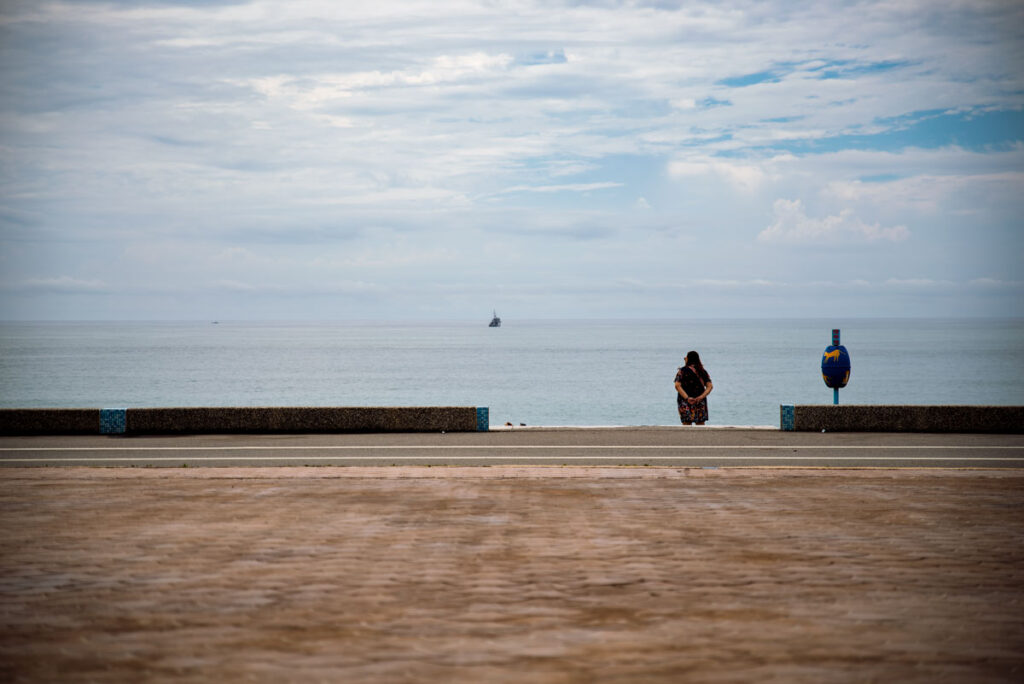
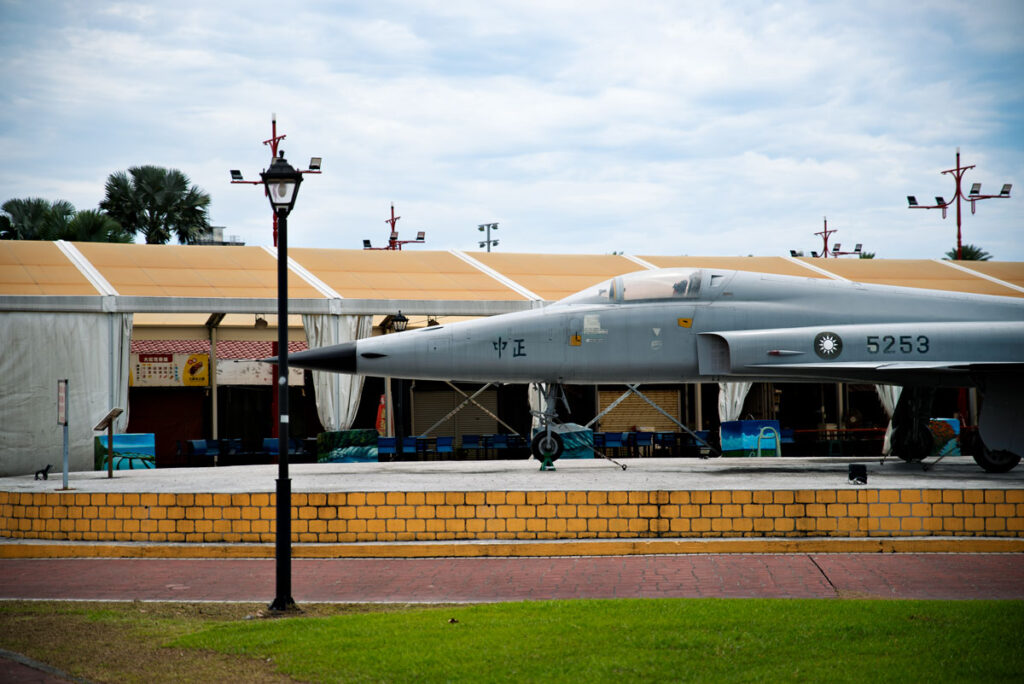
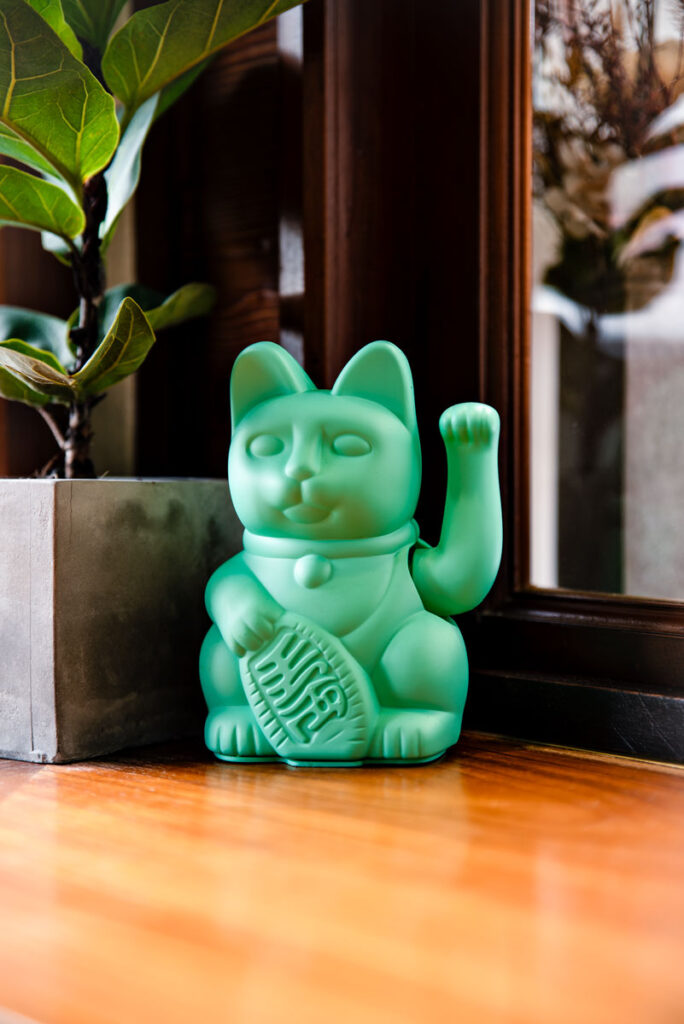
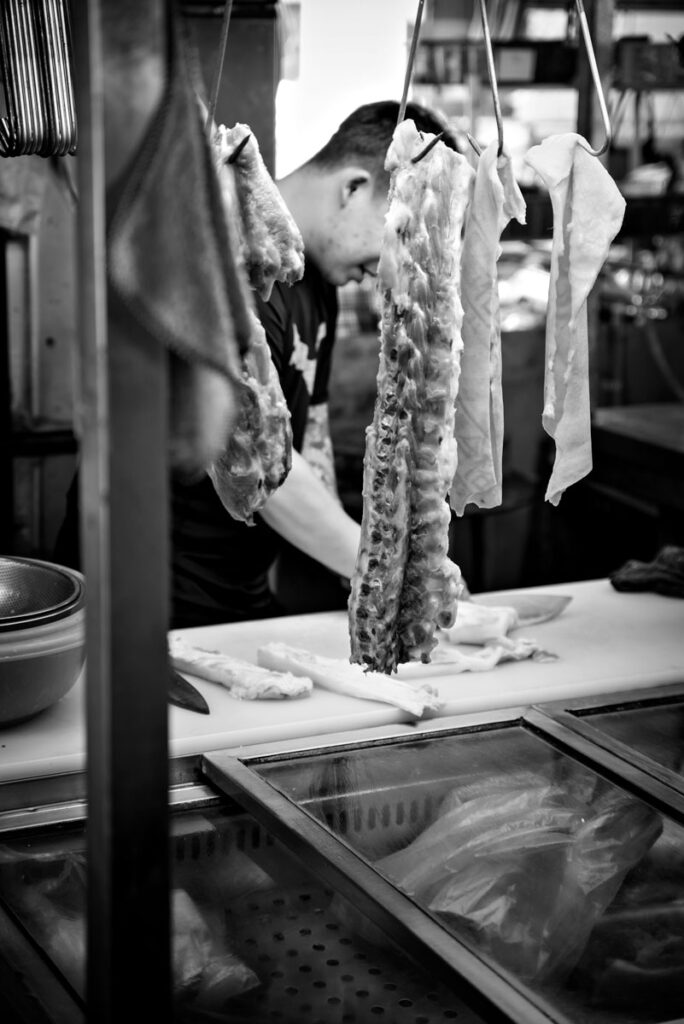
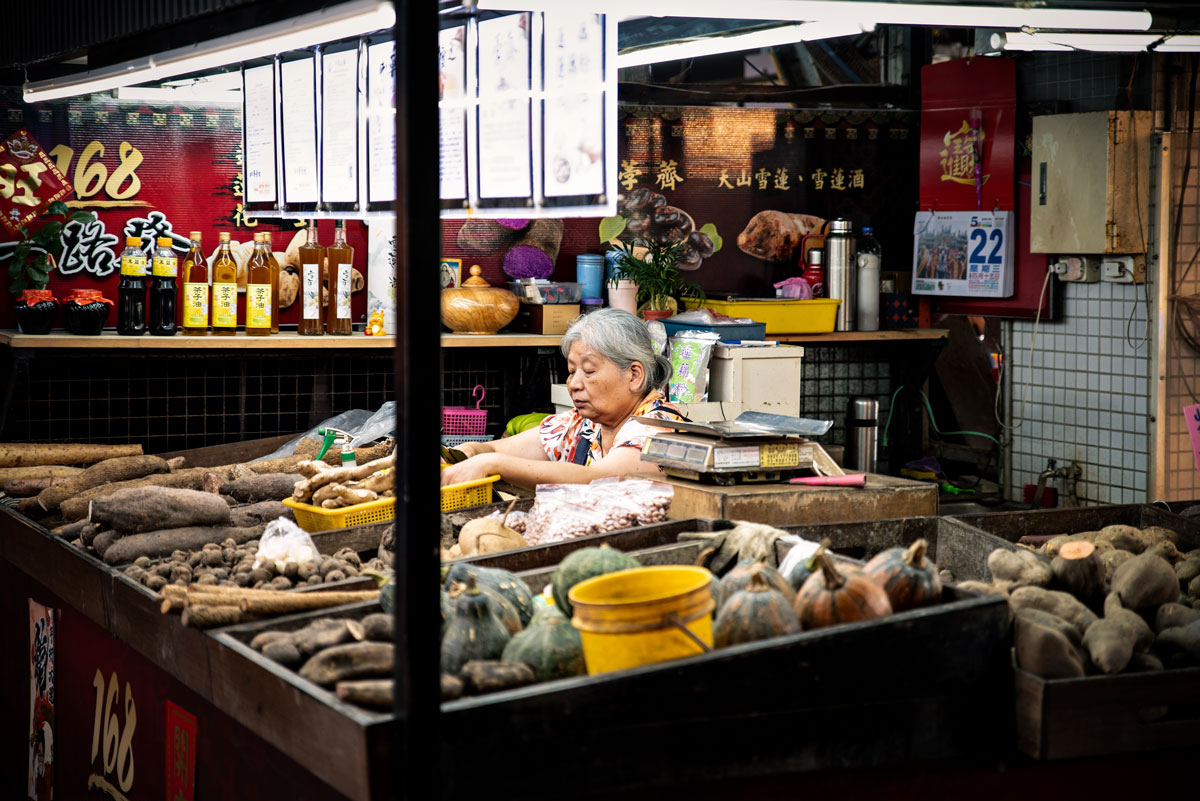
Just before Taitung we reach the Sanxiantai Bridge, which connects the mainland with a small offshore island in eight arches. It is a hazy afternoon. A thunderstorm has just passed over us and there is always the threat of another one. There are hardly any other visitors here. It is humid and tropically warm, yet we are reminded of Ireland’s green north. The pebble beach, the rough rock, the salt in the air.
Following a footbridge, we reach the center of the island and the end of the paved path. A narrow trail – so soggy and washed out by the rain that we don’t want to walk it – leads around a mountain to an old lighthouse. Instead, we climb a rock and from there have a magical view of this beautiful piece of earth. This idyll compensates for the rainy Hualien and the closed Taroko National Park.
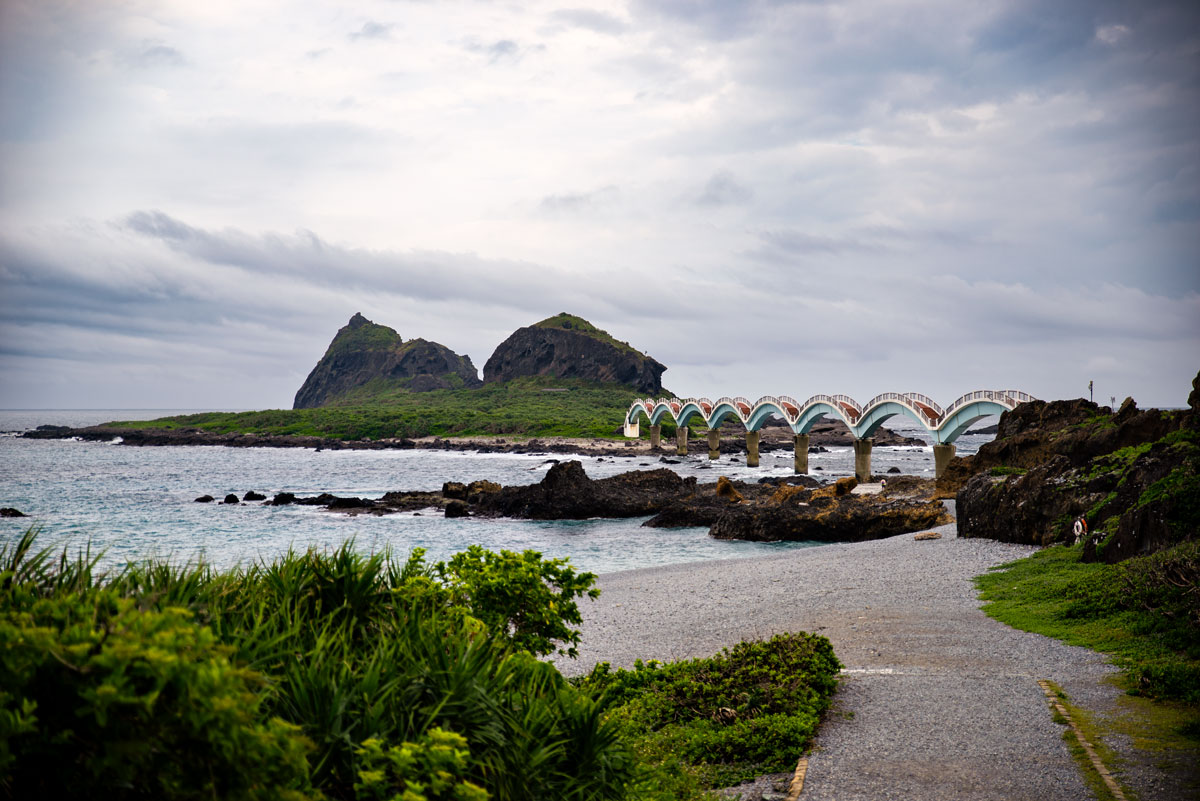
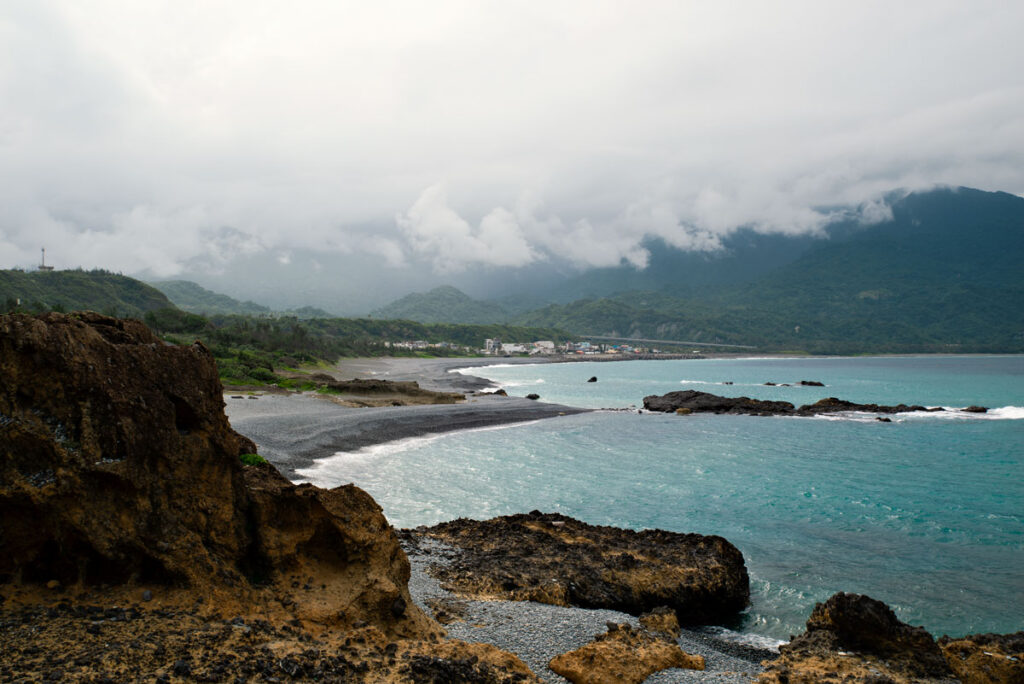
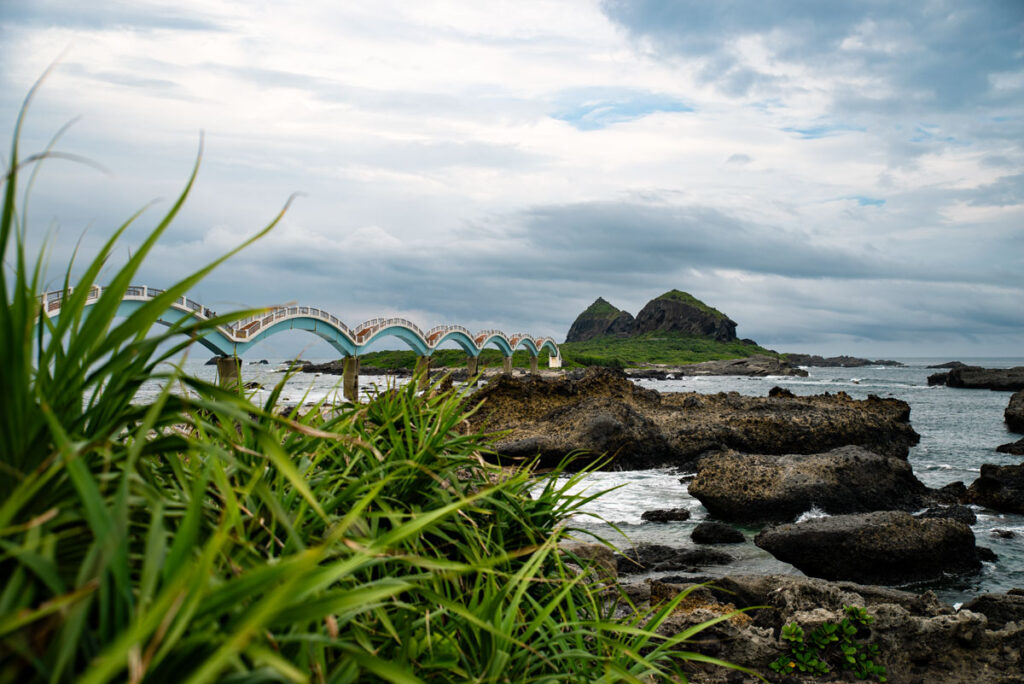
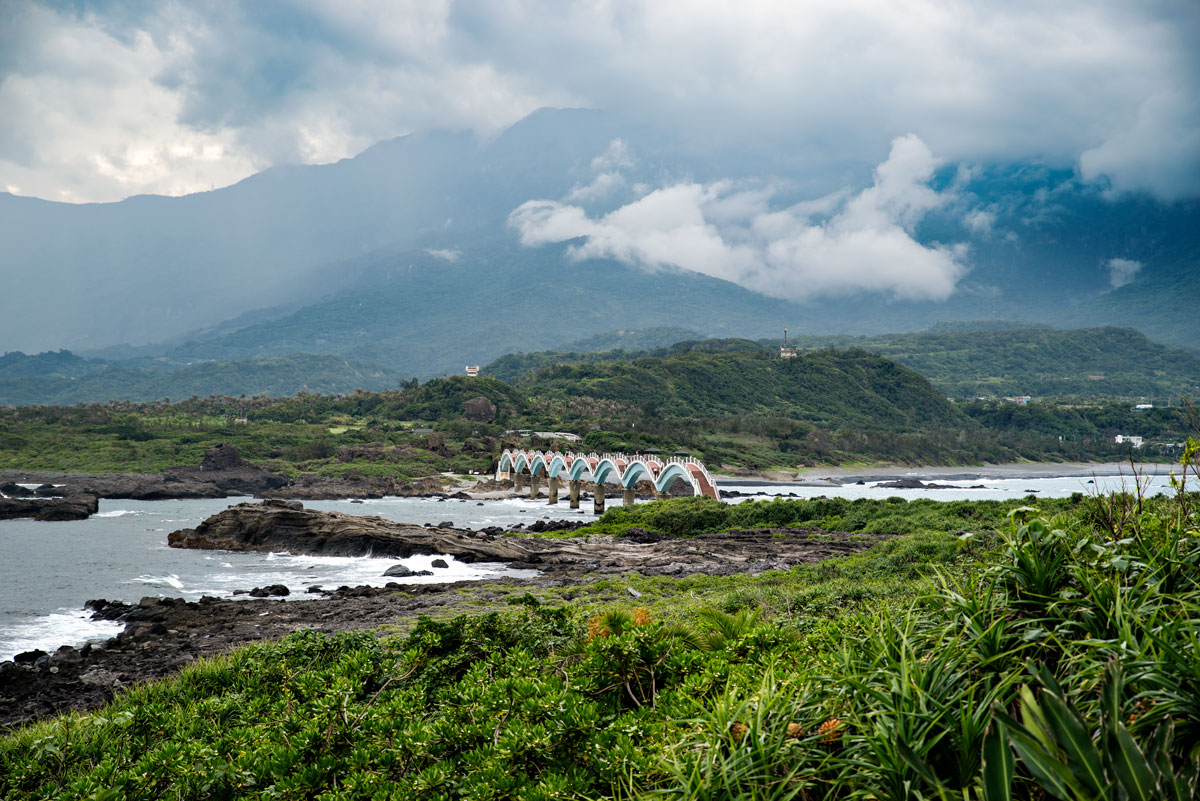
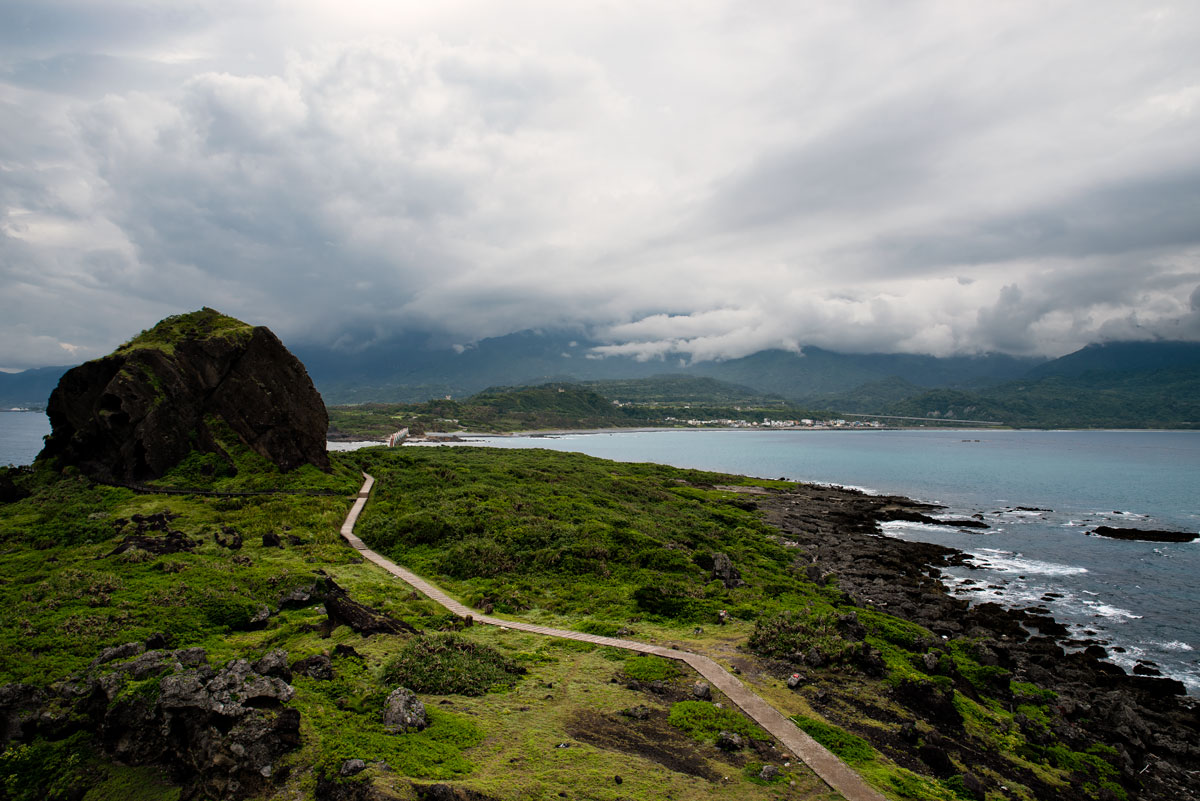
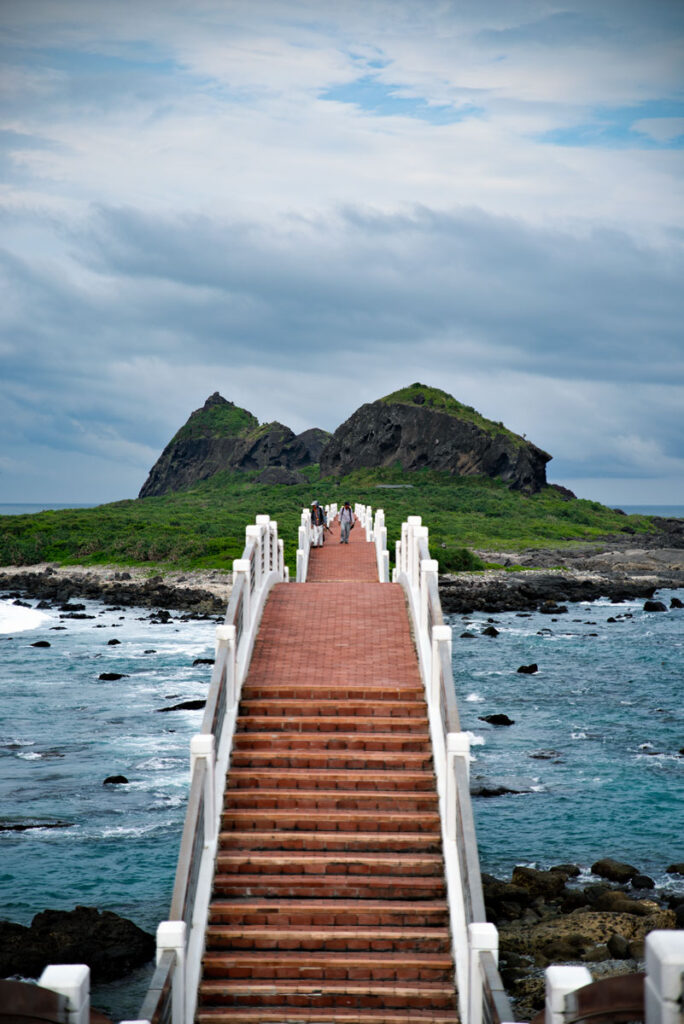
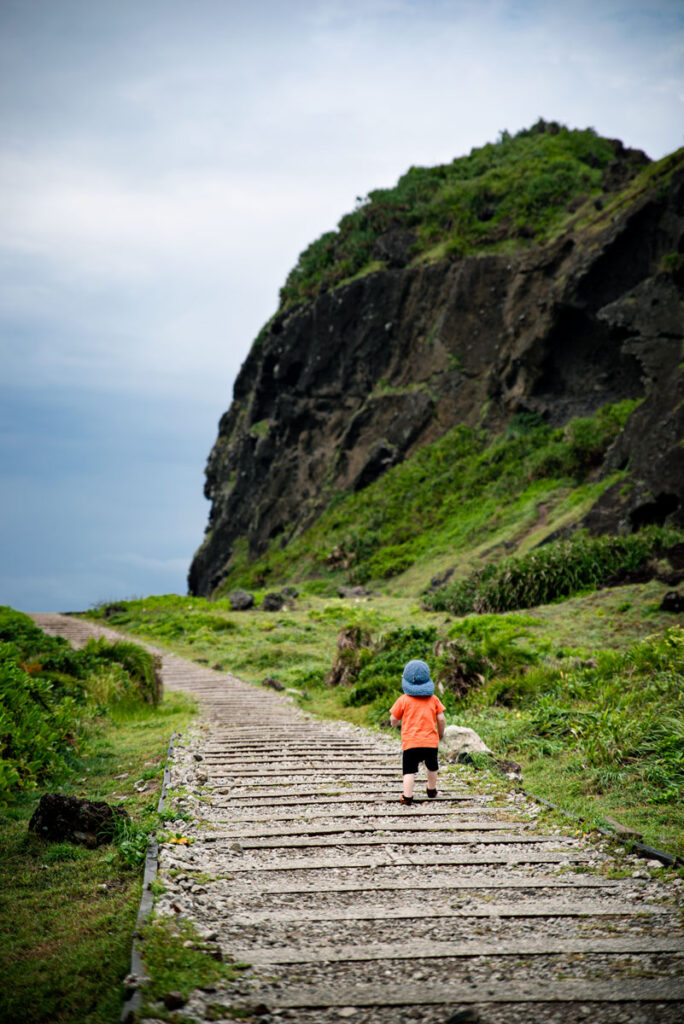
Another town, another beach. Delicate flowering ground plants grow between round washed stones. An off-road Mitsubishi minibus is parked on the shore. We see these vehicles all over the country, they are the Golf of off-road vehicles. A fisherman has cast out his rods and has his live bait in a plastic bucket. Mainland China is holding a major maneuver. The Taiwanese air force is on alert. A gigantic bomber roars over Taitung just a few hundred meters above the ground. Fighter jets take off and land every minute. The people on the beach, the people in the city – they are not disturbed by this. They don’t believe that war is imminent. Is it naive, optimistic or a lesson learned from decades of peaceful history?
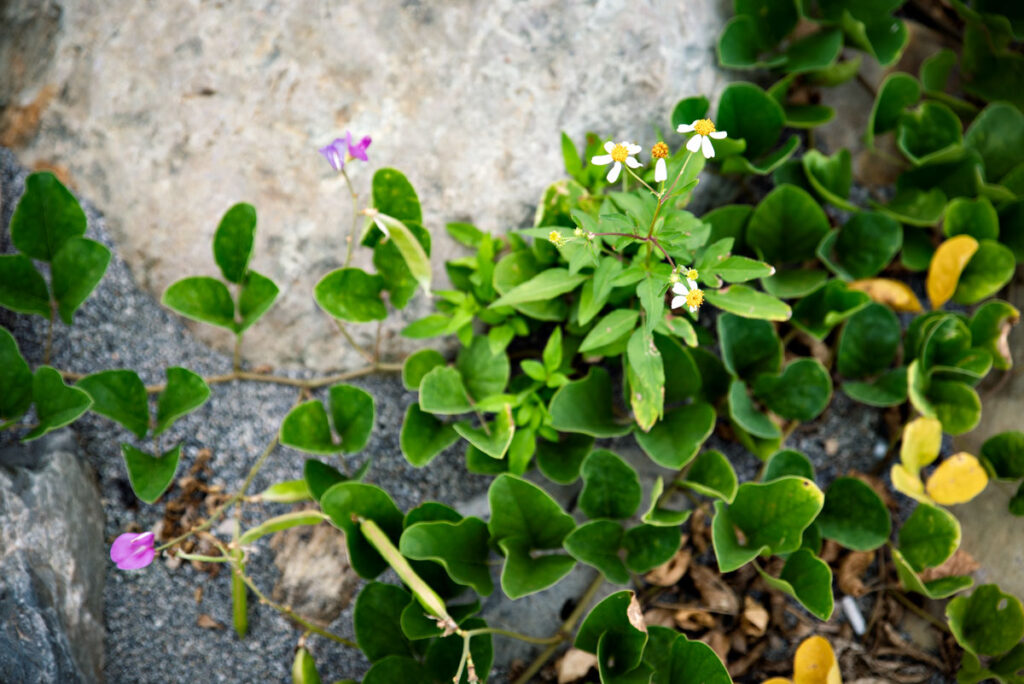
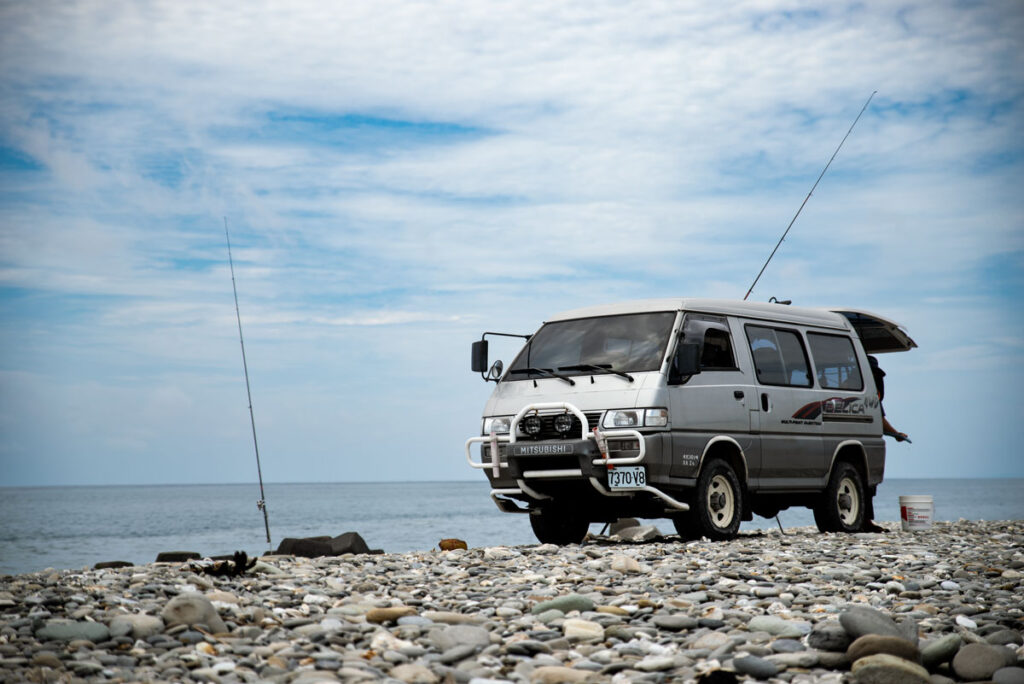
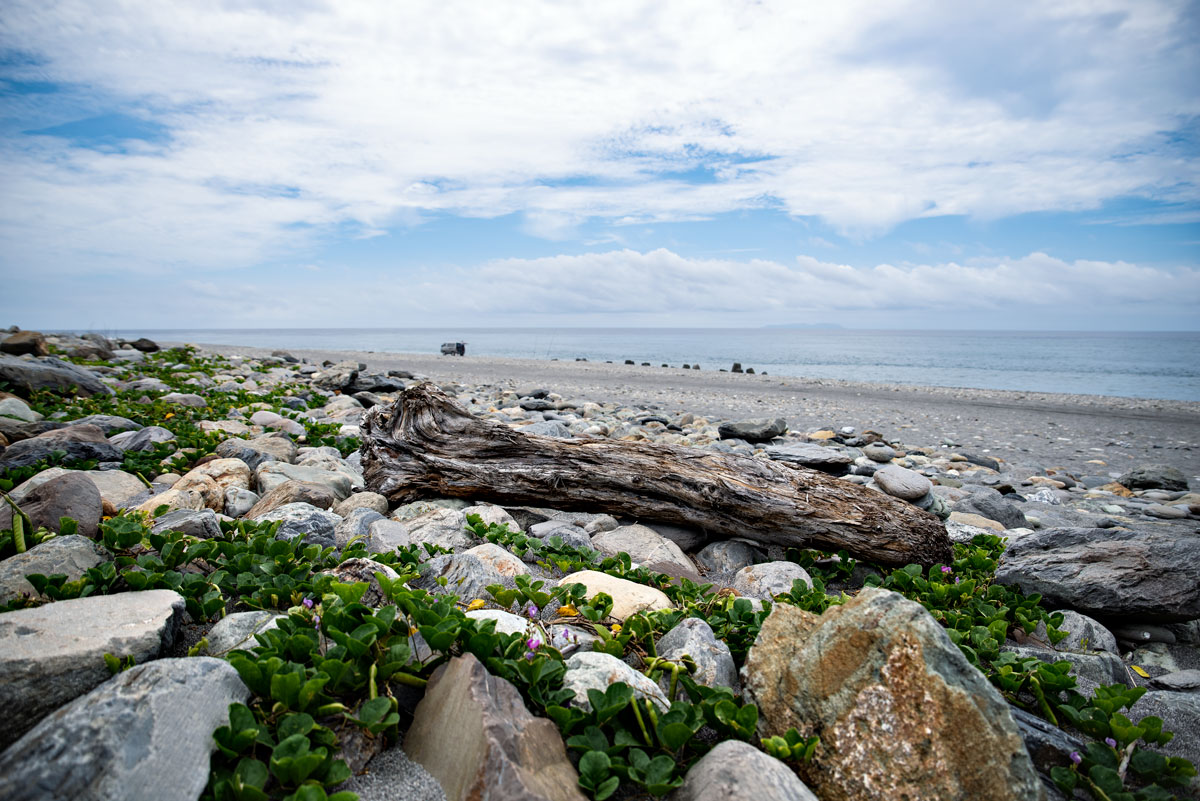
We reach the tropical south of Taiwan. In Kenting National Park, lush nature and sandy beaches meet hordes of tourists. Stylish young adults show off their luxury cars on the narrow beach road between streams of visitors and the hot, smoking stalls at the night market. Sunscreen and banana boats, umbrellas and loungers. A cold beer, ice cubes in a cocktail. We leave all this behind and drive into the hinterland. In a large park, we photograph wild monkeys, butterflies and lizards. A short drive takes us out of this dense forest area and into a barren steppe landscape. A herd of water buffalo graze here. The view from a gentle hill is idyllic: the sea in the background, small settlements in the valley. A lonely mountain, an old forest.
If you follow the main road along the sea, you will reach a small lighthouse and, after a short walk, Taiwan’s southernmost point. A stone monument – less than two hundred kilometers from here lie the first islands of the Philippines.
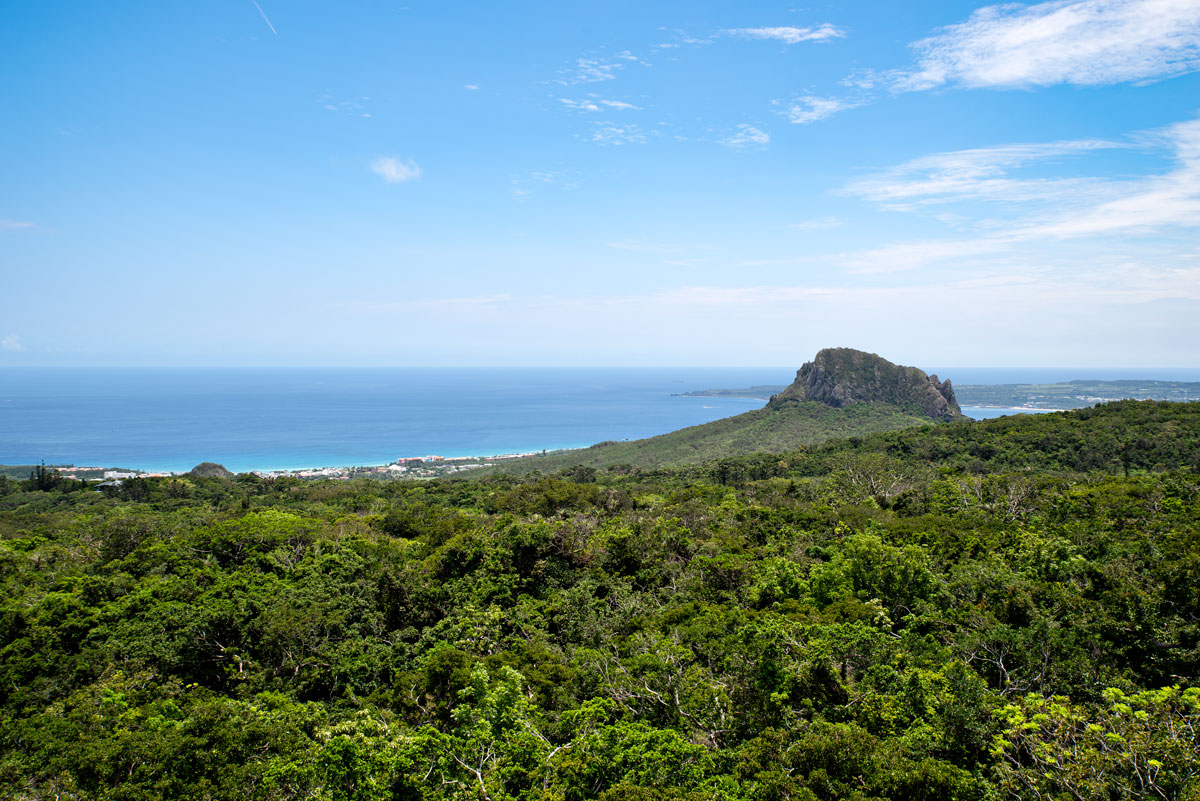
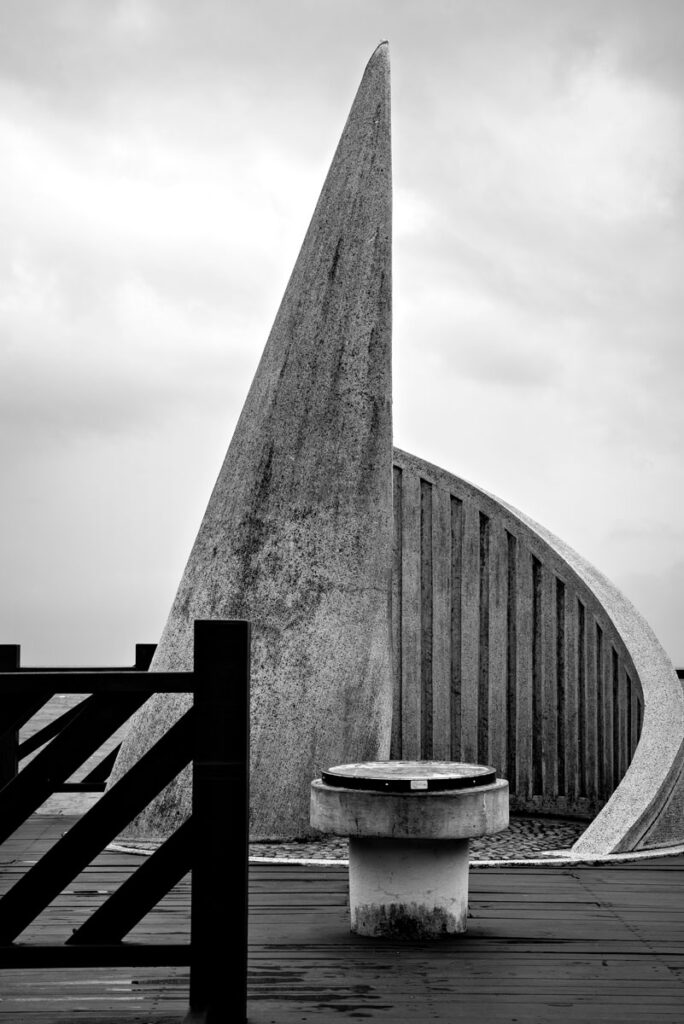
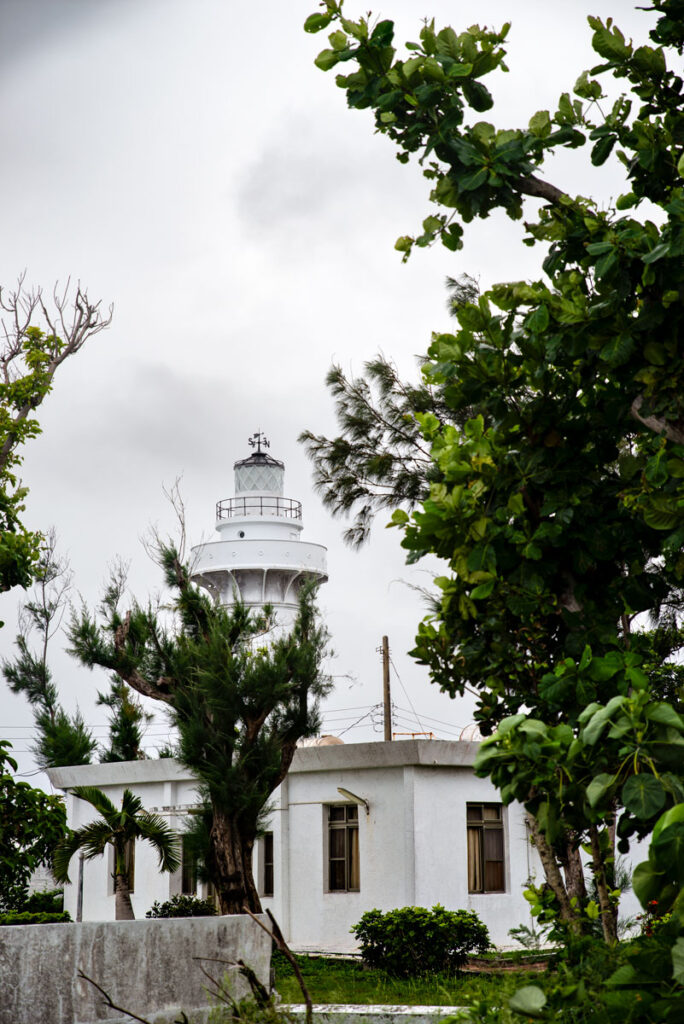
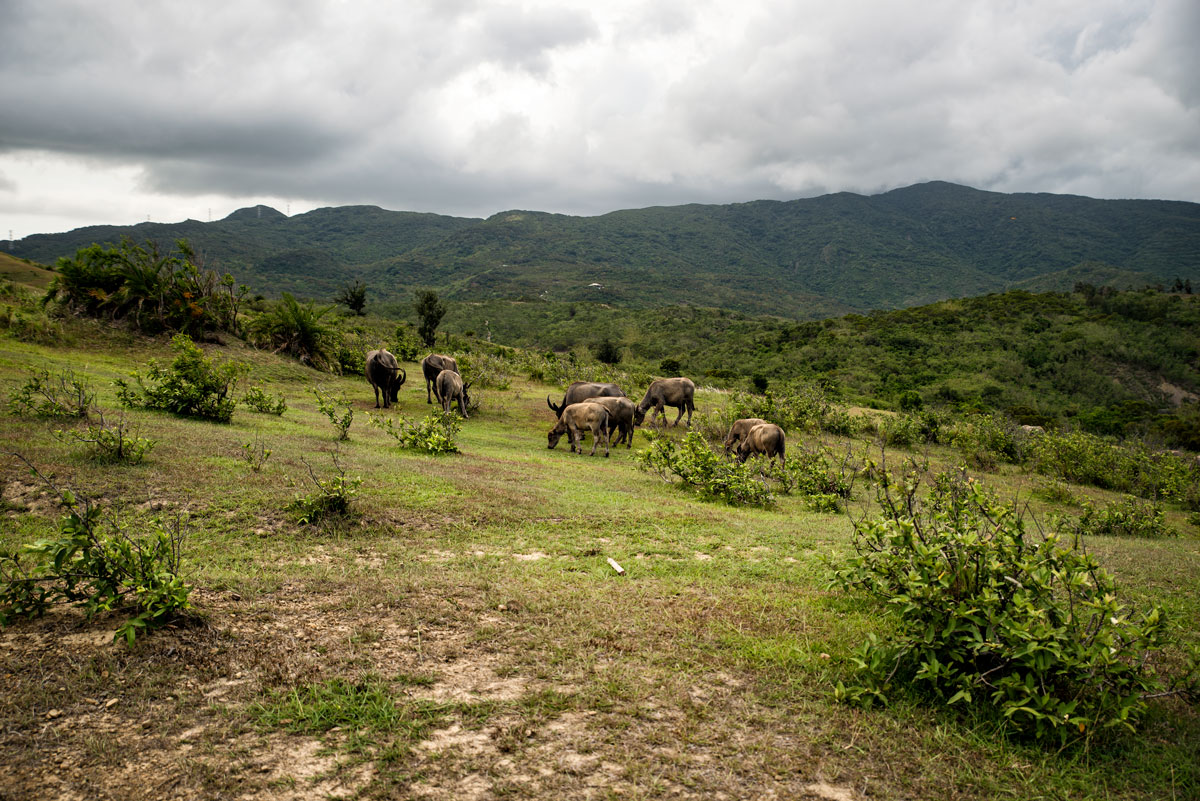
The closer we get to the metropolis of Kaohsiung, the more industrial the landscape becomes. While we perceived the east coast as provincial, tranquil and close to nature, we now suffer a culture shock. Superhighways, traffic jams, high-rise buildings. Our hotel is in a dingy area. The next morning welcomes us with rain showers. We stock up on umbrellas and rain ponchos at the 7-Eleven – Taiwan in May is like swinging between sunshine and bad weather.
The Lotus Lake is surrounded by skyscrapers in the east, temples and old town districts in the west. Dragons and tigers watch over the lake. Smoke escapes from the entrance gates of the sacred sites, the air around the lake is filled with the heavy smell of incense sticks and sweet flowers. Old women sit at their market stalls selling fruit and talismans. The sound of a karaoke singer – a traditional song from Taiwan – emanates from loudspeakers. A few passers-by turn their heads to listen.
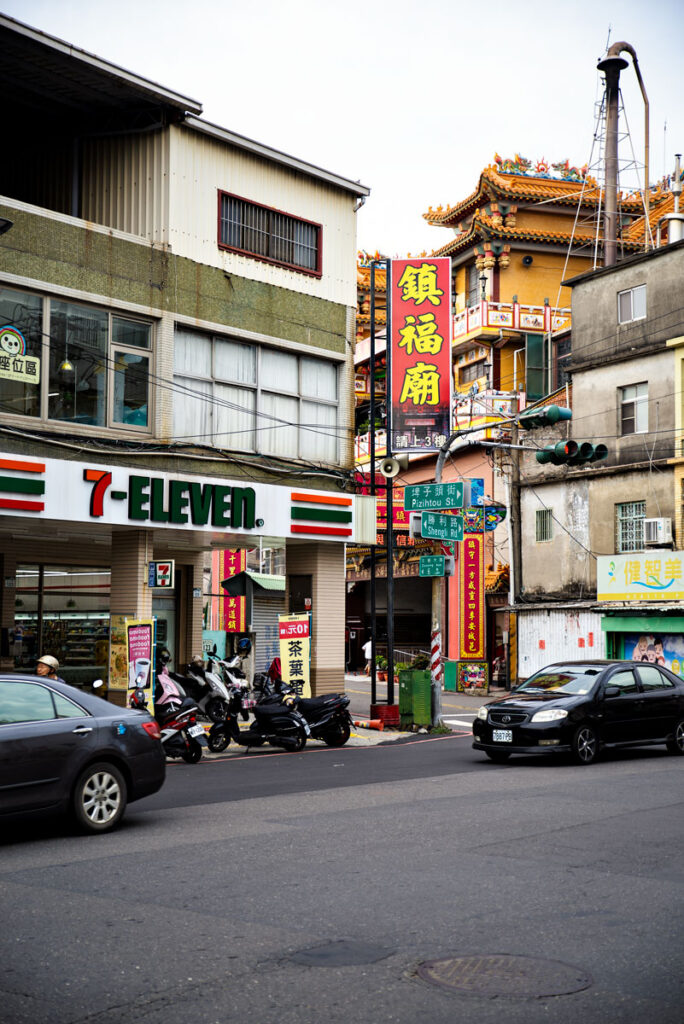
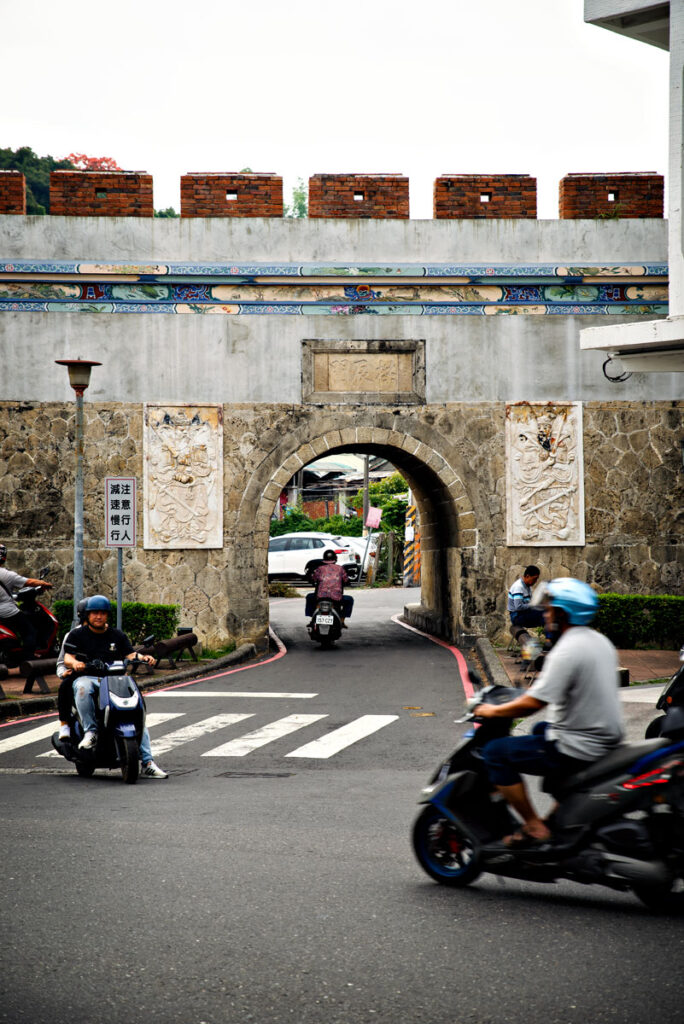
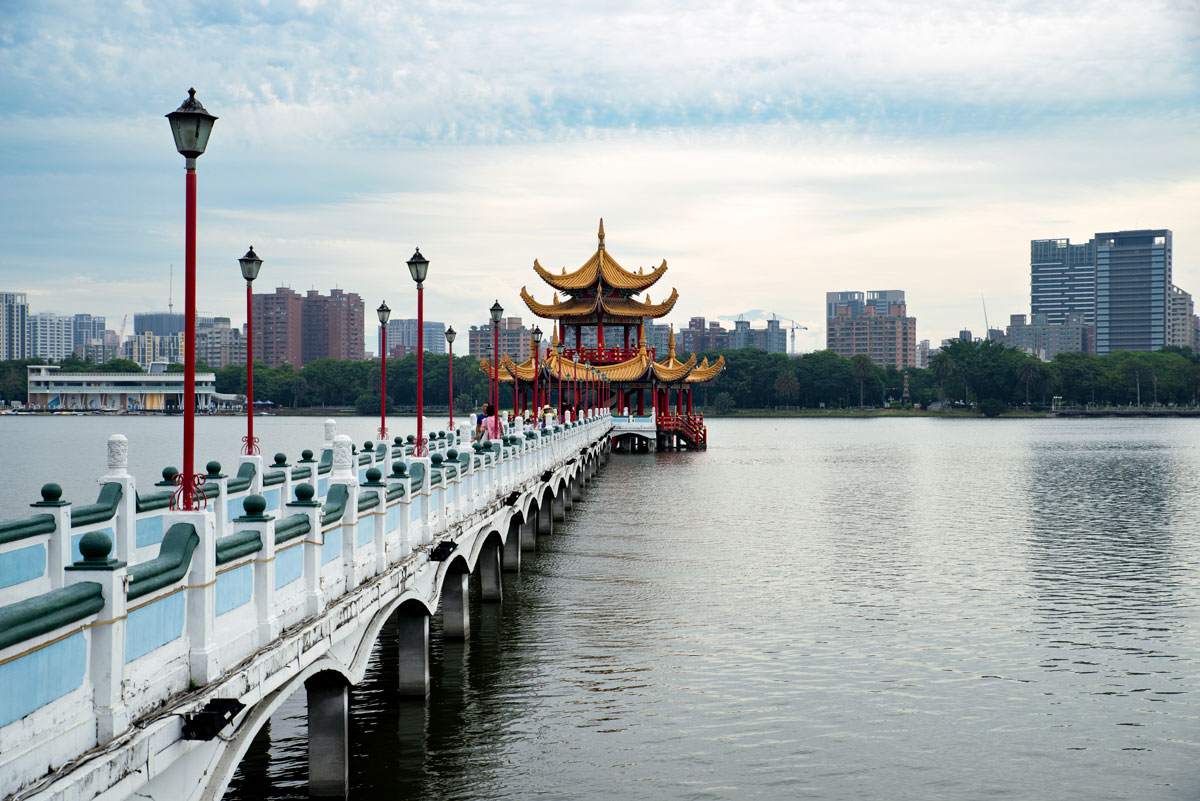
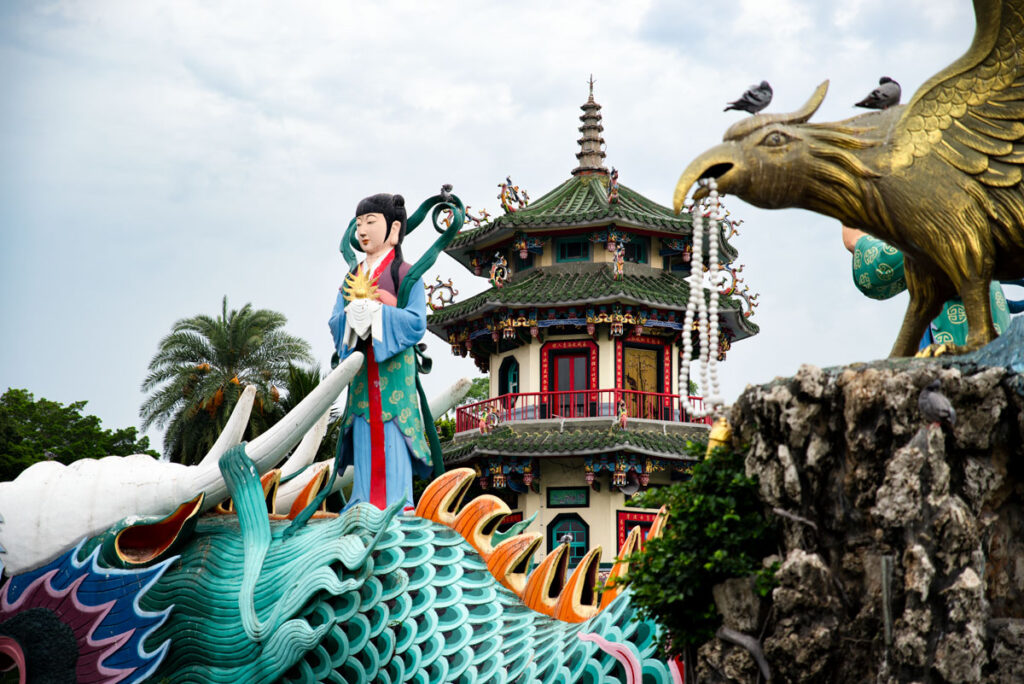
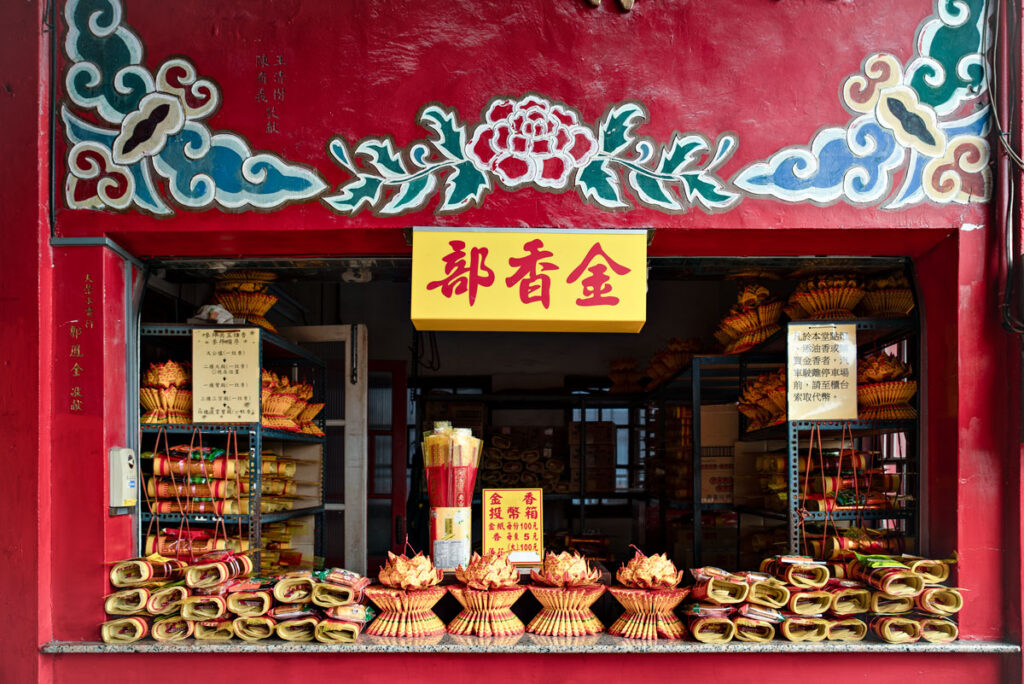
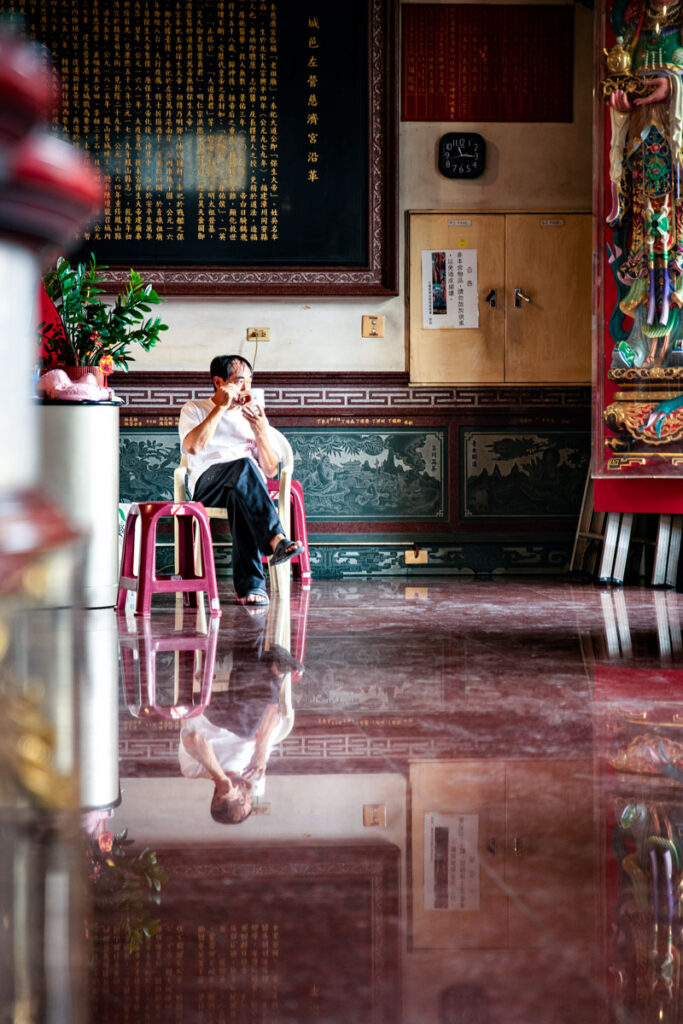
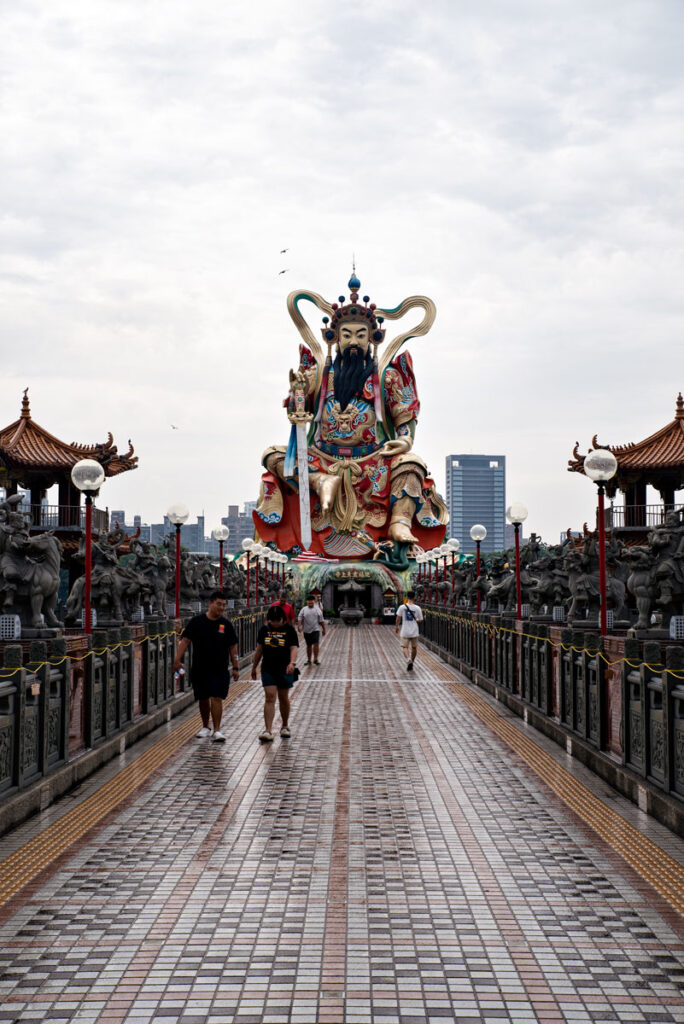
The rain gets heavier. We seek shelter in an archway of the Temple of Confucius. When we realize that the rain is not going to stop any time soon, we run for the bus that will take us back to the city centre. One hot coffee later, the rain has subsided to a gentle drizzle.
Kaohsiung is a city of contrasts. Skyscrapers and shabby buildings alternate. Modern, almost hip stores stand next to old town districts with temples and traditional stores. Kaohsiung is not Taipei and has nothing to do with the tranquil cities on the east coast that we have already got to know. Kaohsiung is livelier, busier, rougher, more genuine and full of contrasts.
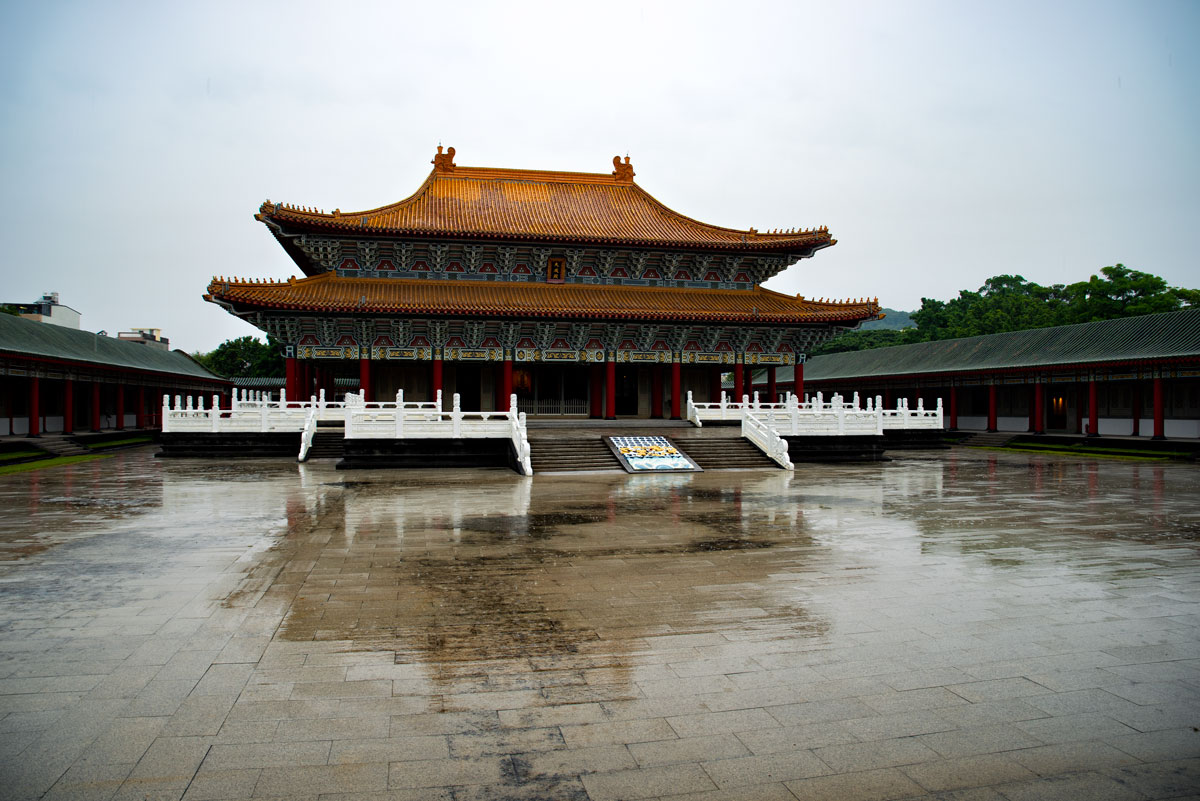
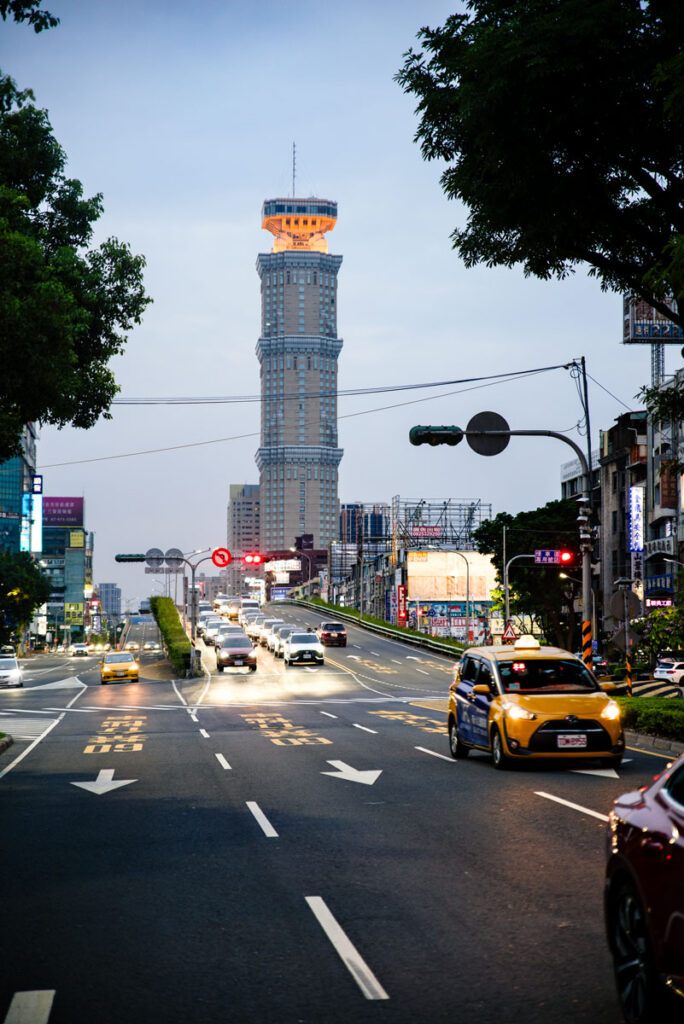
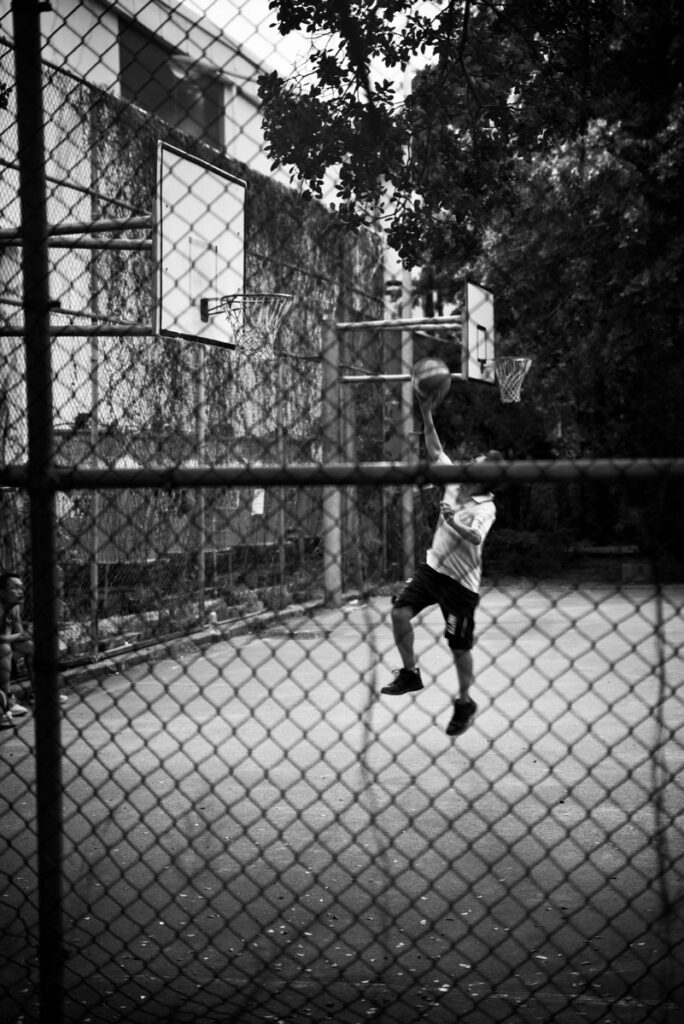
The harbor is accessible to ships via a narrow entrance in the west of the city. The former British consulate is enthroned on the mainland in Sizihwan, opposite it on an island is the historic lighthouse. Warships are anchored off the coast. Small boats and freighters glide from the open sea into the safe harbor or return to the sea. A quiet hustle and bustle. On the shore of the harbour are rotting warehouses and those that have been renovated and now nestle against the water as modernized glass and steel buildings. Chic cafés and boutiques. Murals and industrial architecture. One of the side canals is illuminated by colorful lights. The Kaohsiung Music Center pulsates to the rhythm of music blaring from loudspeakers.
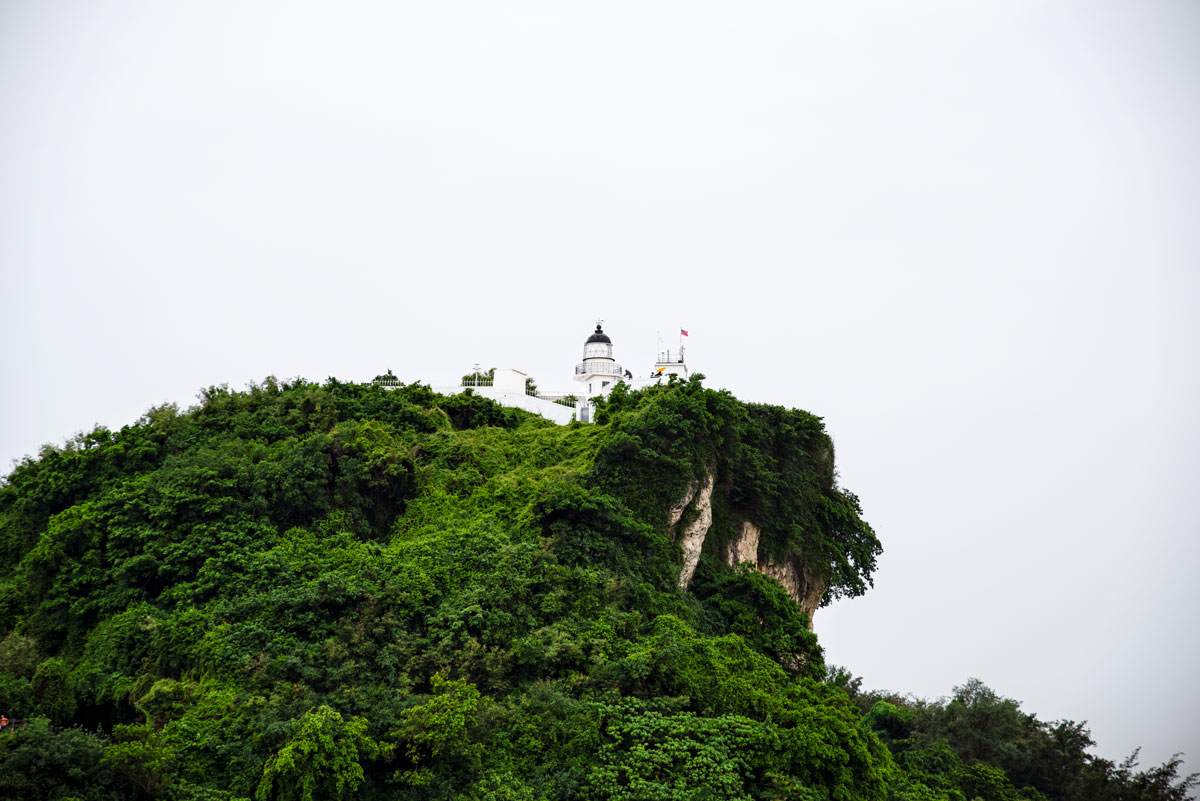
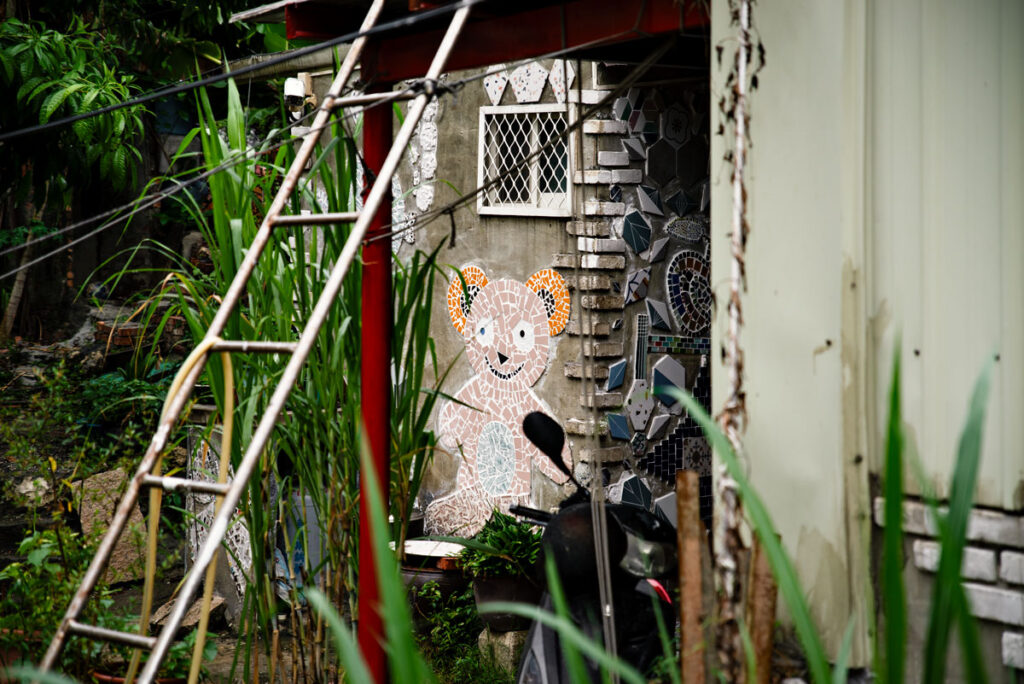
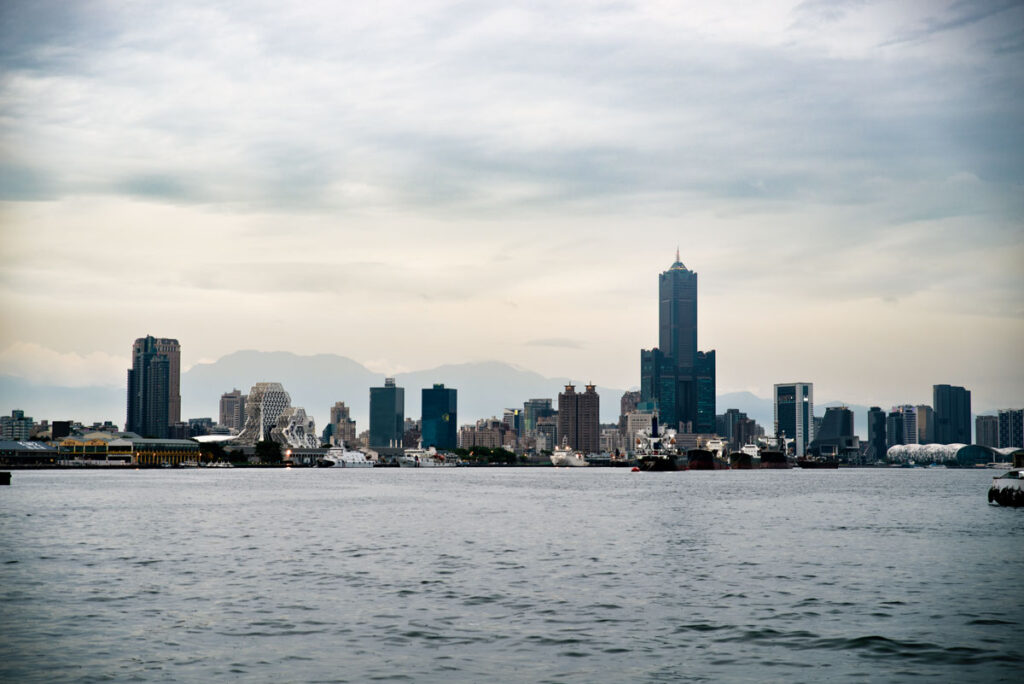
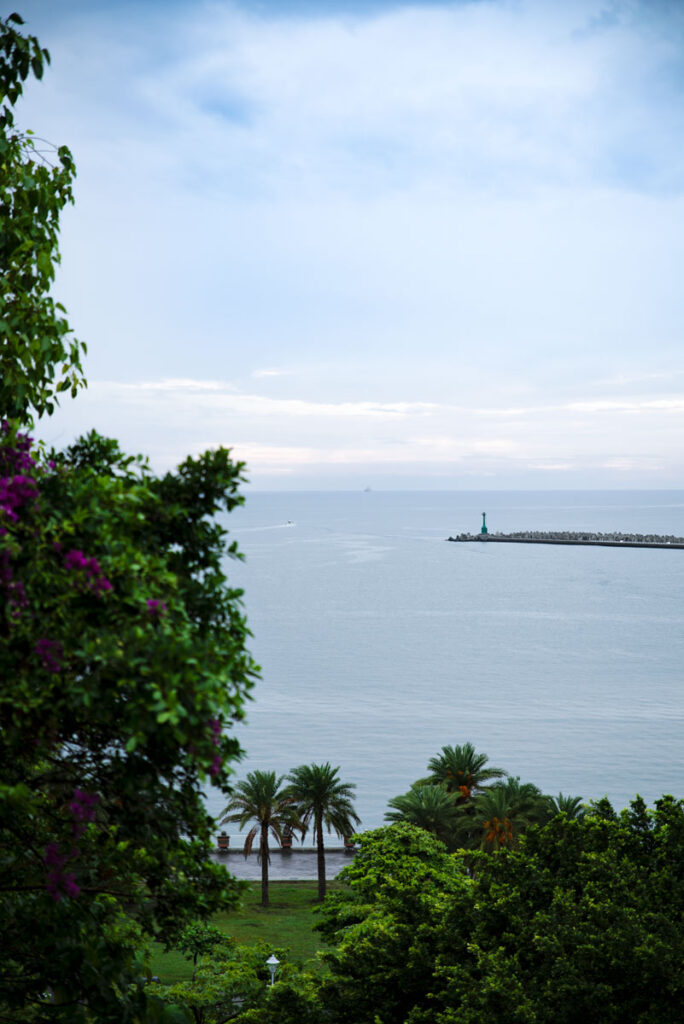
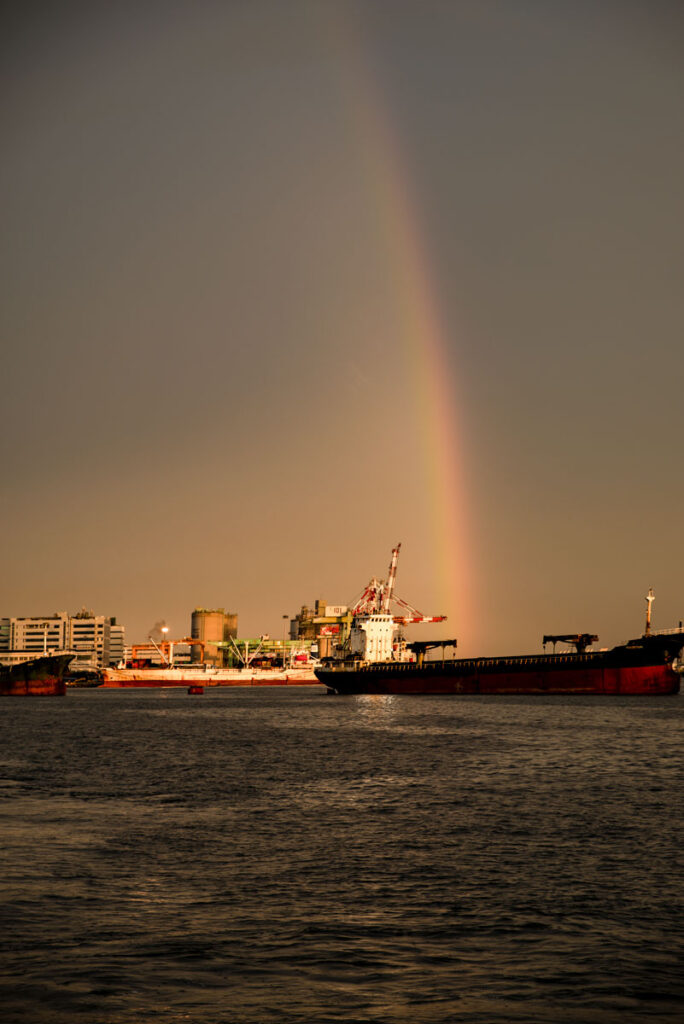
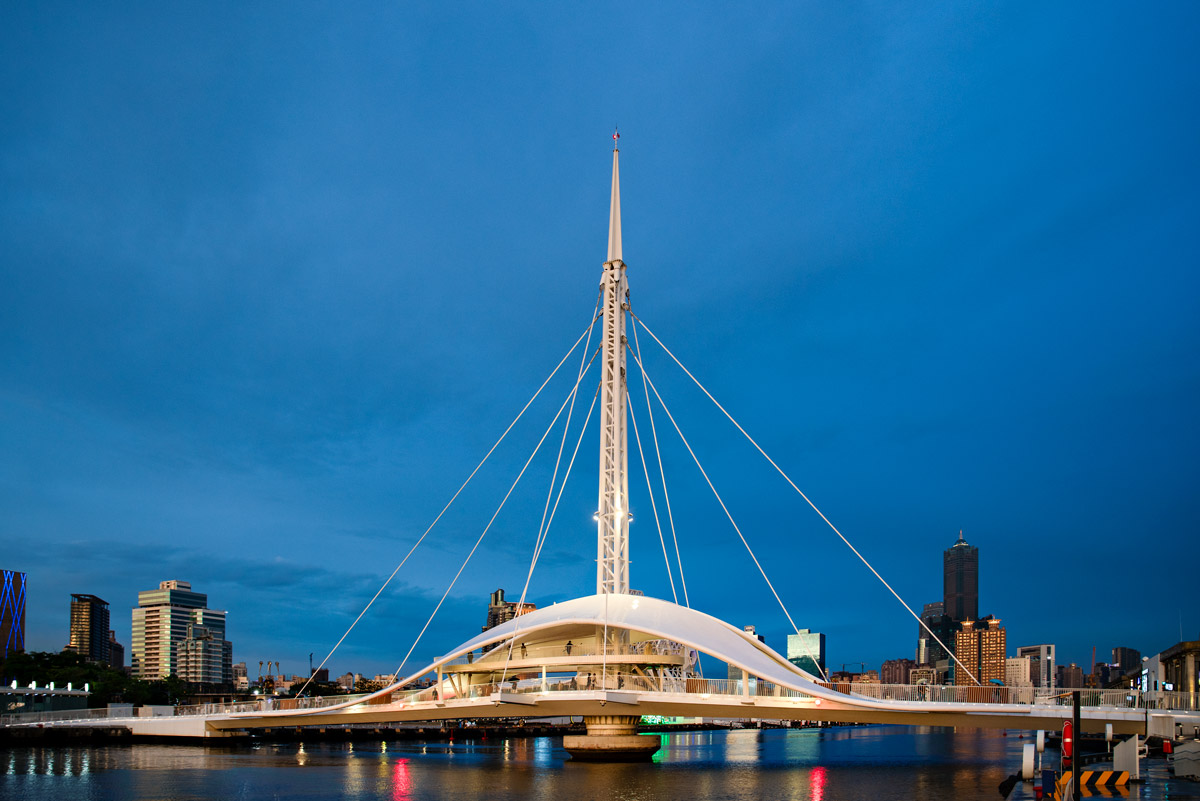
We leave the metropolitan region of Kaohsiung and drive into the hinterland. We reach the Fo Guang Shan Buddha Museum on a highway. A rather strange place: a huge Buddha statue rises above sacred relics. Eight towers, symbolizing the noble eightfold path, stand at the edge of the open grounds. Nuns wait in the shade of the buildings to answer visitors’ questions. In an air-conditioned reception hall, there are vegetarian restaurants and souvenir stores, cafés and special offers. Capitalism and Buddhism need not be opposites. In the center of the area, everything is geared towards pomp and wonder. Colorfully illuminated art installations, halls filled with spherical sounds, bare feet on the teak floor. Religion only works when it’s big.
We want to get out into nature once again. So we follow ever narrower roads that wind their way up into the mountains. Thick rain clouds hang close above our heads. A sapphire-blue river makes its way through a valley. A suspension bridge spans it. There are many such bridges in the high mountains of Taiwan. Our drone records a breathtaking video. The first raindrops start to fall and we hurry back to the car. Fog rolls over the mountain ridges and we are overcome with melancholy. Soon we will have to say goodbye to Taiwan. There is so much we have not seen. But we have already learned to love this mystical country.
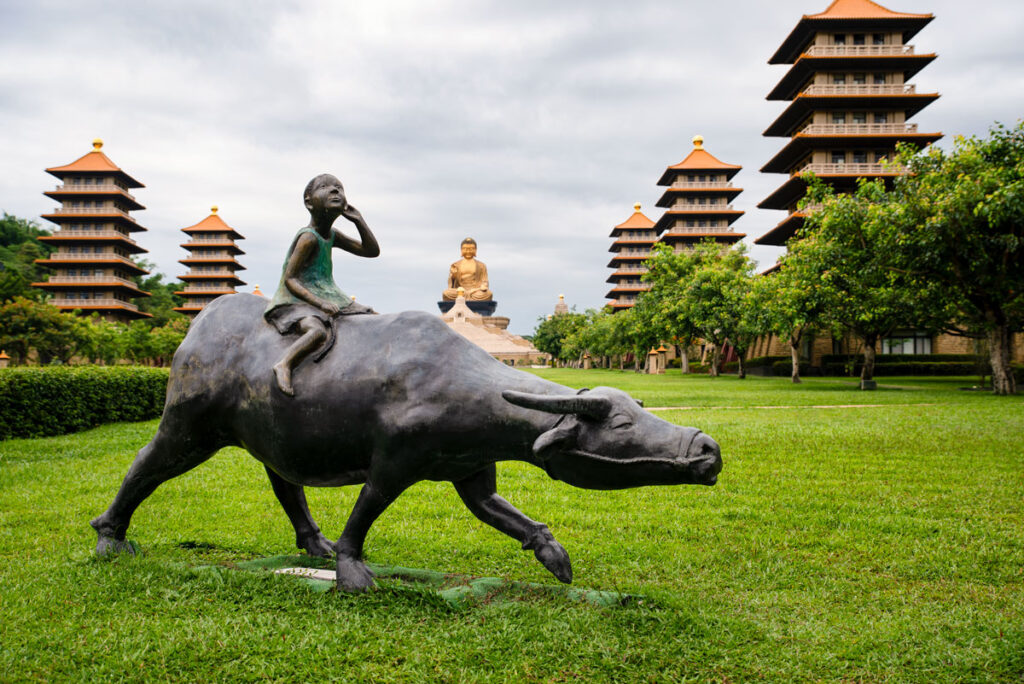
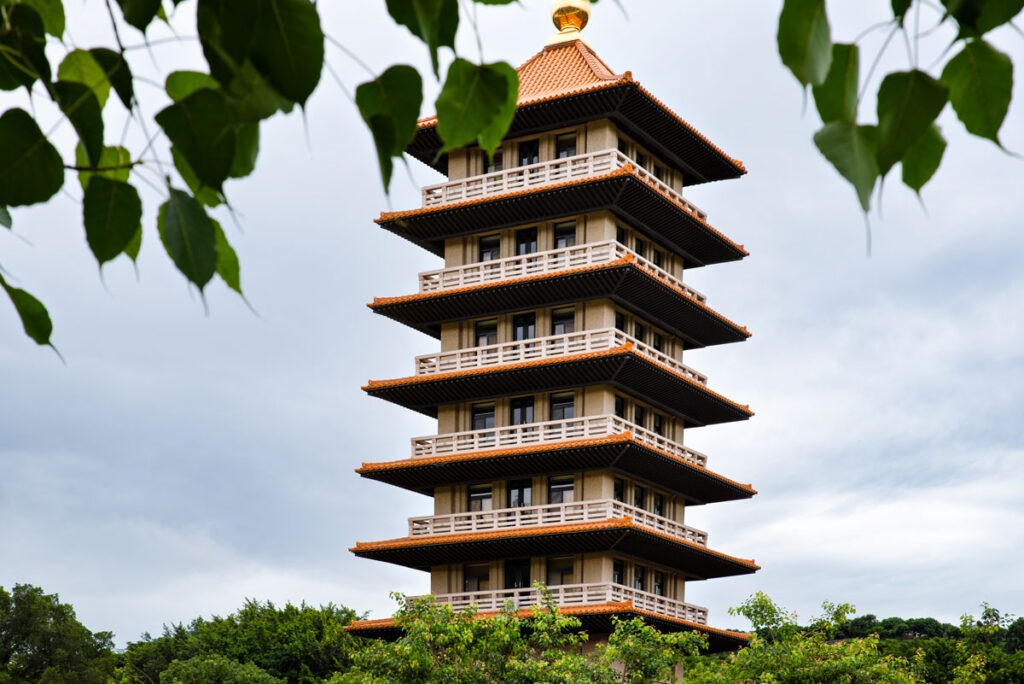
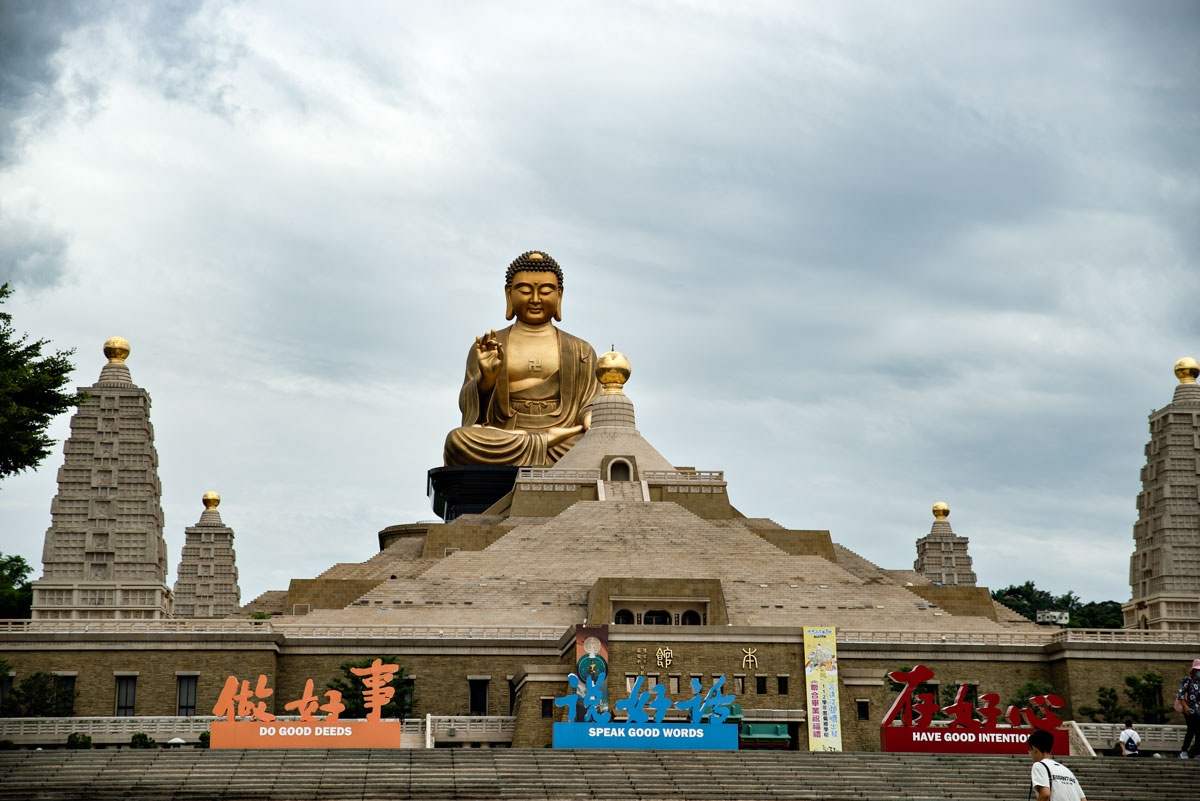
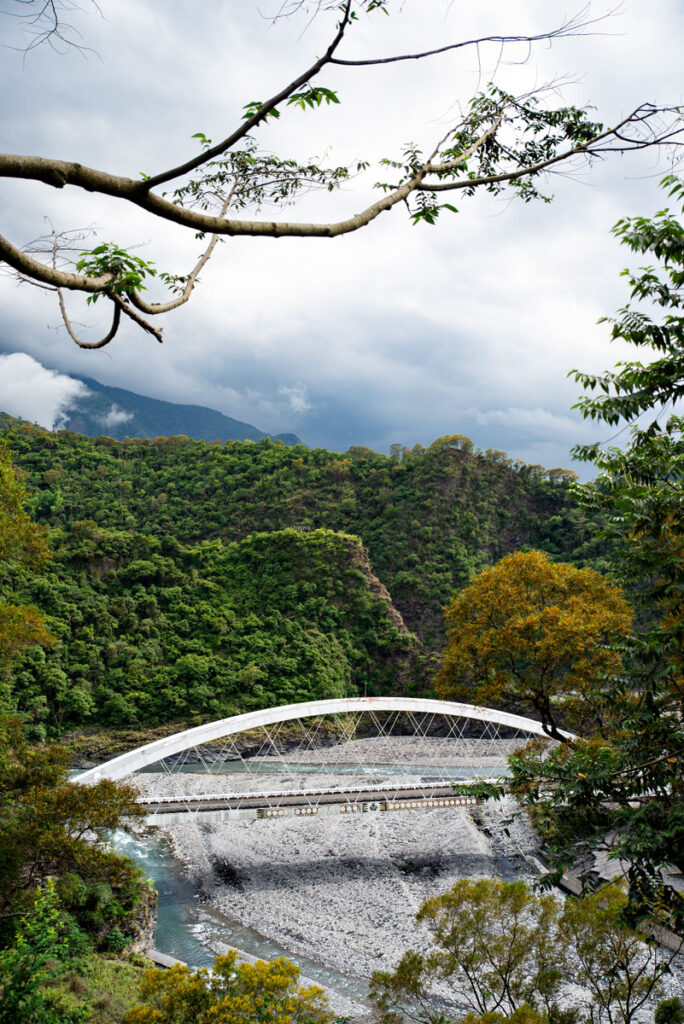
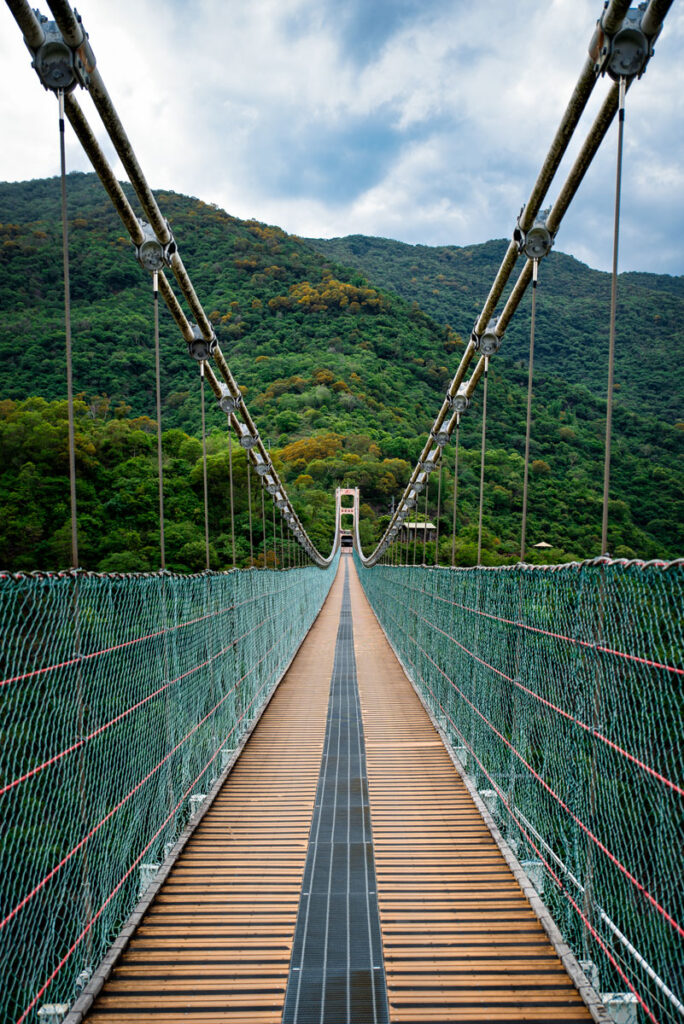
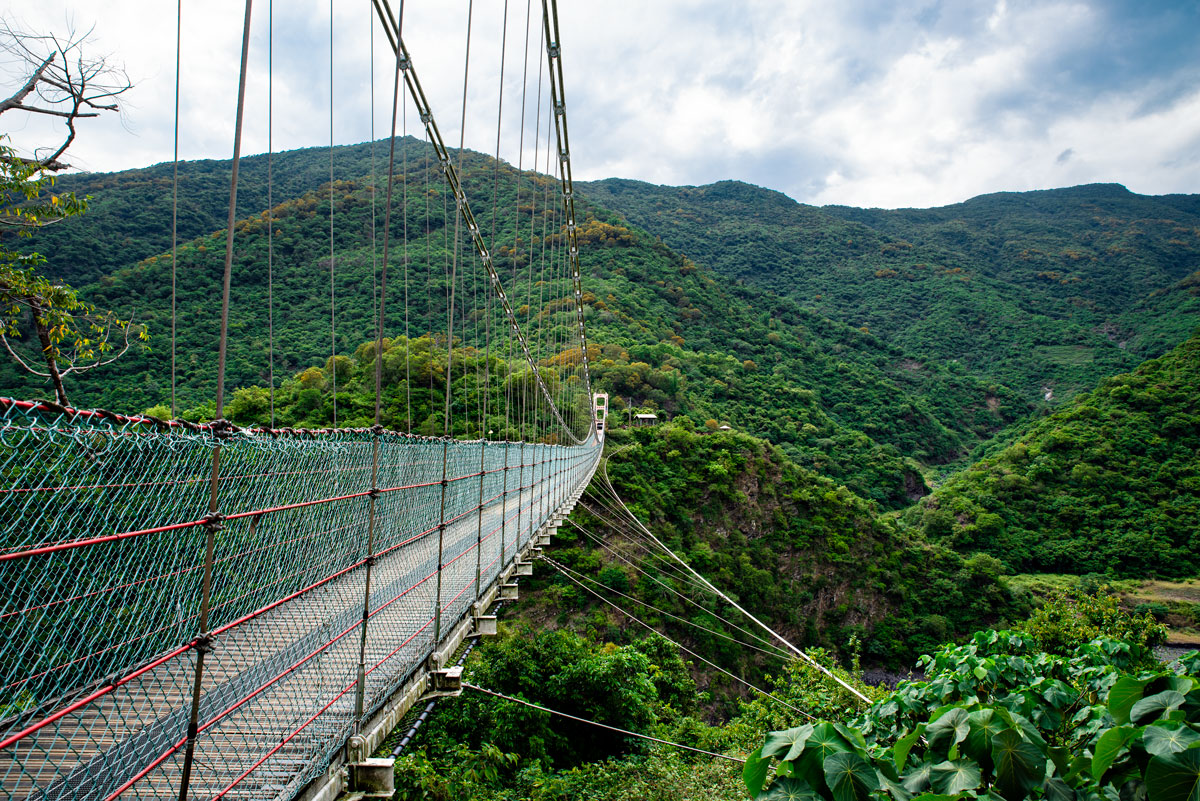
Our journey ends with another rainy day. We have arrived in Tainan, one of the oldest cities in Taiwan and the former capital. In Anping, we stroll through narrow alleyways. The Dutch East India Company once settled here. Fort Zeelandia still dominates the district today. Old trading houses and villas of wealthy merchants have survived the centuries in its shadow. Away from the northern causeway is a national park with rivers, ponds and mangrove landscapes. Mosquitoes buzz in the air. An overgrown bunker defies the weather.
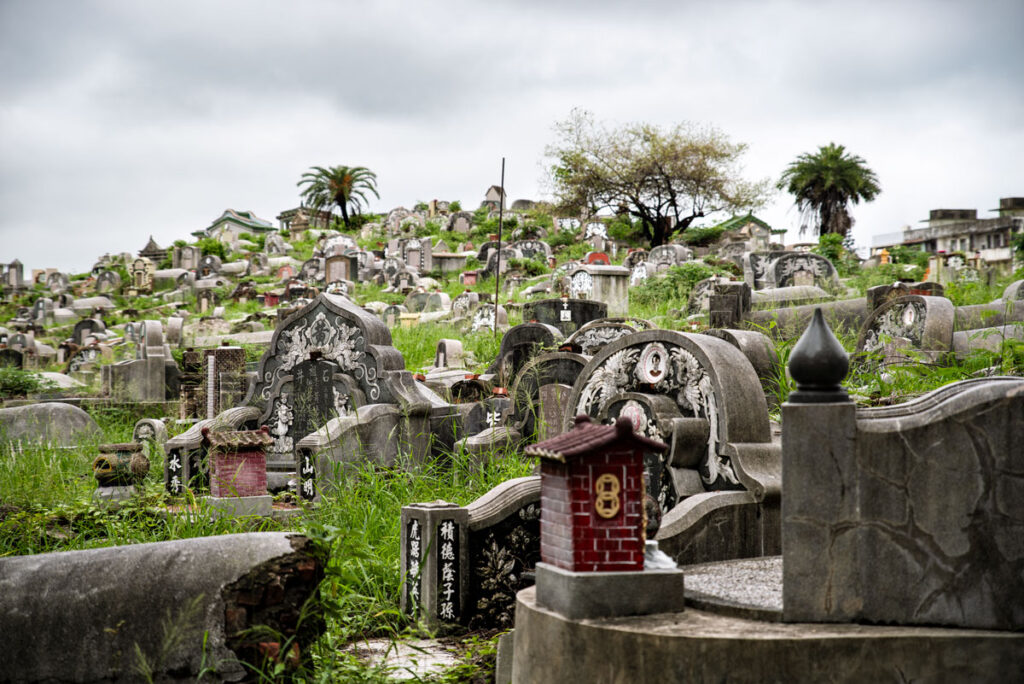
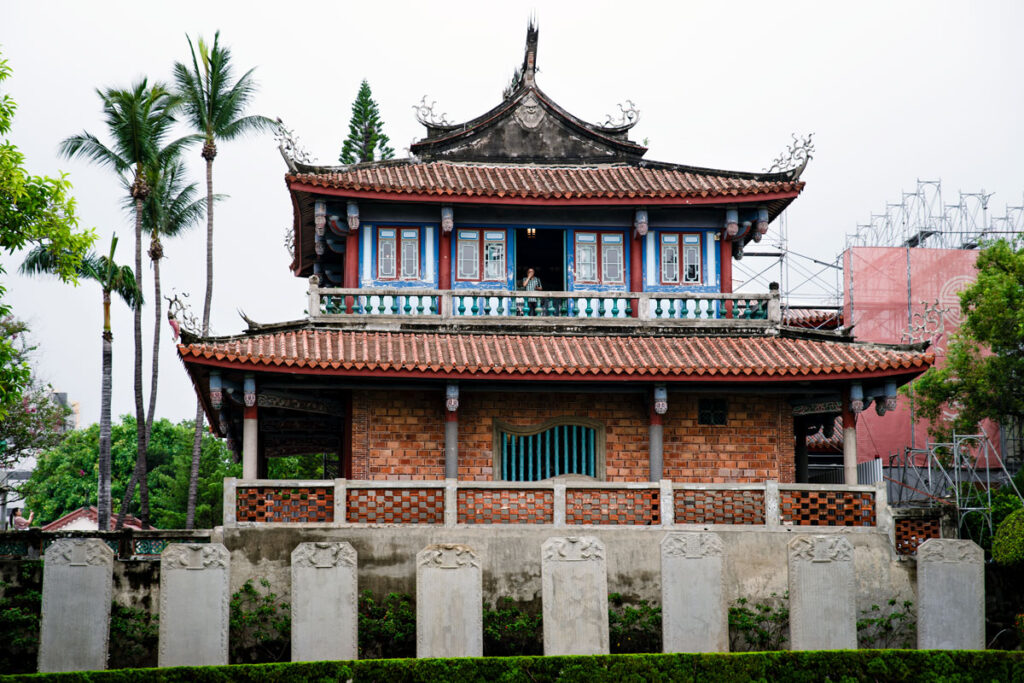
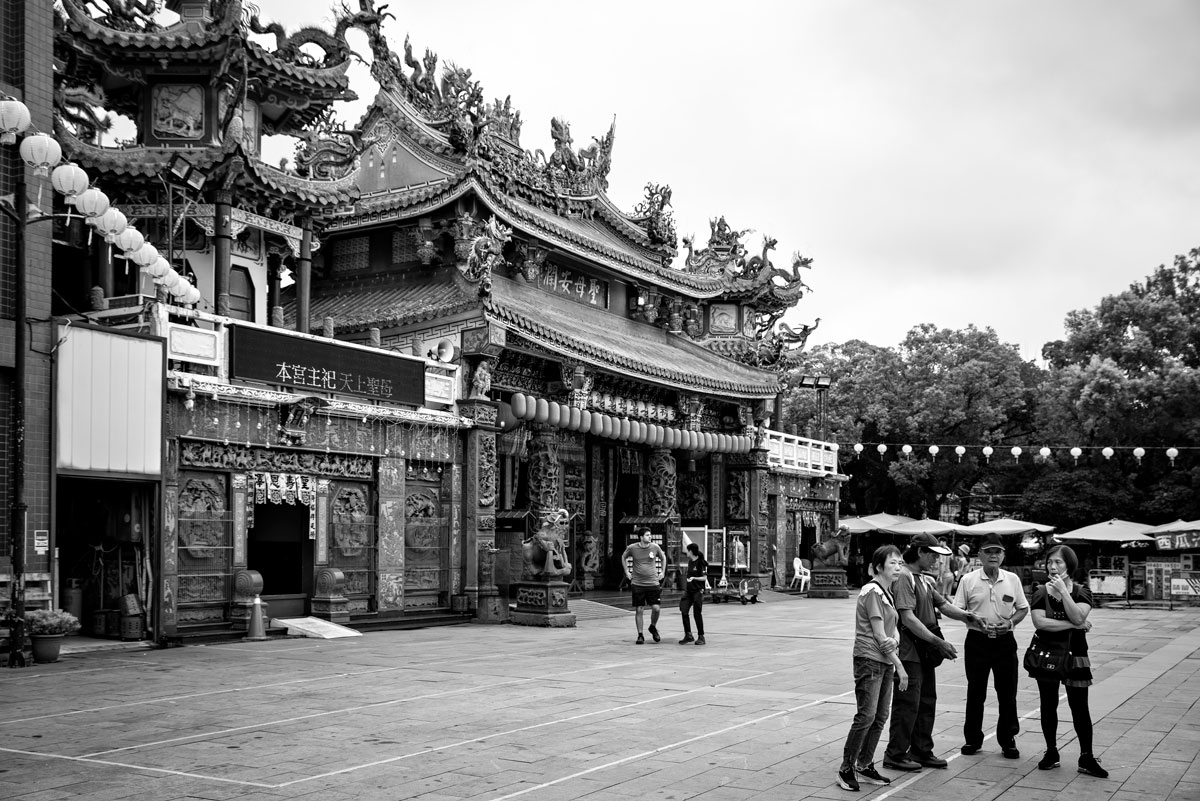
Another Dutch fortress – Fort Provintia – is also located in the center of Tainan, surrounded by Taoist temples. One of these temples is dedicated to the Chinese sea goddess Mazu. All those seeking love and soul mates make a pilgrimage to Yue Lao’s altar in a secluded chamber of the temple complex. We understand nothing of the rituals, the symbolism or the legends of the past. We only see the faithful who gather here full of hope, the big questions of life on their minds: health, wealth, love. Human existence can probably be broken down to the pursuit of these three concepts.
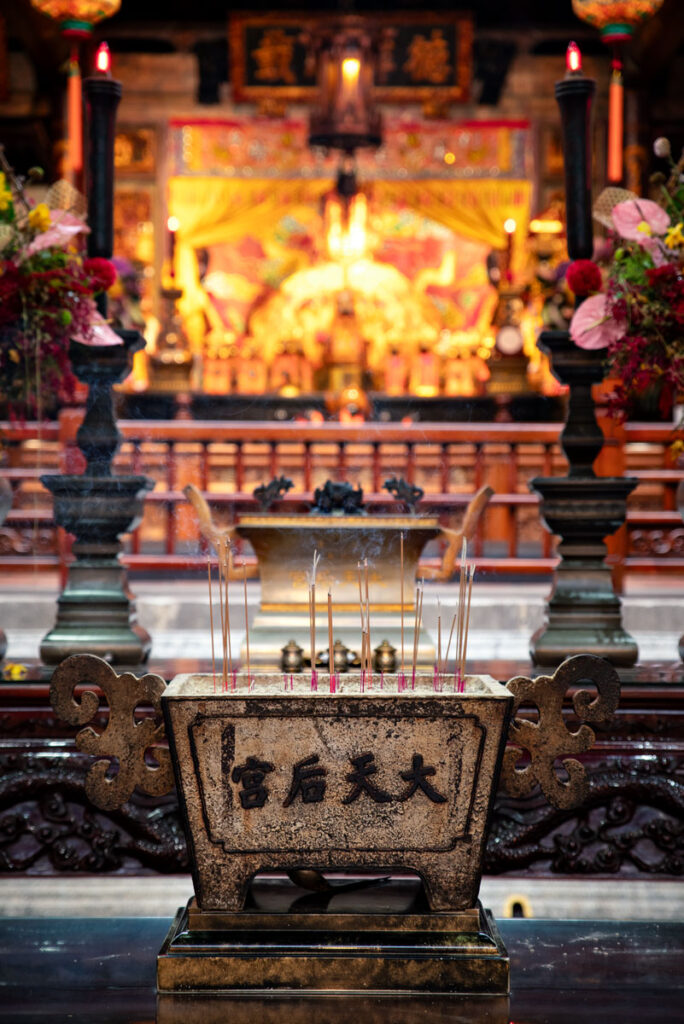
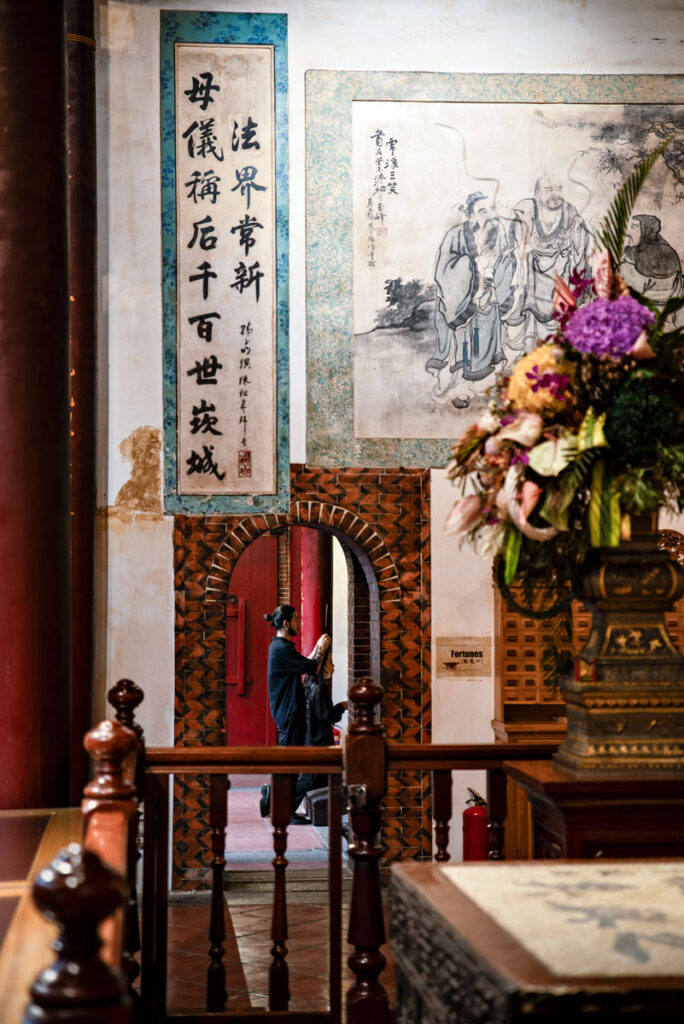
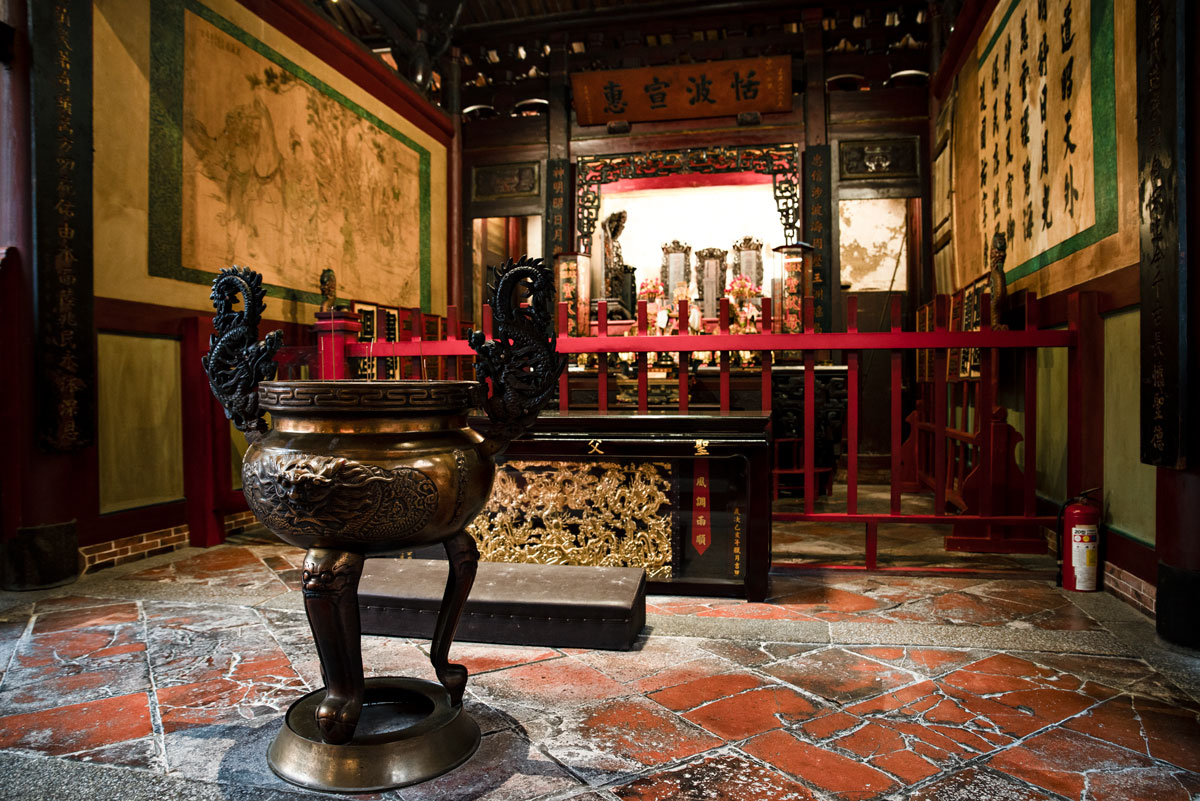
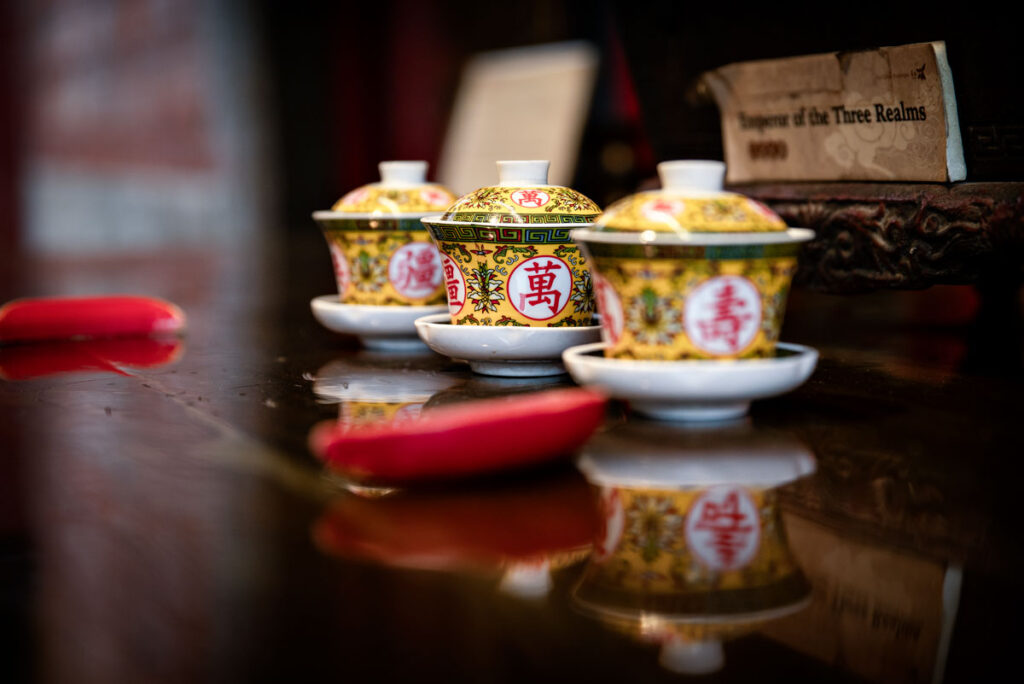
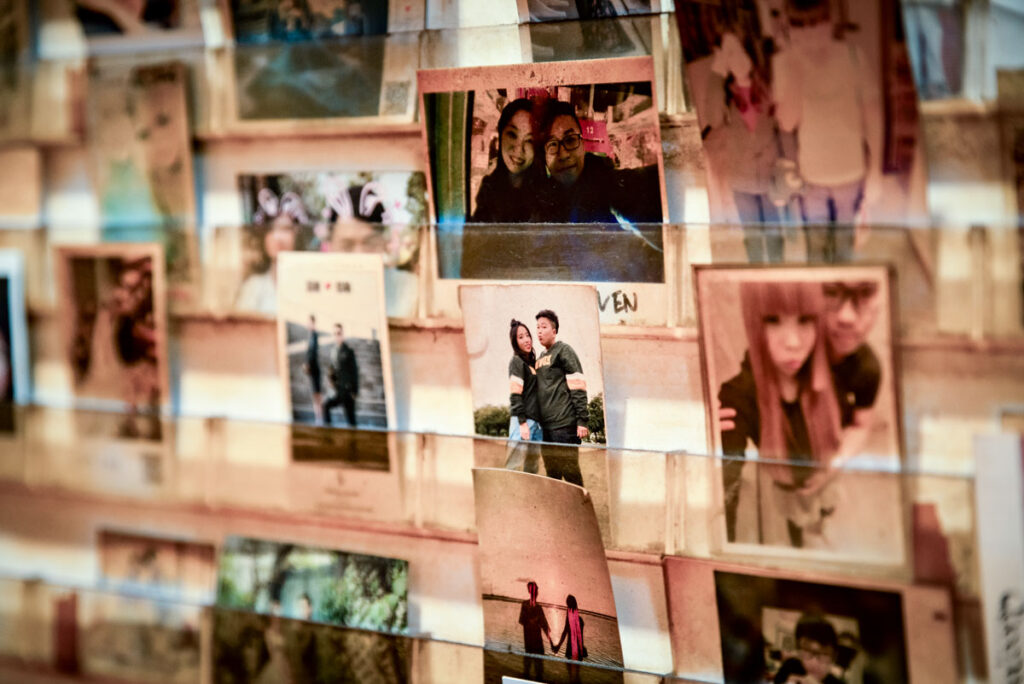
It is dawning. The sky is still clear, but in a few minutes thick drops will be pelting down on us. Advertising signs and lanterns light the way. A quick detour to Snail Alley, a look inside the historic Hayashi Department Store.
A little later, we stare out at the puddles and the rain. Night falls quickly in Taiwan. Tired faces sip noodle soup on wooden stools. TV screens show colorful commercials. Fans spin tirelessly. Taiwan is an Asian microcosm. So much culture in such a small space.
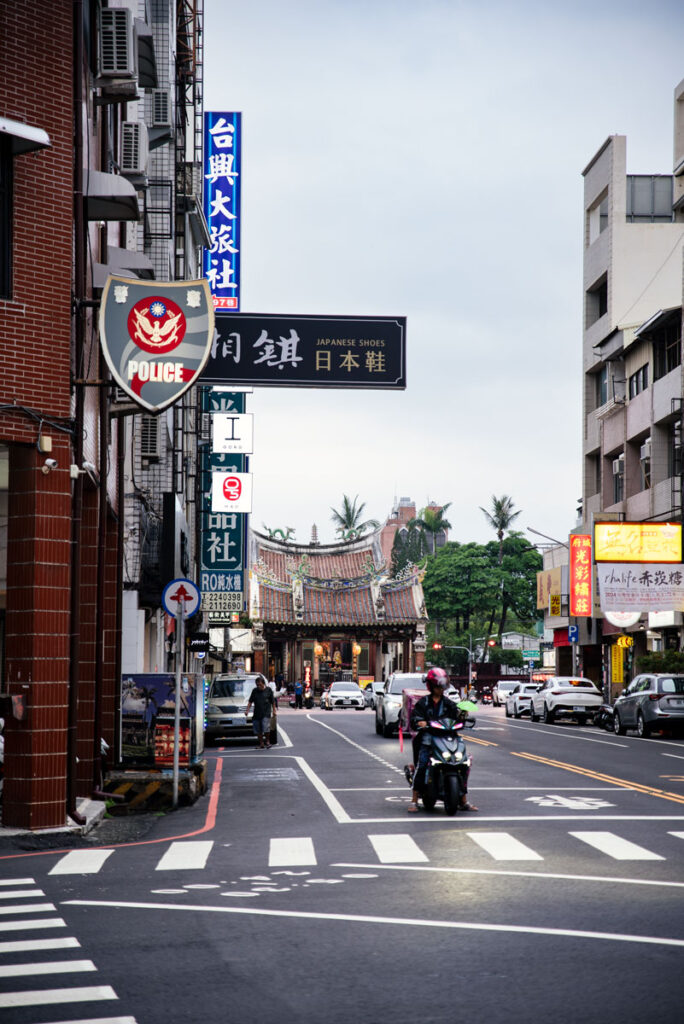
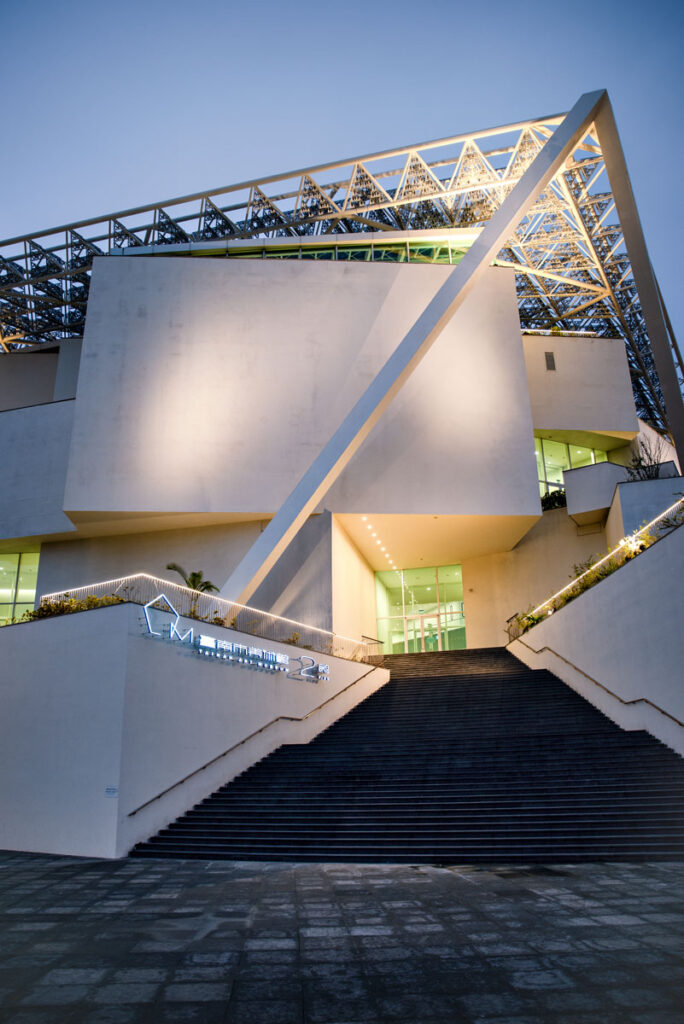
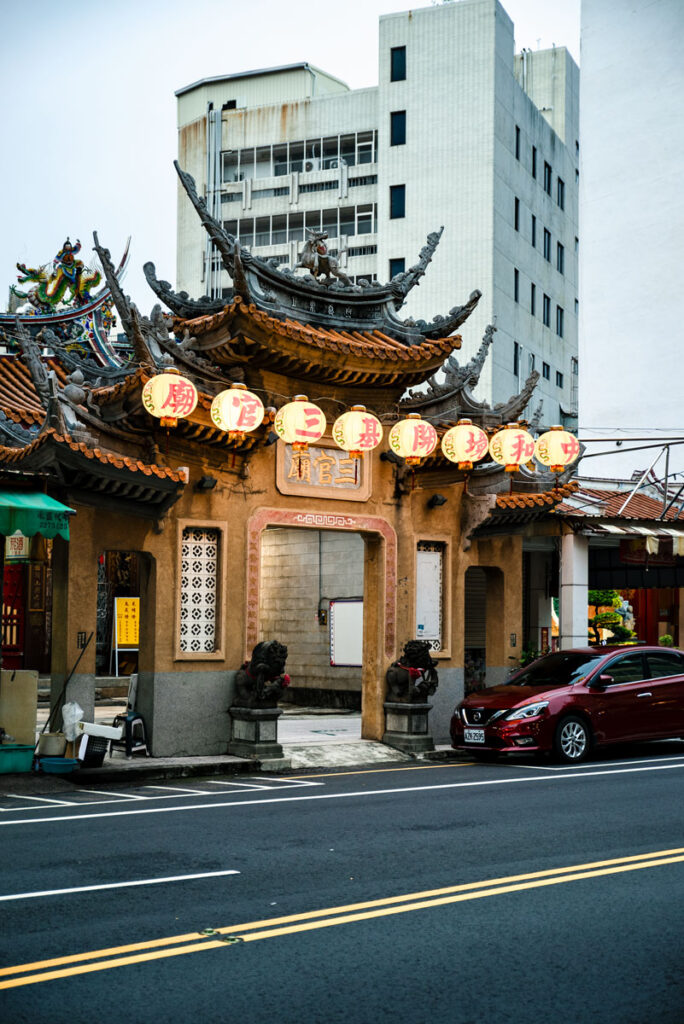
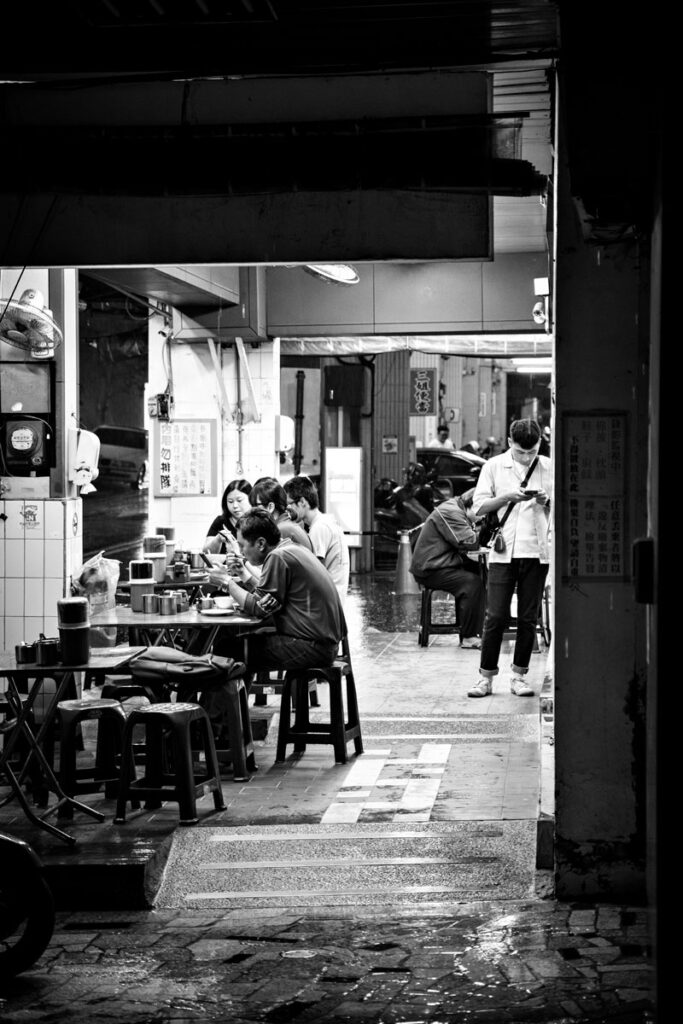
Around the island state of Taiwan in two weeks. The weather didn’t always cooperate. But we were all the more surprised by the open-mindedness of the Taiwanese and their pleasant, friendly and welcoming culture. When we drop off our rental car at the airport, the employee at the counter informs us that the toll for all highway trips has already been charged to our credit card. We had no parking tickets to pay. What incredible efficiency with which such traffic data is made available at lightning speed.
In the stuffy departure lounge, we remember the misty hills in the hinterland, the curved bridge on Sanxiantai Island, the cloudy Taipei 101, the acrid smoke of the temples, the crowded night markets, the tropical, spicy air of Kenting. Taiwan, we will be back.
Info about our trip
In general, very few Western tourists visit Taiwan – and if they do, it is usually only Taipei as a stopover to the actual vacation destination. The few Westerners we met were expats or exchange students. Taiwan is a popular travel destination for some of the surrounding Asian countries, such as the Philippines, because it is cheap. And for this and many other reasons, we were thrilled with Taiwan: even the most beautiful places were never overcrowded. We were able to immerse ourselves in the culture and were always welcomed in a very friendly and interested manner. There is excellent (vegetarian) food, the prices are relatively low, the infrastructure is excellent and Taiwan is generally a modern and socially highly developed country. In particular, traveling with a child could not have been more comfortable.
Taiwan is a very affordable travel destination for European standards, but somewhat more expensive compared to Southeast Asia. You can save a lot of money on food, while hotel accommodation is almost on a par with European prices, depending on the region and travel period. You can also get from A to B relatively cheaply, but here too the travel period can be decisive.
Taiwan offers you everything: from every imaginable regional cuisine to fusion dishes from all over the world. Chinese dishes such as Dim Sum and noodle soups are of course the most popular. If you want to eat reasonably priced, you will find suitable offers at the night markets or in small, modern noodle stores. Shabu shabu restaurants, which serve a kind of fondue in which vegetables, tofu and meat are cooked, are very popular. In Taitung, we discovered the Shabu-Restaurant 千葉火鍋-台東尊爵館,
where you can eat and drink as much as you like for less than 20 euros per person. There is also a huge selection for vegetarians!
Regarding the night markets, it should be said that you can find cheap and quite varied food there, but if you are looking for vegetarian dishes, the choice is rather limited and there is a lack of variety or you quickly end up with European classics (pizza, pasta, fish & chips).
Keyword vegetarian food: this actually works very well in Taiwan. In every city there was at least one very good restaurant that specialized in vegetarian or vegan dishes. The preparation of tofu in particular is master class here. We recommend the restaurant 美蔬齋 in Kaohsiung, which offers delicious curries. And if you want to try something different in Kaohsiung, then we recommend Pooja’s Indian Restaurant, which is also a real recommendation for vegetarians.
Although Taiwan has a lot to offer when it comes to food, we have to admit that 7-Eleven was one of the places we visited the most. When all the restaurants were already closed, there were no night markets, we passed one by chance on the way, our little man suddenly got hungry, we wanted to take a coffee break or … the list goes on. In short, we always found a snack and coffee at 7-Eleven (or lunch if necessary), and there was also yogurt and bananas for our son. The appeal of the 7-Eleven concept lies precisely in its nationwide omnipresence and the availability of virtually everything you could possibly need.
We found it difficult to find nice and not too expensive accommodations in Taiwan. The cheapest accommodation is usually of a poor standard, with tiny, windowless rooms and – if offered at all – only a simple breakfast (consisting of a white bread sandwich). If you are looking for better accommodations with good connections or a good location in the big cities, you will pay almost European prices – but you will get more than you would for the same price in Europe. Expect to pay 50 to 100 euros for one night. Great: Almost every accommodation had a laundry room with washing machines and dryers – completely free of charge. We can recommend the following hotels on our trip:
- Taipei: Hineon Hotel (close to the main station, good connections, clean rooms)
- Taitung: 門廷若室 ・ 河堤左岸館 (a little outside the city center, but also clean and originally furnished rooms)
- Kenting: Mamalulu (the nicest accommodation of our trip; located off the main road in the countryside, beautiful rooms, great breakfast and a pretty garden behind the house – the small hotel is run by a very nice family)
If you follow the news about Taiwan, you wouldn’t necessarily think of describing the island state as one of the safest countries in the world. In fact, the supposed “dangers” that await you in Taiwan should be properly classified.
Of course, there is always a latent threat from mainland China – China holds maneuvers off the island state at very regular intervals and the military presence in the country is omnipresent. Nevertheless, there have been no offensive clashes so far and it is impossible to predict whether this could happen in the short or long term. In our opinion, this poses no danger to tourists.
Native venomous animals such as snakes or spiders are more real. However, you are less likely to encounter them in the cities or tourist attractions, but rather in deserted areas or in the bushes. There are also natural hazards such as tsunamis and earthquakes. However, Taiwan has proven time and again in the past that it is well prepared for such disasters and has a good early warning system.
As far as everyday dangers are concerned, to which you are much more likely to be exposed as a tourist, we can give you the all-clear. The crime rate throughout Taiwan is negligible. There are hardly any thefts or robberies. We never felt threatened or unsafe for a minute. You will hardly find a safer country to travel to.
It is no exaggeration to say that Taiwan is the most child-friendly country we have ever visited. It starts with the people themselves, who were friendly and open-minded towards us and our little man and were very understanding when he wasn’t in such a good mood. We were also delighted with the infrastructure: every restaurant had highchairs and changing tables. Public toilets were available everywhere free of charge and were basically clean. In addition to changing rooms, there were often even nicely furnished breastfeeding rooms with a seating area, microwave and sink. In all the cities we visited, we found public parks, sports fields and beautiful playgrounds that were in perfect condition. There wasn’t just a slide and swings, but really unusual climbing frames, playscapes, ropeways, etc. Very often there was even play equipment specially designed for disabled children! Apart from that, every station and every staircase could be bypassed via ramps or elevators. In short, we didn’t expect so much inclusion and child-friendliness.
Taiwan is Asia and experience shows that you can easily get from A to B in Asia. As we were traveling with a child and also wanted to visit many sights away from the big cities, we wanted to be as flexible as possible and booked a rental car. The prices for this vary greatly depending on how early you book and in which travel period. On the other hand, it is possible to travel between the cities by bus or train and rent a scooter or car for individual excursions. The rail network on the west coast in particular is very well developed and you can take the high-speed train from Taipei to Kaohsiung in the south in just a few hours. It doesn’t cost much and is comfortable. Of course, you can also join a guided tour.
We recommend that you buy a public transportation card. You can use it on the metro and bus in all Taiwanese cities and recharge it at all stops.
Another curious fact if you are traveling by car: every city has a slightly different payment system for parking fees. However, we usually found that you simply park your car in a designated area. A parking attendant comes by at regular intervals and sticks a note on your windshield on his first round. Every time he passes your car again (i.e. every half hour or so), you will receive a ticket and have to pay more. And you can do this – like almost everything in Taiwan – in a 7-Eleven. Nationwide.
- For general preparation, we read the Gebrauchsanweisung für Taiwan: Faszinierender Reiseführer zur Identität und Geschichte der grünen Insel by Stephan Thome
- Stephan Thome has also written several novels set in Taiwan – we really liked Pflaumenregen
- In our luggage we had the POLYGLOTT on tour Reiseführer Taiwan
